FRANKLIN, Tenn.—The 2022 Civil War show season came to a close at 3 p.m. on December 4th as the 35th annual Middle Tennessee Civil War Show ended. It was a great way to finish up the year, according to show promoter Mike Kent, with basically the same size event as in previous years. This is a positive sign for the overall health of the Civil War collecting community. There are also new, younger dealers and participants appearing as some older collectors retire or slow down.
As usual, dealers were spotted in the local host hotel Thursday evening trading stories and getting ready for move in on Friday morning. Vendor automobile tags from as far away as Texas, New York, Ohio, and Florida were seen as dealers unloaded for the year’s final show. Facility manager Kenny Wallace reported that some vendors were already in the parking lot when he arrived at 5:30 Friday morning even though the official set up time
35th Annual Franklin Civil War Show The Largest Civil War Show Under One Roof!
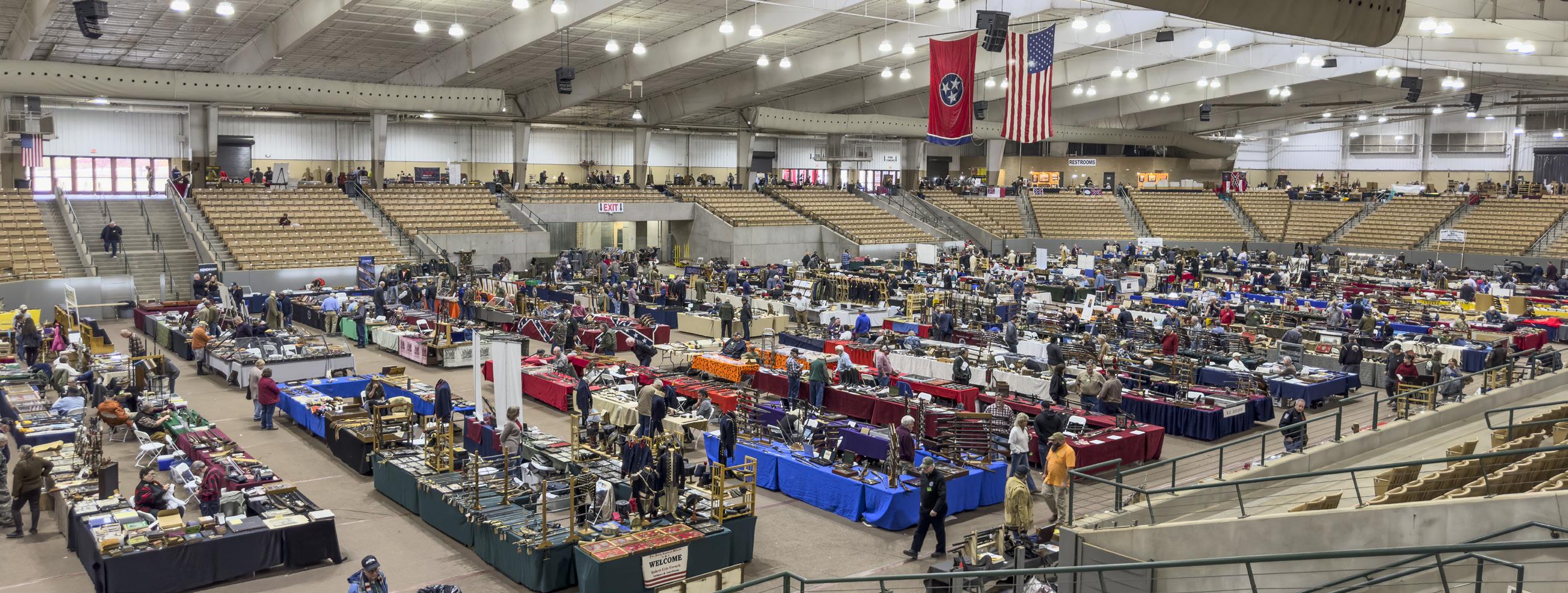
was not until 10 a.m. With mild temperatures and only scattered showers on Friday, the weather was ideal; by closing time at 7 p.m., all but a few tables were filled.
Anticipation was high as people packed the lobby, then quickly flooded the arena floor, catching up with old friends, looking for the best deals and fresh material from vendors. Traffic was brisk all day and social media was abuzz with photos of dealers and attendees posing with old friends and new finds for their personal collections and inventory.
Representatives from the Outdoor Channel program Shooting USA were on hand Saturday to interview dealers about their participation in the show, their most interesting firearms, and ideas on attracting a younger crowd to the shows and collecting hobby. Brian Akins, Rafael Eledge, and promoter Mike Kent were featured and should appear on an upcoming edition of Shooting USA.
Well known Civil War dealer Larry Hicklen was honored with a special Lifetime Achievement Award that recognized his dedication and contributions to the Civil War community


over the last 35 years. Hicklen is the founder and owner of the Middle Tennessee Civil War Show, nurtured it through its first few years, then turned over management to Mike Kent in 1991. As many long-time participants remember, the show started with only 100 tables in the Vaughn Building at the Tennessee State Fairgrounds in 1986, moved to the Williamson County Ag Expo Park in 2010, growing to over 800 tables in the process, making it one of the
largest events of its type in the country. No show would be complete without displays, many of which represent lifelong efforts to find, document, label, and organize material for public presentation; the Franklin Show is no different. For many dealers it is a labor of love as there is no monetary compensation for the time and effort required to put on a display. In fact, just the opposite is true; travel and show expenses easily run into hundreds of dollars per
show. For these special people however, their reward comes from the respect, admiration, and appreciation expressed by fellow collectors and the public when viewing their exhibits.
Nashville native and wellknown Civil War artist John Paul Strain was on hand as always, hosted by Debi and Kent Robinson of DK Prints. Strain has become a Middle Tennessee Civil War Show mainstay as he is a popular celebrity, always shaking hands and greeting visitors while often working on his latest projects.
Porter’s Battery was on hand again this year, although down by two guns as the flu took its toll on several crew members. To make up for the loss of guns however, the battery fired more shots every hour to keep the momentum going; the public loved it as always!
Make plans now to attend Mike Kent’s Chickamauga Civil War Show on February 4 & 5, 2023, in Dalton, Ga., and next year’s Franklin Civil War Show scheduled for Dec. 2 & 3, 2023. For more information, visit MKShows.com.

Vol. 49, No. 1 48 Pages, January 2023 $4.00 America’s Monthly Newspaper For Civil War Enthusiasts 22– American Battlefield Trust 42 – Book Reviews 20 – Central Virginia Battlefield Trust 32 – Critic’s Corner 34 – Emerging Civil War 45 – Events 36 – The Graphic War 30 – The Source 24 – Through the Lens 26– This And That 18 – The Unfinished Fight H Franklin . . . . . . . . . . . . see page 4
Award winners L to R: Bill Combs, Gene Andrews, J.T. Leathers, Mel Hankla, Gerald Roxbury, Dave Gotter, Michael Briggs, Mary Watkins, Greg Murry, and Larry Hicklen.
Minutes before the show opened, with dealers headed to their tables. All tables were filled for the 2022 Franklin Show.
Civil War News
Published by Historical Publications LLC
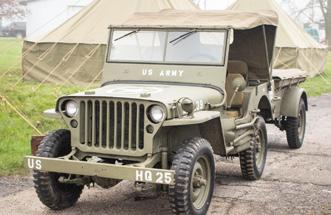
520 Folly Road, Suite 25-379, Charleston, SC 29412 800-777-1862 • Facebook.com/CivilWarNews
mail@civilwarnews.com • civilwarnews.com
Advertising: 800-777-1862 • ads@civilwarnews.com
Jack W. Melton Jr. C. Peter & Kathryn Jorgensen
Publisher Founding Publishers

Editor: Lawrence E. Babits, Ph.D.
Advertising, Marketing & Assistant Editor: Peggy Melton
Columnists: Craig Barry, Salvatore Cilella, Stephen Davis, Stephanie Hagiwara, Gould Hagler, Chris Mackowski, Tim Prince, John Sexton, and Michael K. Shaffer
Editorial & Photography Staff: Greg Biggs, Curt Fields, Michael Kent, Shannon Pritchard, Leon Reed, Bob Ruegsegger, Carl Sell Jr., Gregory L. Wade, Joan Wenner, J.D.
Civil War News (ISSN: 1053-1181) Copyright © 2023 by Historical Publications LLC is published 12 times per year by Historical Publications LLC, 520 Folly Road, Suite 25 PMB 379, Charleston, SC 29412. Monthly. Business and Editorial Offices: 520 Folly Road, Suite 25 PMB 379, Charleston, SC 29412, Accounting and Circulation
Offices: Historical Publications LLC, 520 Folly Road, Suite 25 PMB 379, Charleston, SC 29412. Call 800-777-1862 to subscribe. Periodicals postage paid at U.S.P.S. 131 W. High St., Jefferson City, MO 65101.
POSTMASTER: Send address changes to: Historical Publications LLC 520 Folly Road Suite 25 PMB 379 Charleston, SC 29412
Display advertising rates and media kit on request. The Civil War News is for your reading enjoyment. The views and opinions expressed herein are those of its authors, readers and advertisers and they do not necessarily reflect the official policy or position of Historical Publications, LLC, its owners and/or employees.
P UBLISHERS :

Please send your book(s) for review to: Civil War News
520 Folly Road, Suite 25 PMB 379 Charleston, SC 29412
Email cover image to bookreviews@civilwarnews.com. Civil War News cannot assure that unsolicited books will be assigned for review. Email bookreviews@civilwarnews.com for eligibility before mailing.





ADVERTISING INFO:
Email us at ads@civilwarnews.com
Call 800-777-1862
MOVING?
Contact us to change your address so you don’t miss a single issue. mail@civilwarnews.com • 800-777-1862
U.S.

SUBSCRIPTION RATES
Publisher’s Note:
In the current world of supply chain issues and prices going through the roof at every turn, we are diligently looking at ways to keep our costs down while continuing to provide excellent products and services to our subscribers and advertisers. We have made a few changes this year to be more streamlined and efficient, keeping costs down.
We hope you have had a chance to view our improved website, HistoricalPublicationsLLC.com.
Renewals: The barcode on the letters allows us to use a scanner to pull up your accounts automatically for easier renewal access. The downside is that they mail renewal letters automatically on the first day of each month to any subscriber who has not been renewed in the system. Please send in your renewals as soon as possible to avoid receiving a duplicate.
If you are a current subscriber with your email on file with us and want to sign up, go to CivilWarNews.com, which will redirect you to our main website: HistoricalPublicationsLLC.com.


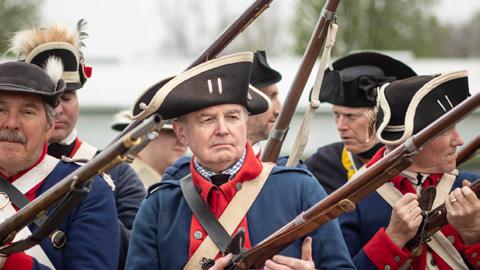

2 CivilWarNews.com January 2023 2 January 2023 CivilWarNews.com
Subscription rates are $41/year, digital only $29.95/year, add digital to paper subscription for only $10/year more. Subscribe securely at CivilWarNews.com
Annual Ohio Civil War Show Including WWI & II 30th Annual Artillery Show Military Material From 1775 Through 1945 Saturday May 6th – Sunday May 7th 2023 Sat. 9:00 – 5:00 | Sun. 9:00 – 3:00 Richland County Fairgrounds, Mansfield, Ohio Location: US-30 and Trimble Road 800 Tables of Military Items, Books, Prints and More For Buy, Sell, Trade & Display ~ SPECIAL FEATURES ~ Cannon Firing & Infantry Demonstrations Civil War & WWII Encampments • Period Church Service WWII 801st Med Air Evac Educational Presentation • Sutler’s Row Camp Chase Fife & Drum & 73rd OVI Regimental Band Gettysburg Address Presented by President Lincoln Marlboro Volunteers Traveling Museum & Military Vehicles ~ ~ ~ ~ ~ $7 Admission (includes parking) – Under 12 FREE Handicap Facilities, Food Trucks and Cafeteria www.ohiocivilwarshow.com | For Information Call: 419-884-2194 Facebook: Ohio Civil War Show Ohio Civil War Show, LLC January 7-8, 2023 Omar Shrine Temple 176 Patriots Point Rd. Mt Pleasant, SC LOWCOUNTRY ANTIQUE MILITARIA & AMERICANA SHOW Camp Jordan Arena 323 Camp Jordan Pkwy. East Ridge, TN July 22-23, 2023 CHATTANOOGA ANTIQUE MILITARIA & AMERICANA SHOW American Digger® magazine now has TWO great shows each year! For information: Call (770) 362-8671 or (716) 574-0465 Email: anita@ americandigger.com Both shows Open to Public: Saturday: 9-5 Sunday: 9-3 Dealer Setup: Friday 1-7 PM Sat 7-9 AM americandigger.com/american-digger-events/ • Swords & Knives • Antique Firearms • Dug & Non-dug Relics • Civilian Items & Jewelry • Bottles & Stone Artifacts • Art, Photos, & Books • Militaria & Americana • All Eras to WWII • Metal Detectors • Awards & Prizes this and more: Display!Trade! Buy!Sell!
45th










Mike Kent & Associates, LLC • PO Box 685 • Monroe, GA 30655 770-630-7296 • Mike@MKShows.com • www.MKShows.com Military Collectible & Gun & Knife Shows Presents The Finest Williamson County Ag Expo Park 4215 Long Lane Franklin, TN 37064 Dec. 2 & 3, 2023 Middle TN (Franklin) Civil War Show Promoters of Quality Shows for Shooters, Collectors, Civil War and Militaria Enthusiasts Exchange Park Fairgrounds 9850 Highway 78 Ladson, SC 29456
25
26, 2023 Charleston Gun & Knife Show
Center
Feb.
&
Myrtle Beach Convention
2101 North Oak Street Myrtle Beach, SC 29579
& Knife Show
Center
Asheville Gun &
Show
Feb. 18 & 19, 2023 Myrtle Beach Gun
WNC Ag
1301 Fanning Bridge Road Fletcher, NC Jan. 7 & 8, 2023
Knife
Dalton Convention Center 2211 Tony Ingle Parkway Dalton, GA 30720
Chickamaugua “Dalton” Civil War Show
Feb. 4 & 5, 2023
H Franklin. . . . . . . . . . from page 1
Listed below are the 2022 award winners.
Historical Significance Awards
Bill Combs – The Spanish Colonial Army
Michael Briggs – Guilford County, N.C., Gunmakers






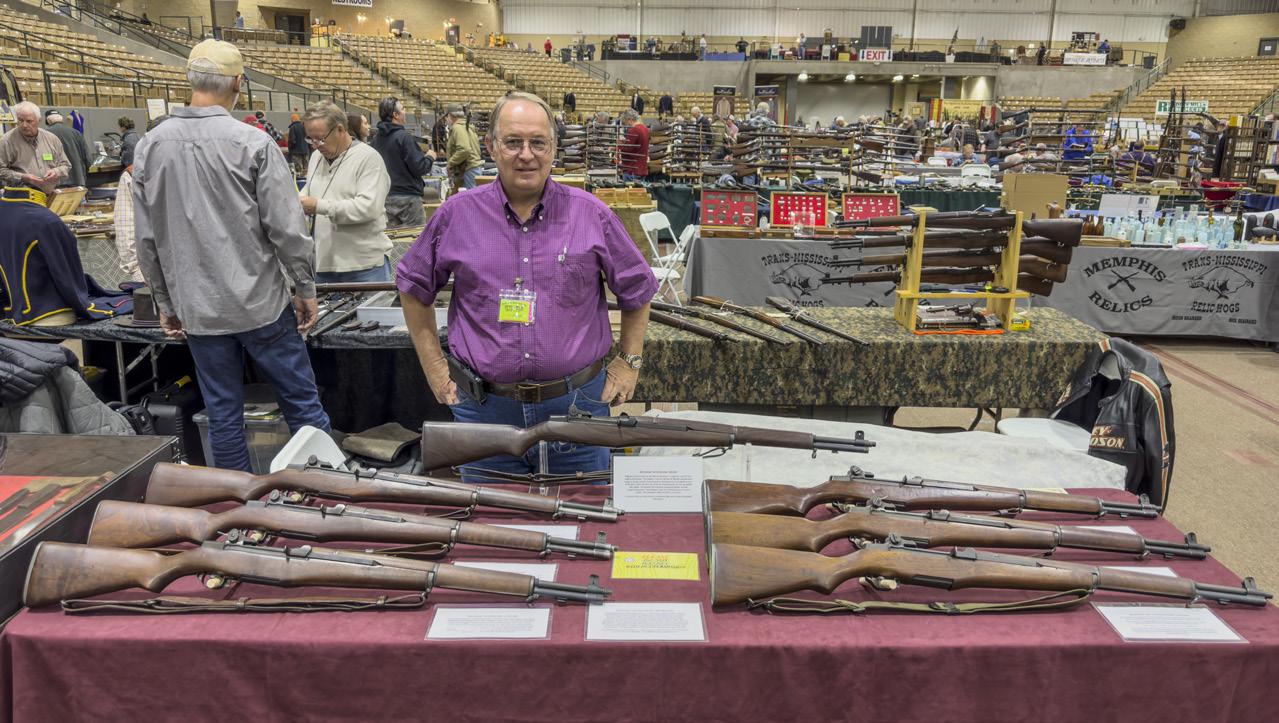
Gerald Roxbury – 1852 Pattern Naval Officer’s Swords
Gene Andrews – Miniature Confederate Soldiers
People’s Choice Award
J.T. Leathers – M1 Garand Variations
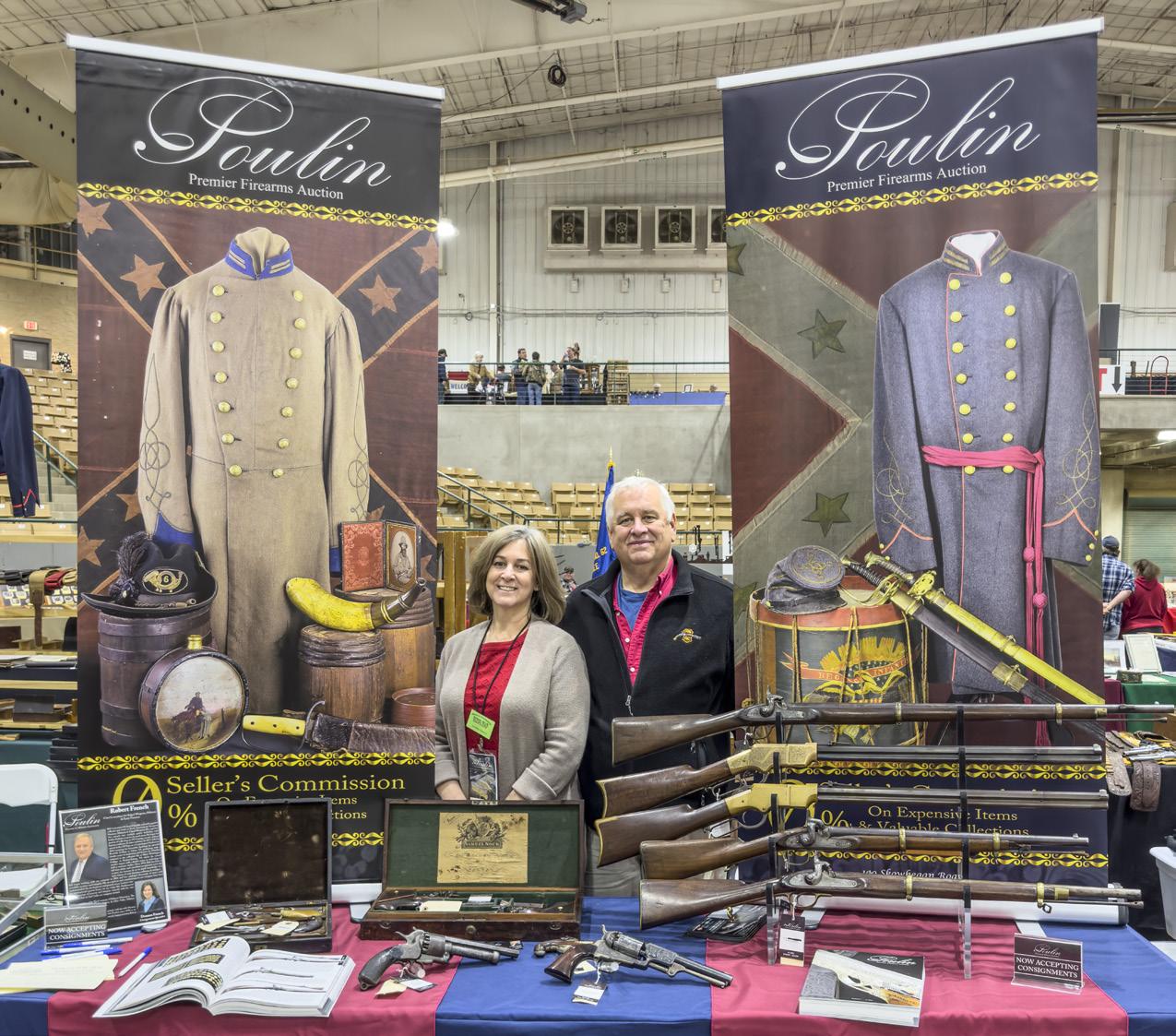
Chairman’s Award
Dave Gotter – Evolution of the Winchester Rifle 1866–1894

Best Weapon Award
Greg Murry and Mary Watkins – The Crockett Rifle
Best of Show Award
Mel Hankla – Mastery of Metals in the Cumberland

4 CivilWarNews.com January 2023 4 January 2023 CivilWarNews.com
J.T. Leathers with his M1 Garand display which won the People’s Choice Award.
Gerald Roxbury with his display of 1852 Pattern Naval Officer’s Swords.
Bill Combs brought out his fantastic display of Spanish Colonial Army artifacts.
Long time relic hunters Bill Gurley and Meigs Brainard with their treasures.
Author and collector Michael Briggs with his display of Guilford County, N.C., gunmakers.
Gene Andrews explaining how he handcrafted his miniature Confederate soldier display.
Deanna and Bob French looking professional as always while representing Poulin Auctions at the show
Mel Hankla’s Best of Show display, “The Rifles of Jacob Young and John Wilson.”
Mike Kent (left) and show founder Larry Hicklen with his Lifetime Achievement Award.
Long time book dealer Mike Wadsworth came out of retirement to attend the Franklin Show.
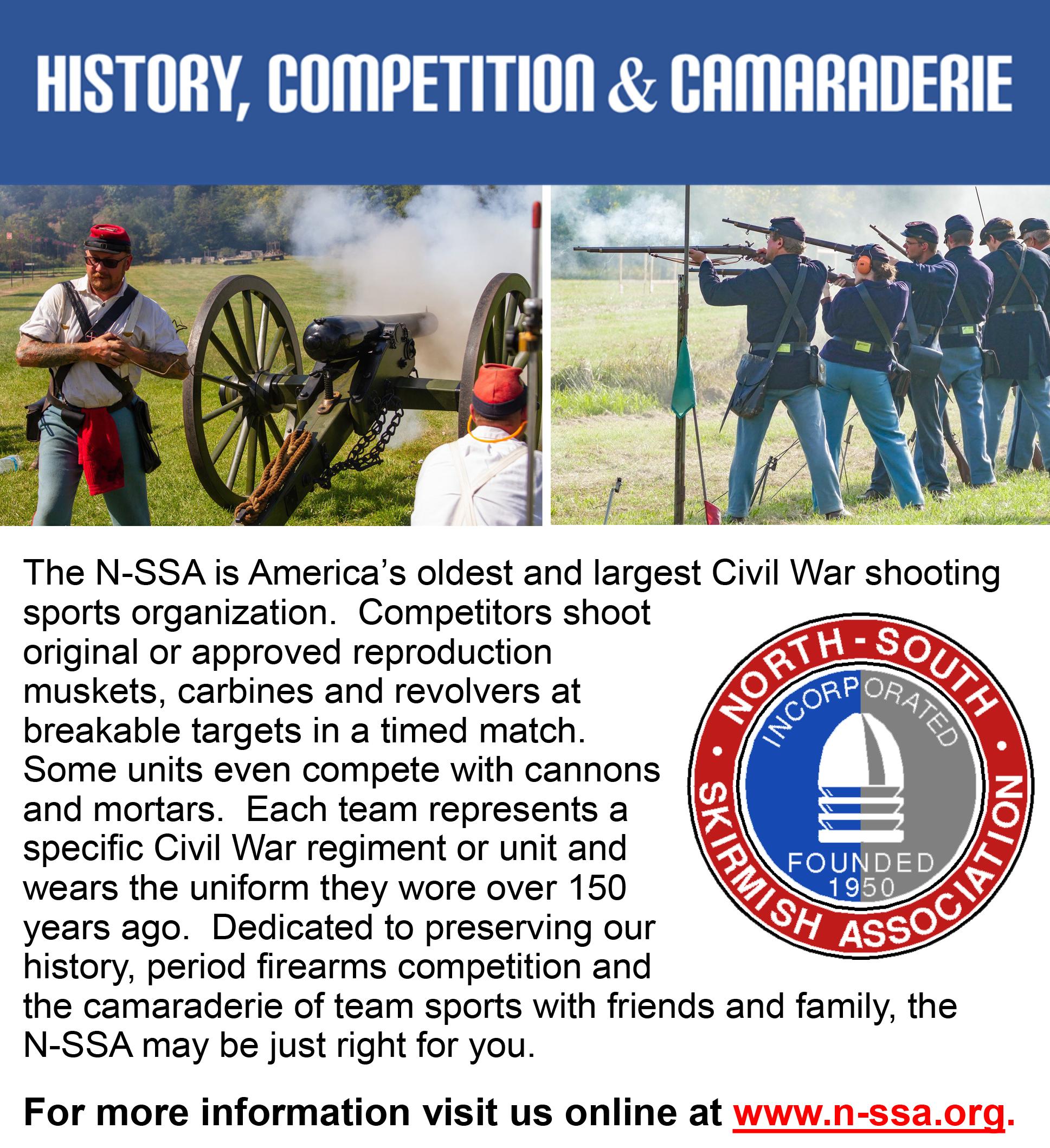
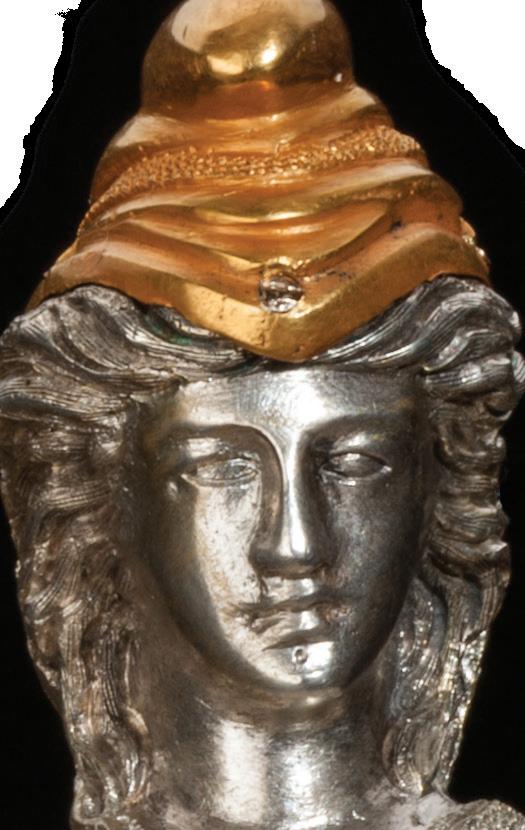
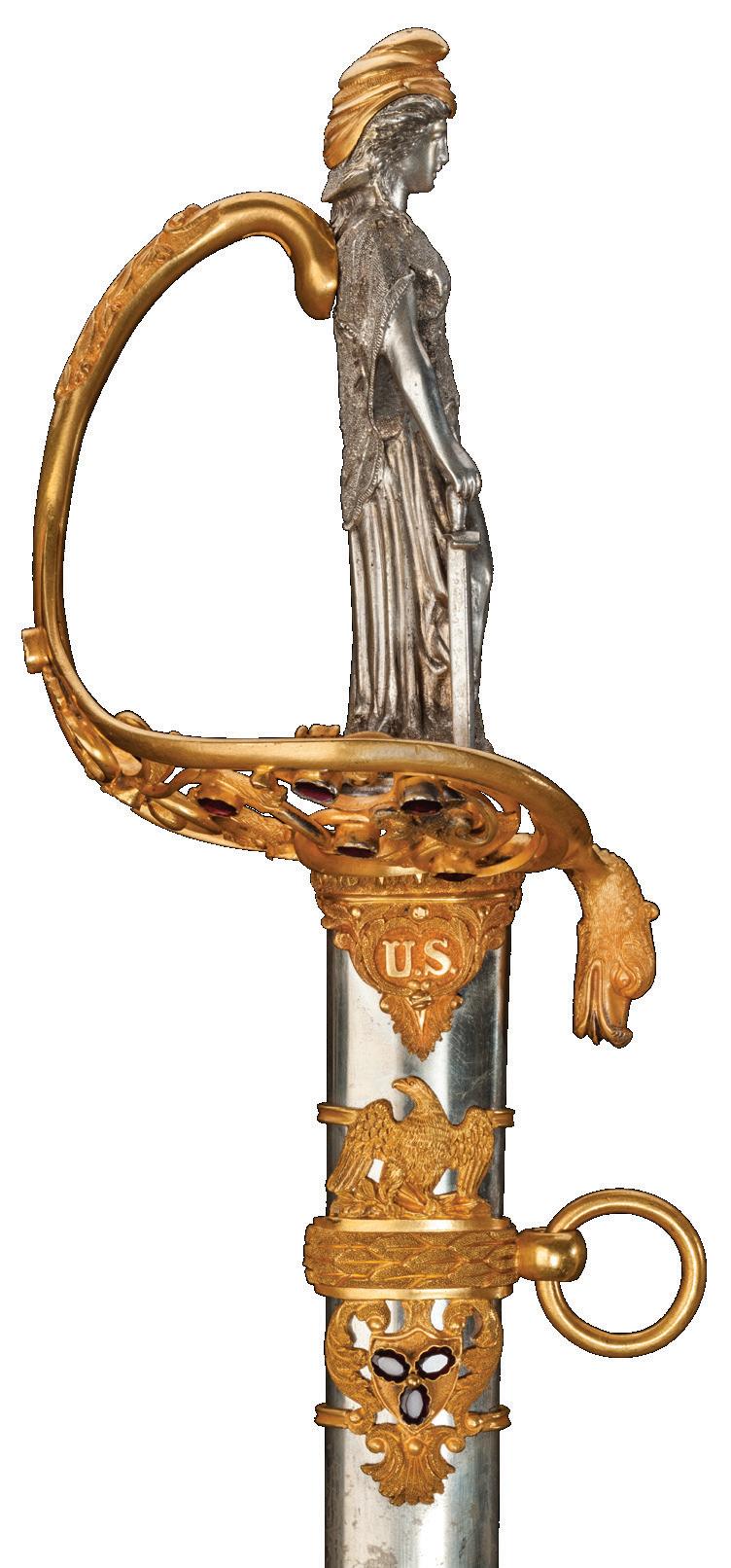








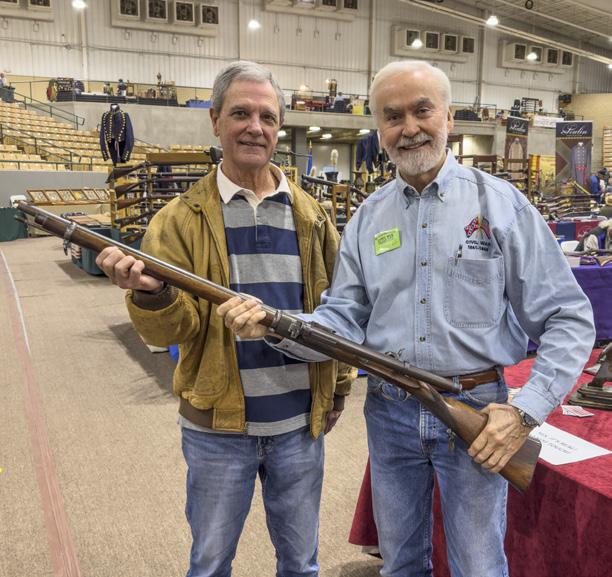

5 January 2023 5 January 2023 CivilWarNews.com CivilWarNews.com Buying and Selling The Finest in Americana 11311 S. Indian River Dr. • Fort Pierce, Florida 34982 770-329-4985 • gwjuno@aol.com George Weller Juno
Dave Gotter, the Chairman’s Award winner with his Evolution of the Winchester Rifle display.
Bill Blackman and Kenny Copelin with two of the most complete Confederate buckle collections in existence.
George Susat with “History You Can Hold.”
Civil War Navy Magazine publisher Charles Williams.
Greg Murry and Mary Watkins with their Crockett rifle display.
Promoter Mike Kent and Joe Fitzgerald holding his Whitworth rifle with telescopic sight valued at $175,000.
Long time Franklin Show participant Mike Hogle.
by Leon Reed GETTYSBURG, Pa.—A collection of Gettysburg royalty: Park Superintendent Steve Sims, Gettysburg College President Robert Iuliano, Gettysburg Foundation President Wayne Motts, Lincoln Fellowship President the Reverend Steve Herr, and Gettysburg Forum chair Harold Holzer, together with superstar historians John Meacham and Dr. Allen Guelzo, gathered in the National Cemetery
on November 19 to celebrate the 159th anniversary of Lincoln’s Gettysburg Address.
Dedication Day in Gettysburg
The event took place at the Rostrum and was attended by several hundred people, many of whom arrived an hour or more before the ceremony started.

Gettysburg was hit by a cold snap, but the weather on the 19th was in the upper 30s and sunny. Mercifully, the wind, which put on a real show the next day, was relatively still on Saturday.
The Dedication Day ceremony is one of Gettysburg’s most durable traditions, dating back to 1938. Past speakers have included presidents Truman and Eisenhower, Supreme Court




justices Scalia and O’Connor, authors Carl Sandberg, Shelby Foote, Gary Gallagher, and TV and film personalities Ken Burns, Stephen Spielberg, LeVar Burton.
The ceremony started with a wreath laying at the Soldiers National Monument with musical accompaniment by the Federal City Brass Band. The wreath laying featured historical comments by Ranger Christopher Gwinn, chief of interpretation and education for Gettysburg National Military Park.
The event continued at the Rostrum. In brief remarks, Sims commented that “national cemeteries have a protected atmosphere of peace, calm, and reflection. We ensure the dignity of the final resting place of those who gave their lives for their country.” Motts commented that “Each soldier who died here has a story and we should not ever forget those stories...Their sacrifice had meaning and continues to have meaning.” Iuliano noted with pride that the college community has been involved since the first day of the battle. “On July 1, 1863, our college stood in the midst of two armies’ great battle. After the battle, our alumnus, David Wills invited the president to come make ‘a few appropriate remarks’ and “our students and faculty walked to the square and walked with the president for the ceremony.”
In his featured presentation, Guelzo extolled Lincoln’s speech and pointed to its present day relevance. “In 272 terse and simple words, he laid out the past (‘four score and seven years ago, our fathers brought forth…’), present (‘now we are engaged in a great civil war…’), and future (“we here highly resolve…’), and it was a sensation from the beginning.” He went on to note that Lincoln also “laid out three fundamental elements of a democracy: consent (‘government of the people’),... people’s voice in the affairs of the nation (‘by the people’),... and that a government serves the interests of the people (‘for the people’)...Without these three distinctions, you have no democracy.”
“Lincoln’s address was a huge consecrated essay on why the American democracy had been founded, why it was worth sacrificing to preserve, and what
we could anticipate if it emerged whole from the conflict. It would be a ‘new birth of freedom.’”
“But we today are not sure that we are equal to the task of preserving democracy...We here hold the power and bear the responsibility...Lincoln reminded us that it is we who must dedicate ourselves, we who must highly resolve, we who must decide if a democracy can survive the forces that despise it.”
In brief remarks before he recited the Gettysburg Address, Meacham observed that “Lincoln kept the American experiment in self-government alive when all seemed lost...Ordinary people black and white, sacrificed to preserve the Union...Many of those are buried here. We are here to commemorate their deeds. We pray for the repose of their souls and the strength to be worthy of their sacrifices and to be worthy stewards as well of Lincoln’s ultimate vision of the nation that the Declaration of Independence must be paramount and that democracy must survive and thrive...Abraham Lincoln and the honored dead of this place have shown us the way...making that is the unlimitable work of our times.”
An especially moving part of the
elebration was the naturalization ceremony for 16 brand new U.S. citizens, symbolizing Lincoln’s position as the 16th president. The new citizens were a literal United Nations, coming from Bhutan, Bosnia and Herzegovina, Cameroon, China, Mexico, Moldova, Peru, the Philippines, and Vietnam. After the simple ceremony and administration of the oath, a recorded greeting from President Biden, and congratulatory remarks by Shelly Lowe, a proud Navajo and Chair of the National Endowment for the Humanities, the several hundred audience members rose together and gave an enthusiastic round of applause to greet their newest fellow Americans. Besides the Federal City Brass Band, other musical accompaniment was provided by the Gettysburg Area High School Ceremonial Band (National Anthem and America the Beautiful), Wayne Hill (Battle Hymn of the Republic), and Federal City Brass Band leader Jari Villanueva (Taps). The colors were presented by the 11th Pennsylvania Fife and Drum Corps Color Guard. The Reverend Dr. Guy Erwin, President of the United Lutheran Seminary, gave the Invocation.
6 CivilWarNews.com January 2023 6 January 2023 CivilWarNews.com Subscribe online at CivilWarNews.com
Crowd at Dedication Day. (Jim Bargas)
Jari Villanueva plays taps. (Destination Gettysburg)
Gettysburg Park superintendent Steve Sims. (Destination Gettysburg)
John Meacham recited Gettysburg Address. (Destination Gettysburg)
New citizens being sworn in. (Destination Gettysburg)
Thousands gather for Remembrance Day
Leon Reed GETTYSBURG, Pa.—Living in Gettysburg can be confusing in November. Some people talk about “Dedication Day;” others talk about “Remembrance Day,” often meaning the same day.
by
Dedication Day is an event sponsored by the Lincoln Fellowship of Pennsylvania, the folks who bring you “100 Nights of Taps” every summer. On November 19, the anniversary of Lincoln’s speech, they sponsor a commemorative ceremony in the National Cemetery, a

luminescence, candle lighting, as the light is fading in late afternoon. Other Dedication Day activities, include the 60th annual Robert Fortenbaugh Memorial Lecture, presented this year by historian, professor emerita, and licensed guide Carol Reardon.
Remembrance Day is held on the Saturday closest to the Gettysburg Address anniversary date. This event is sponsored by the Sons of Veterans Reserve, one of several groups composed of descendants of Union veterans. Events under the Remembrance






Day umbrella include the parade, a Civil War-era ball, and various commemorative activities around the park, including a ceremony to rededicate the Women’s Monument in Evergreen Cemetery, a mass conducted by Father David Moreno, SDB, chaplain of the 7th New Jersey reenactment unit, at the Father Corby statue, and various visits by reenactors to sites of special significance to their particular groups’ participation, such as the commemorative ceremony by two New York units at the New York monument. Remembrance Day is one of the major tourist events of the year and, now that the large scale reenactment has been canceled, it is also, by far, the biggest Gettysburg event for reenactors. Most years, these events are a little spread out, but since the 19th fell on Saturday this year, it was an extremely busy day in Gettysburg. It was a perfect sunny day and the parade stepped
off promptly at 1 p.m. from the local middle school parking lot. Thousands of spectators cheered the marchers, some of whom staked out a prime position an hour or more before the parade and many of whom laid out chairs to mark their spots hours before
the event. The Sons of Veterans Reserve held a commemoration at the GAR statue while many Union units gathered at the Meade statue and Confederates gathered at the Armistead monument. Next year’s event will be held the same anniversary weekend.
7
2023 7 January 2023 CivilWarNews.com CivilWarNews.com
January
Confederate reenactors also participated in the event. (Destination Gettysburg)
Luminaries. The site of Lincoln’s immortal Gettysburg Address, the cemetery marks the final resting place for more than 3,500 Union soldiers who died during the battle. (Jim Bargas)
Left: A section on the parade line. (Destination Gettysburg)
Right: Some of the many reenactors who participated. (Destination Gettysburg)
Left: Period and periodstyle musical instruments were played during the parade. (Destination Gettysburg)
Guards at the event. (Jim Bargas)
Union Color Guard in the cemetery. (Bruce Davis)
Lincoln Forum’s 27th Gathering
author of Abraham Lincoln and the American Struggle

rendered in English: all Men are created equal.”
by Leon Reed
More than 350 Abraham Lincoln scholars and aficionados gathered at Gettysburg’s Wyndham Hotel on November 16-18 for the Lincoln Forum’s 27th annual symposium.


While the conference was, as always, jam-packed with informative and engaging lectures and panel discussions by some of the country’s top historians, it also had a bit of an air of a family reunion. Conference chair Harold Holzer commented, “What I think the Lincoln Forum offers that no other meeting or conference can match is camaraderie and friendliness: the event is a grand reunion for our multi-year
attendees, who in turn go out of their way to welcome first-timers. Our speakers, whether they come from academia or network news or both, love to engage our crowd. We don’t call it the Forum ‘family’ for nothing.”
For all the impassioned discussions, academic conferences don’t often create front page news. But this conference was an exception.
On Saturday, November 19, the New York Times ran a front page story on Christopher Oakley’s announcement that he had settled one of Gettysburg’s enduring mysteries: the specific location of the platform that Edward Everett, President Abraham Lincoln, and other dignitaries stood on during the cemetery dedication ceremonies.
Headline speakers: Lincoln and Democracy
Those who came to the dinners enjoyed three special
performances. The second night of the conference, the Federal City Brass Band presented a concert of Civil War era music, played on period instruments. A special treat was to hear the quite different version of the “Star Spangled Banner,” one Lincoln and his contemporaries heard.

The other two nights, guests heard from a TV news commentator who is also a serious historian, John Avlon, author of Lincoln and the Fight for Peace, and another TV news commentator, John Meacham,


Avlon spoke on the continuing influence of Lincoln on world leaders down the years, particularly focusing on how Lincoln influenced the peace at the end of World War II. He pointed to the end of World War I, which involved a ceasefire with no real surrender followed by a punitive peace. By the time of World War II, it was recognized that this approach created the conditions for the rise of totalitarian government and, eventually, World War II.

FDR, like Lincoln 80 years earlier, demanded unconditional surrender but then advocated a soft peace, including, most notably, the Marshall Plan. Avlon noted that Lincoln’s influence was widespread around the world. For example, General Lucius Clay, commander of the occupation effort in Europe, stated that his guiding philosophy was to consider what Lincoln would do. West Berlin’s mayor Willy Brandt idolized Lincoln; the King of England made reference to him in his speeches, and even Emperor Hirohito of Japan kept a bust of Lincoln. Harry Truman, a native of Missouri, remembered stories of Yankee vindictiveness and, like Lincoln, concluded that “I can’t be vindictive.”
On the conference’s last night, John Meacham was awarded the Richard Nelson Current Award of Achievement. In giving him the award, Holzer quipped “We were ready to give you this award years ago, but we had to wait for you to write a Lincoln book.” Meacham spoke on “Lincoln and the Arc of a Moral Universe: The Conscience of a President.” He noted the importance of Lincoln’s selection of 1776 as the date of the nation’s founding rather than 1787. “He asserted the premise that the Declaration matters and called attention to the most important sentence ever
Meacham asserted that historians frequently ignore the role of Lincoln’s parents in forming the young Lincoln’s views. “He believed in a transcendent moral order, and in the words of Micah, to act justly, to love mercy, and to walk humbly. He demanded that the country follow a moral path through a brutal war.”
Both authors sat patiently for more than an hour after their talks, bantering with the guests and signing a massive number of books.
Lincoln the politician and statesman
Several speakers and panelists addressed aspects of Lincoln’s work as a politician and/or statesman. Michael Green, professor of history at the University of Nevada-Las Vegas, and Andrew J. Lang, associate professor of history at Mississippi State, addressed “Lincoln and the Union” in a breakout session. Jonathan W. White moderated a panel consisting of Reg Ankram, J. Matthew Gallman, Harold Holzer, and Elizabeth Leonard on “Lincoln and the Democrats.”
Finally, David J. Kent, president of the Lincoln Group of the District of Columbia and author of Lincoln: The Fire of Genius: How Abraham Lincoln’s Commitment to Science and Technology Helped Modernize America, and Edward Steers Jr., author of Getting Right with Lincoln: Correcting Misimpressions
About our Greatest President, led a breakout session on Lincoln and science and technology.
Green and Lang pointed out that the idea of “Union” is often under-estimated as a cause to fight for. Far from being a somewhat
8 CivilWarNews.com January 2023 8 January 2023 CivilWarNews.com
Harold Holzer addressing the forum.
Christopher Oakley’s presentation of the process used to determine the location where Lincoln gave his speech in Gettysburg.
Federal City Brass Band.
Jonathan W. White. John Avlon.
abstract idea, “Union” was a powerful emotional concept and secession was a threat to our way of life. The attitude of many was “We made a deal, we kept our end of the deal, why not you?” Secession wasn’t just the action of a few states to depart; it threatened the entire construct of the United States.
The panel discussion on Lincoln and the Democrats showed that Lincoln’s relations with Democrats were very complex, ranging from giving them important positions in the government and the military to suppressing newspapers and arresting state legislators whose loyalty was questioned. Newspapers of the time were highly partisan, with editors and publishers sometimes also functioning in party leadership. Harold Holzer pointed out that there were waves of suppression, some of which “lasted an astonishingly long time.” The original actions were taken to prevent border states, Kentucky, Missouri, Maryland, from seceding but later arrests happened after editors urged soldiers not to re-enlist.
Kent observed that the Civil War era was a time of important scientific advances, the mechanical reaper replacing manual labor, railroads replacing animal power, and that Lincoln saw and understood the implications of these changes. Lincoln, of course, came from the Whig tradition, which called for government aid to such initiatives. Steers mentioned the Homestead Act and Pacific Railroad Act, both were approved during the Lincoln presidency’s first Congress, as especially important spurs to technology. The important work done by Lincoln, according to Kent, was in setting up the framework for promotion and control of science: the National Academy of Sciences, the emergence of the Smithsonian as an important research organization, and the
creation of the Department of Agriculture to promote research and diffusion of new techniques.
Race Relations
Three presentations addressed race relations. John Rhodenhamel, former archivist at Mount Vernon and document curator at the Huntington Library, and author of America’s Original Sin: White Supremacy, John Wilkes Booth, and the Lincoln Assassination, and conference vice chair Jonathan W. White, professor of American Studies at Christopher Newport University and author of A House Built by Slaves: African American Visitors to the Lincoln White House, spoke about their recent books. A panel moderated by Edna Greene Medford, professor emerita at Howard University, consisting of Christy Coleman, executive director of the Jamestown-Yorktown Foundation; Michael Green; and James Oakes, Distinguished Professor of History at the CUNY Graduate Center, and author of The Crooked Path to Abolition: Abraham Lincoln and the Antislavery Convention, addressed “Lincoln, Race, and Citizenship.”
Lincoln.
White discussed Lincoln’s encounters with African Americans during his years in the White House. For the first time, African Americans felt there was an occupant of the White House who would listen to them; they felt comfortable writing the president to ask his personal support.
The decision to arm African American soldiers was one of the weightiest decisions Lincoln wrestled with. One of his first African American visitors to the White House was Robert Smalls, an enslaved harbor pilot who planned and executed a daring escape right under the noses of Confederate harbor traffic. Lincoln was initially reluctant to arm African Americans because he feared they would be cowardly, but Smalls’s example played no small part in changing Lincoln’s mind.
definition expanded, Indians, considered residents of domestic dependent nations, were still excluded from citizenship. Another present-day concept, voting as a citizenship right, also remained years in the future.
Lincoln’s views on citizenship were somewhat opaque. He strongly protested the Dred Scott decision’s denial of citizenship to all African Americans but did not consider Indians to be citizens and did not take strong positions about suffrage.
Political figures
Chase continued to play an important part in national politics. He provided the best accounts of the two cabinet meetings where the Emancipation Proclamation was discussed and was among the voices counseling Lincoln to include language about arming black troops to later drafts. Forum founder Frank Williams interviewed Lowenstein. Before the presentation, Lowenstein was presented with the Harold Holzer Lincoln forum Book Award. Lowenstein stated that finance was one area where the Union had a pronounced advantage, in no small part due to the energy and creativity of Treasury Secretary Salmon P. Chase. Other advantages included the banking system, the Homestead Act, and the Morrill Land Grant Act. But the scale of financial needs surprised everyone. In December 1860, the Bank of Commerce came up with $50 million and informed Washington, this should be enough, don’t come back for more. Ultimately, Lowenstein pointed out, that sum was matched 60 more times. Other financial innovations introduced in the North included the Legal Tender Act and the national Bank Act.
Rhodenhamel noted that the traditional view of Lincoln’s assassination was that “John Wilkes Booth was a crazy, drunken actor, and the assassination was an isolated event that had no real meaning.” He said, “Booth was a crazy, drunken actor, but that’s not why he shot Lincoln.” Instead, he argued, the assassination grew out of the atmosphere at the end of the war. He summarized the feeling of exhilaration in the North and despair in the South as the end approached.
Lincoln’s visit to Richmond was especially important.

“Richmond’s racial divide had never been more starkly evident than the day of Lincoln’s visit.”
Southerners did not see the saintly figure of the Lincoln Memorial when they looked at
Frederick Douglass was an especially frequent visitor and Lincoln came to rely on him for counsel. At one particularly dark moment for the Union cause, in August 1864, when Lincoln’s re-election campaign looked hopeless, Lincoln expressed his frustration that enslaved people weren’t running away in sufficient numbers. The two collaborated on the spot to develop an effective message. Douglass said later that encounter showed Lincoln’s true ani-slavery views, which were often hidden. White concluded that Lincoln’s interactions “show a relationship of listening and communication. He listened to them, and they listened to him.”
Medford-Greene’s panel discussed the concept of citizenship, which was considerably more complex than it is today. The concept of birthright citizenship wasn’t made specific until the passage of the 14th amendment. At first, under the 1790 Naturalization Act, only “whites” could be citizens, though even the concept of “white” was fluid. As the
Two speakers addressed Treasury Secretary Salmon P. Chase and the methods he used to finance the war. Walter Stahr, a writer who followed up his biographies of Secretary of State William Seward and Secretary of War Edwin Stanton with the recent Salmon P. Chase: Lincoln’s Vital Rival, and Roger Lowenstein, author of Ways and Means: How Lincoln Financed the Civil War. In addition, Elizabeth Leonard, John J. and Cornelia V. Gibson Professor at Colby College and author of Benjamin Franklin Butler: A Noisy, Fearless Life, discussed her book about a leading political general.
Stahr spoke of the political backgrounds of the two rivals. He pointed out that Chase made several aggressive statements about slavery, including a denunciation of the state law prohibiting blacks from attending school. Stahr noted that statements like these by Chase and Seward ultimately explain Lincoln’s nomination; needing to carry moderate northern states, the Republicans knew they couldn’t nominate someone with a long record of real, or perceived, militant statements. Despite his disappointment, Chase campaigned hard for Lincoln. “Lincoln could not have been elected without Chase’s effort in New York,” said Stahr.


In contrast, the South made mistake after mistake, including its near total reliance on loans. The South believed that cotton would be their effective leverage (“no one dares make war on cotton, because cotton is king”), but they over-estimated the power of cotton and under-estimated its effectiveness.”
Leonard re-appraised the life and reputation of one of the period’s most prominent political generals. She acknowledged that, to the extent most people think of Butler at all, they tend to focus on his lack of success as a field commander in several campaigns and two unflattering nicknames, “Beast” and “Spoons,” he acquired during his tenure as military governor in New Orleans. Leonard commented that

9 January 2023 9 January 2023 CivilWarNews.com CivilWarNews.com
John Rhodenhamel.
Walter Stahr and Jonathan W. White.
Elizabeth Leonard.
Roger Lowenstein.
she had at times said “I’m sick and tired of Joshua Chamberlain and Bowdoin College; all we [at Colby] have is Ben Butler.” She said Gary Gallagher suggested she should re-examine Butler. “I think you’ll find there’s a lot to be proud of.”
Leonard joked that she sometimes wants to call him “’Butler Gump,’ because he turns up everywhere.” Based on her follow up study, she decided his
reputation is due for a reappraisal, based on his many contributions before, during, and after the war.
“He played an instrumental role in keeping Maryland in the Union and later, at Fort Monroe, he went on to establish the contraband policy, a major, unauthorized step toward emancipation.” She also pointed out that as the war ground on, “he became devoted to his black soldiers and they to him.” In the years after the war,


Butler served in Congress, where he led the opposition to President Johnson’s lenient Reconstruction policies, helped organize the Andrew Johnson impeachment, and helped organize support for the 14th and 15th amendments.
“He supported women’s suffrage and, to level the playing field, urged West Point to admit black students.” She observed that “the massive attendance at his funeral tells us far more about his importance and what he contributed to the country.”
Awards
Along with the awards to eminent authors, the conference also grants scholarships that allow high school students, college students, and teachers to attend the conference. Forum Vice chair Dr. Jonathan White remarked, “I love meeting these ‘first-timers,’ especially the student and teacher scholarship winners, because they have such enthusiasm and eagerness to learn about Lincoln. Many of them told me about how much they enjoyed the Forum and look forward to attending again next year.”
On the last morning of the conference, Don McCue announced winners of the Platt Family Lincoln Forum scholarship essay contest. This year’s theme, given the 100th anniversary of the Lincoln Memorial, was “How has the whole question of memorializing leading figures of the Civil War, including Lincoln, changed in the 100 years since then?” The 3rd prize winner ($500 award) was Ranen Miao of Washington University. Abigail Morehouse, University of the Arts, earned the second prize ($750 award). Writing the champion essay ($1,500 award) was Vivian Turnbull, Hillsdale College.
The conference is a labor of love for its organizers. Vice chair White observed, “One of the highlights of my year is traveling to Gettysburg in November for the Forum. It is wonderful to

see so many friends, and to hear from such incredible speakers.”
Conference chair Harold Holzer added, “As we depart each year, Thanksgiving season; Lincoln made it a national holiday, after all, always makes me especially thankful for our attendees, guests, participants, fellow Forum officers and administrators, and hotel staff, all of whom are already thinking about 2023, Forum XXVIII, and making good on the promise, ‘wait till next year.’”
“I know I say this every year, but this was an extraordinary Forum. We were blessed with uniformly compelling and
entertaining lectures, vigorous panel discussions, and great entertainment from the Federal City Brass Band. The real music to my ears comes when members of our Forum ‘family’ come forward to tell me, ‘This is the best symposium ever.’ That sort of reaction means much because it comes from such an educated and engaged audience.”
Leon Reed is a retired Senate aide and U.S. history teacher. He lives in Gettysburg and is the author of History in Granite and Bronze: The Civil War Artwork of Gettysburg, Antietam, and Washington, D.C
Scholarship Winners
Through generous contributions as well as the proceeds of a used book sale and a sale of Lincoln Forum logo gear, the Forum is able to offer a variety of annual scholarships that bring people to the conference who wouldn’t normally be able to attend.
Thomas Horrocks, who chairs the Scholarship committee, commented, “The Lincoln Forum’s Frank J. Williams Student Scholarship program began ten years ago. This year’s student scholars, Samuel Pierce, a home-schooled senior from Fort Washington, Maryland; and Lennox Cross, a senior at Robert F. Munroe Day School in Quincy, Florida, continue the tradition of impressive young scholars who study Abraham Lincoln and the Civil War.” Pierce attended with his mother, Jozina, and Cross was accompanied by his father, Mark). Cross hopes to attend Florida State while Pierce has his eyes on Patrick Henry College.
Two years ago, the Lincoln Forum established the FranklinMedford Student Scholarship program, named in honor of the esteemed historians John Hope Franklin and Edna Greene Medford, to provide support for an undergraduate or graduate student of color to attend the Lincoln Forum. Horrocks said, “This year’s Franklin-Medford scholar, Hugh Allen Goffinet, is a third year student at Howard University and is an up-andcoming star in the history field.”

Goffinet has been working on the experiences of US Colored troops during the war and during Reconstruction. He recently published “The assault on Private Berry Brown; Civilian Violence against the USCT” in the Emerging Civil War blog. In addition, scholarships are provided to history teachers. This year’s teacher-scholars were Kenton Horsley, Wintland (KY) Middle School, Larry Dorenkamp, North Hills (Pittsburgh) Middle School; and Monica Henry, Trinity Christian Academy.

10 CivilWarNews.com January 2023 10 January 2023 CivilWarNews.com “So Tired & Exhausted” In Battle’s Aftermath McCormick Civil War Institute 2023 Spring Conference Saturday April 15, 2023 9:30 a.m. – 4 p.m. To register: su.edu/MCWI Registration fee: $30 includes all sessions & lunch Featuring Presentations by: Jonathan S. Jones (Virginia Military Institute) Brian Matthew Jordan (Sam Houston State University) Jonathan A. Noyalas (Shenandoah University) Melissa A. Winn (HistoryNet) Questions: Contact Jonathan Noyalas jnoyalas01@su.edu or 540-665-4501 19th CENTURY LIVING HISTORY! James Country MERCANTILE 111 N. Main Liberty, MO 64068 816-781-9473 • FAX 816-781-1470 www.jamescountry.com Ladies – Gentlemen Civilian – Military • Books • Buttons • Fabrics • Music • Patterns • Weapons Mens, Ladies and Children’s • Civilian Clothing
Military Clothing
Military Accessories
Accoutrements Everything needed by the Living Historian! Our Clothing is 100% American Made! The home of HOMESPUN PATTERNS©
•
•
•
Wendy Allen Award presented to Walter Stahr. Left to Right: Walter Stahr, Wendy Allen, Jonathan W. White, and Harold Holzer.
Hugh Allen Goffinet and John Avlon.
Civil War News is the only national monthly C ivil War publication in newsprint and digital form for history lovers, battlefield travelers, collectors, an d avid readers. Each issue covers various topics from the Calendar of Events, including shows and seminars, reenactments, living history, and current book reviews. Regular columns include interesting articles by renowned authors Craig Barry, Salvatore Cilella, Stephen Davis, Stephanie Hagiwara, Gould Hagler, Chris Mackowski, and Michael K. Shaffer.
We are proud to partner with the American Battlefield Trust and provide up-todate news on their latest preservation efforts. Th e annual subscription is just $41, and there is something for everyone in each issue.


The Artilleryman is a quarterly magazine for collectors, competition shooters and those interested in ordnance from the Revolutionary War to World War II, primarily focusing on cannon, implements, projectiles and related artifacts from the American Civil War.
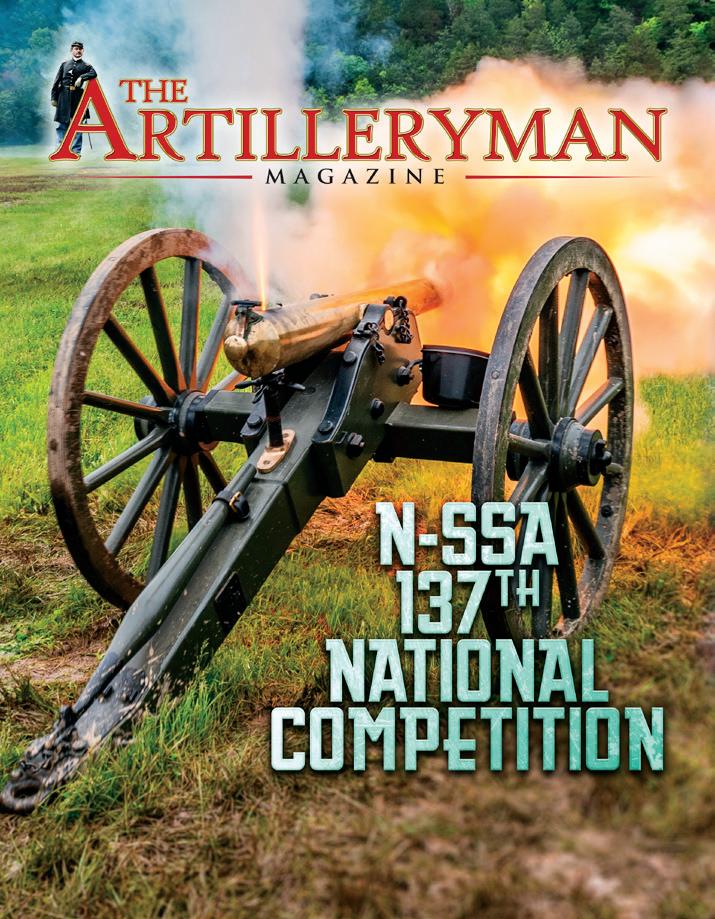




This full color magazine features articles on cannon safety, artillery history, projectiles, fuses, places to visit, book reviews, competition events, and so much more. The annual quarterly subscription price is just $37.95.
Military Antique Collector is a bi-monthly magazine with detailed high-resolution color photographs of some of the world’s most beautiful and unusual military collectibles. Dedicated to both the expert collector and novice alike, each issue is teeming with informative articles written by leading authorities in their fields of expertise, including distinguished well-known authors, along with prominent museum and auction professionals. Issues spotlight rare and unusual military objects, craftsmanship works, and their relationship to historical figures dating from early American and European history to limited coverage of the post-1898 artifact. Priced at only $39.95 for 6 issues. It’s easy to see why Military Antique Collector magazine has become so popular so fast.
Vol. 39, No. 4 Fall 2018 $8.00
•
2.25-Inch
• The
Also in is issue: HistoricalPublicationsLLC.com
ArchaeologicalExcavationsataConfederateBattery
HistoricalArtilleryofLeHôpitaldesInvalides
Coastal
Artillery at Fort Moultrie • 100-Pounder Navy Parrott Shells Confederate
Projectile Identified
Evolution of Brooke Sabots
Fort Branch, North Carolina, Reenactment Survived Covid


HAMILTON, N.C.—Over the November 5 and 6 weekend, the Fort Branch reenactment made its annual appearance. This year’s event was leaner with only some 200-250 participants representing both sides and all three branches. The public still turns out despite the political climate and the momentum lost to covid. This year was perhaps less well attended but several hundred visitors came to see the living history, buy from sutlers, learn about medicine, life on the home front, and tour the museum and fort itself.

Fort Branch, one of the best preserved Civil War earthworks, with most of its original complement of artillery still on site, has conducted reenactments for years but has gradually broadened its approach to go beyond the entertainment focus. This report basically ignores the two public battles and the Sunday morning tactical to show something of the site and what goes on in parallel with the battle reenactment.
Going from the parking area involved a walk through the sutlers; there were only a half

dozen this year, down from many more prior to covid. Reenactors took advantage of end of campaign season pricing to replace worn shoes, clothing, and other gear, plus acquire literature and equipment to improve their impressions. The general public took in the sales area, taking the opportunity to learn about blacksmithing or buy historical items that struck their fancy.
The trail wound down through a wood line and into one camp area portraying a field impression. Not every soldier slept in tents and there was a wide scatter of wool and gum blankets through most camp grounds.
Moving toward the museum, the lower ground closer to the fort, where earth for the fort’s glacis and parapets was obtained during three major construction phases, was left open because it is very often flooded by seasonal rains. This year proved an exception as the temperature on this bright and sunny weekend hovered in the low 80’s.
The North Carolina home front situation was well portrayed by civilian living historians who opened the Bunting House


(circa 1830’s) but exhibiting a hall and parlor floor plan found from late medieval times to the post-Civil War era. There was no formal program; the occupants were as well versed in initiating conversation as answering questions while they prepared food and, just outside the door, washed an interesting collection of mid-nineteenth century undergarments, or “unmentionables,” as one farm woman described them.
Next to the house was a quarantine tent for smallpox patients. This led to much discussion with the local doctor who explained that inoculation against the pox was more common than most think when the War broke out. It was pointed out that when the state’s Continental soldiers went north to join Washington’s army in 1777, they were all inoculated in Alexandria, Virginia, or Georgetown, Maryland. The medical display included prosthetic devices including a wooden leg and splinting, as well as a question raising display of medical instruments, a used bedpan, and medications.
Only a short distance away a fairly large group of womenfolk ranging from camp followers to town ladies enjoyed tea and coffee while officially discussing clothing styles and their manufacture, and admittedly conducted a great deal of catching up on the various units and their gossip. After the refreshments were over, teams of women gave presentations to their cohort and a growing group of spectators; one interesting presentation was on stockings and socks, including a give and take on why something that would not be seen in polite
12 CivilWarNews.com January 2023 12 January 2023 CivilWarNews.com
Wyse Fork Battlefield Preservation exhibit.
Blue Gray Education Society plaque with cannon in background.
Hospital equipment.
View of Fort branch Museum. All photos by Larry Babits.
Medical display.
Stocking lecture.
social circles was often well decorated.
Just beyond was the museum. Over the years, it has expanded to be more than just a shelter for protecting the cannon thrown into the river during the fort’s evacuation in March 1865. This year, there was a two for one sale on shirts, books, and children’s toys. The museum was fully staffed with volunteers from the Fort Branch Historical Society, many of whom are clearly very knowledgeable about the fort, its history, and a variety of Civil War topics.
The museum area also saw
a public unveiling of signage donated by the Blue and Gray Education Society. The well designed signs are found throughout the fort and three are present in the museum area; two deal with the cannon, a much larger one deals with the defense of the Roanoke River valley. Others are placed at key points around the fort interior where gun emplacements, the magazine, commissary, a pre-war civilian grave yard, and other internal fort elements are located.
Moving toward the fort, a public outreach effort to preserve the endangered Wyse Fork

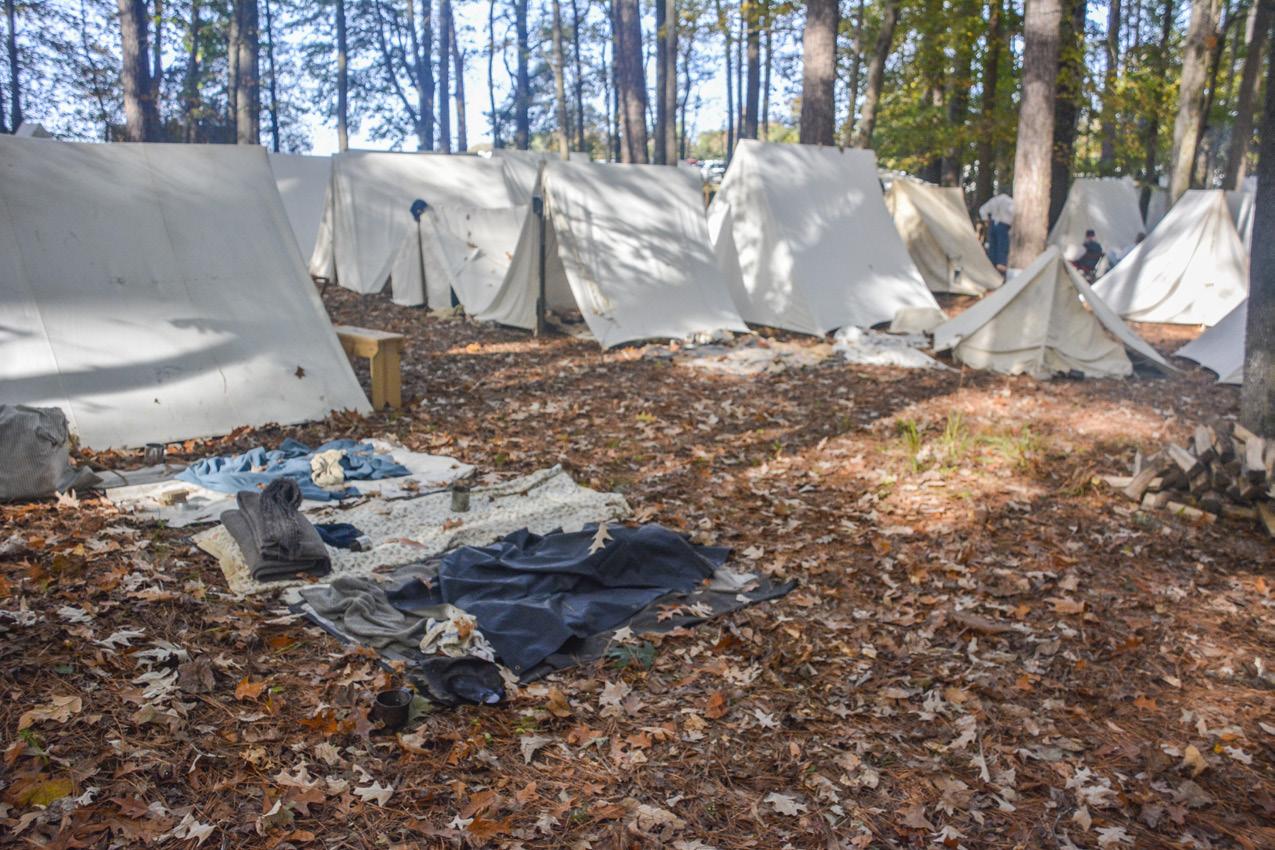


Battlefield was stationed. The table was manned by amateur historians who have rallied to oppose the North Carolina Department of Transportation’s plan to put an interchange into the center of the state’s second largest Civil War battlefield. They are not opposed to the highway, just that portion that would destroy where soldiers from all over the North, from Massachusetts and New York to Ohio and Minnesota, and the South, both Carolinas, and across all the states to Louisiana, Arkansas, and Mississippi, fought and died in March 1865. They were quick to point out that North Carolinians fought on both sides as infantry, artillery, and cavalry during the engagement. One Confederate private, Thomas Dula, Company K, 42nd North Carolina Infantry, is fairly well known because he is the “Tom Dooley,” of a famous ballad; history is where you come across it.
Small guided tours went through the fort itself, looking at gun emplacements and how they controlled the river
and covered the surrounding landscape. This latter aspect, the outlying defensive works, is something the Society is still learning about but there is clear evidence that there were trenches and gun emplacements associated with the fort that are still visible up to two miles from the main fort. Once these were identified, new searches through documents about the fort were reread and questions about what the documents actually meant
were raised. They are still being answered.
The fort continues to interest and intrigue people, many of whom come to be entertained but leave with new information about their own past history. This is why the Fort Branch Historical Society continues to stay the course and provide the venue for a trip into Martin County and eastern North Carolina’s long history. For more information visit www. fortbranchcivilwarsite.com.


13 January 2023 13 January 2023 CivilWarNews.com CivilWarNews.com
Living history interpreters in Bunting House.
Spectators visiting sutler’s tent.
Quarantine tent.
Sleeping area outside tents.
Reenactor camp area outside fort.
Eastern camp area.
by Carl L. Sell Jr.
The chaos, confusion, and carnage at Gettysburg’s July 3, 1863, High Water Mark on Cemetery Hill, was a potential disaster for the Union Army of the Potomac. However, two brigadier generals’ coolness under fire, one on the ground and one in the saddle, saved the day and possibly the outcome of the war.
Brigadier General Alexander Webb, although wounded while at the front of his line, rallied remnants of the Philadelphia Brigade, and with the help of New York regiments, brought the Confederate assault, named “Pickett’s Charge” for its leader,


Chaos at the High Water Mark
Maj.. Gen. George Pickett, to a standstill. Pickett watched the action from the Codori farm on the Emmitsburg Road. Webb would write in his report that the enemy had gotten behind troops from the Sixty-Ninth Pennsylvania and the Seventy-First and SeventySecond Pennsylvania had fallen back in the face of the assault.
About the same time, a little to the east of Webb’s position, Union Brigadier General David Gregg was alerted by lookouts on Cemetery Hill that Confederate cavalry was moving toward his position on what would become the East Cavalry Field battleground. Gregg, fearing he was outmanned, had just
convinced Brigadier General George Custer and his brigade to join Gregg’s ranks.
Gregg had been left alone to guard the rear of the Union infantry battalions near the top of the “fishhook” defense on Cemetery Hill almost in the town of Gettysburg. Custer had been scheduled to join Union cavalry units moving to protect the Federal flank near Cemetery Hill when Gregg asked him to stay back.
Brigadier General Judson Kilpatrick, a Union cavalry commander, had ordered Custer to move south with units commanded by Brigadier General Elon Farnsworth and Brigadier General Wesley Merritt to protect the Union rear behind the Round Tops.
The Confederate cavalry’s movement seems timed to coincide with the infantry’s frontal attack by Confederate General Robert E. Lee. If possible, the two attacks would strike the Union army in both the front and rear, sever the defensive line, and result in a Southern victory. A reading of after-battle reports by generals on both sides makes it unclear how close the timing of Pickett’s Charge and the cavalry attack were actually coordinated. One thing is clear, however, the action involving the attacking and defending infantry forces went on for some time, making the additional cavalry thrust a possible threat.
The Confederate infantry brigade led by Brigadier General Lewis Addison Armistead hit the Union line after assaults by brigades led by Brigadier Generals Richard Brooke Garnett and James L. Kemper failed to completely dislodge the defenders at great costs to the attackers. Armistead followed with his hat perched on his sword
and was mortally wounded at the Union guns.
The scene was described by Lieutenant James Whitehead, himself wounded and lying just steps from where Armistead fell. Whitehead was with the Fifty-Third Virginia Infantry, made up mostly of soldiers from Pittsylvania County. His words come from personal letters and a publication of war recollections collected by the County.
“Company I was the color company for Armistead’s Brigade, and when Jones, one of the color corporals, fell with the colors at the stone wall, Lieutenant Hutchings Carter snatched them up and bore them over the wall and up to the captured artillery where were standing General Armistead, Col. (Rawley) Martin and some men from Company I, viz.: Lt. H. C. Carter, Chip Coleman, Tom Tredway, Geo. White and Zeb Walker and perhaps others,” said Lieutenant Whitehead.
“We had driven the Yankees back from the stone wall, captured all the artillery in front of Armistead’s Brigade and the victory up to this point was complete,” Whitehead said. “But reinforcements arriving for the enemy and none for ourselves, that was the end of our dearlybought victory.”

Carter continued his description of the attack in “War Recollections,” talking about what happened at the wall.
“When the brigade reached the wall there were very few men left and Armistead, turning to Lieutenant Colonel R.W. Martin, said ‘Colonel, we can’t stay here.’ Colonel Martin replied ‘Then we’ll go forward;’ and over the wall the remaining few went. But there were only seven or eight men left, General Armistead, Col. Martin, and Lieutenant H.L. Carter, Thomas Tredway, James C. Coleman, and some others. When Jones fell from the wall, Lieutenant H.L. Carter seized the colors and ran forward among the cannon, which the enemy had abandoned.
“But reinforcements coming up they returned [sic], re-took the guns, there being no one to hold them, and opened fire on our line. General Armistead was killed (Armistead was hit by three gunshots and was mortally wounded) trying to turn one of the guns on the enemy. Col. Martin was wounded, his leg shattered by a ball. His friend, Thomas Tredway, who ran to his assistance, was shot and fell across his body dead.
“The others fell also, and Lieutenant Carter, finding himself alone in the enemy’s lines, surrendered and was sent a prisoner to the rear, leaving the flag among the guns. He had seventeen bullet holes in his clothes and yet was without a wound.”
The Sixty-Ninth Pennsylvania bore the brunt of the assault
14 CivilWarNews.com January 2023 14 January 2023 CivilWarNews.com
Brig. Gen. Alexander S. Webb, officer of the Federal Army (Maj. Gen. from Aug. 1, 1864). (Library of Congress)
Lieutenant James Whitehead, 53rd Virginia Infantry. (Find-A-Grave)
by the brigades of Garnett and Kemper. Although flanked on both sides, the Pennsylvanians’ fire decimated the Confederate brigades, killing Garnett (whose body was never recovered) and
seriously wounding Kemper, who survived and later became governor of Virginia. Armistead’s brigade, consisting of the Ninth, Fourteenth, Thirty-Eighth, Fifty-Third, and Fifty-Seventh

Virginia infantry regiments, pushed back the Seventy-First Pennsylvania and the SeventySecond Pennsylvania which was farther away from the wall than their comrades.

Despite being wounded in his thigh and groin, Webb rallied his men with the help of two regiments, under Colonel Norman J. Hall, as well as troops from the Second Division commanded by Brigadier General William Harrow. Webb’s men stopped the Confederate assault, inflicting heavy casualties and forcing the remaining Confederates back toward Seminary Ridge. Webb noted that a portion of the One Hundred Sixth Pennsylvania Volunteers also took part in repelling the assault.


There was widespread admiration for the performance by Lieutenant Alonzo H. Cushing of Battery A, Fourth U.S. Artillery although individual accounts differed in describing Cushing’s activities. There is little doubt he directed fire that decimated the oncoming Confederates, then moved the guns under his command from a forward position to the stone wall, where he would be wounded, then killed. Colonel Hall wrote two weeks after the battle, “Lieutenant Cushing

15 January 2023 15 January 2023 CivilWarNews.com CivilWarNews.com www.HistoricalPublicationsLLC.com The Maryland Arms Collectors Assoc., Inc. presents The “Original Baltimore” Antique Arms Show Since 1955 Maryland State Fairgrounds Timonium, MD North of Baltimore, York Road, MD. – Rt. 45 1,000 8-Foot Tables March 18-19, 2023 Public Hours: Sat. 9 A.M. to 5 P.M., Sun. 9 A.M. to 3 P.M. Admission: $10.00 – Post-1898 and Modern Handguns are Prohibited –Complete information on web site: www.baltimoreshow.com Or Call 443-497-9253 Known as the “CROWN JEWEL” of Collector’s Shows!
Brig. Gen. David McMurtrie Gregg, officer of the Federal Army, (Maj. Gen. from Aug. 1, 1864). (Library of Congress)
Brig. Gen. Lewis Addison Armistead. (Wikipedia)
Richard Brooke Garnett. (Library of Congress)
challenged the admiration of us all.”
Cushing would be nominated to receive the Medal of Honor 150 years later. The ceremony honoring him as a recipient would occur in August 2014. In his Official Report nine days after the battle, Webb called Cushing “cool, brave, competent, he
fought for an hour and a half after he had been wounded in both thighs.”
A day earlier, Webb and the Philadelphia Brigade had helped repulse one attack on Cemetery Hill and mounted a counterattack to help stop another. His bravery resulted in a battlefield promotion to Brevet Major General, all


achieved within three days!
On September 29, 1891, Webb was the recipient of the Medal of Honor “for distinguished personal gallantry in leading his men forward at a critical period in the contest” at Gettysburg. A full-size statue of General Webb was dedicated in 1915 overlooking the approach of
Pickett’s Charge. The spot was specifically selected by General Webb when asked to do so by the president of the Gettysburg Commission. Another is at City College of New York, where he was president from 1869 to 1902. He is buried at West Point, where he graduated in 1855. In an interesting aside from the battle, the members of the Seventy-Second Pennsylvania, which lost the most men of any Union unit involved that day, later protested the location for their monument at the High Water Mark. The unit leaders demanded that their monument be closer to the wall than the site selected by the Gettysburg Commission. After appeals to the Commission and the Pennsylvania Supreme Court, the location sought by the unit was approved and today the statue stands where the regiment fought.


After a grueling roundabout ride from Virginia to Gettysburg and a spirited battle with Union cavalry at nearby Hunterstown on July 2, Major General James Ewell Brown Stuart’s Confederate cavalry was no doubt looking for an opportunity to damage the Union infantry facing an allout frontal attack. Stuart was an opportunistic leader who liked to befuddle the opposition when least expected.
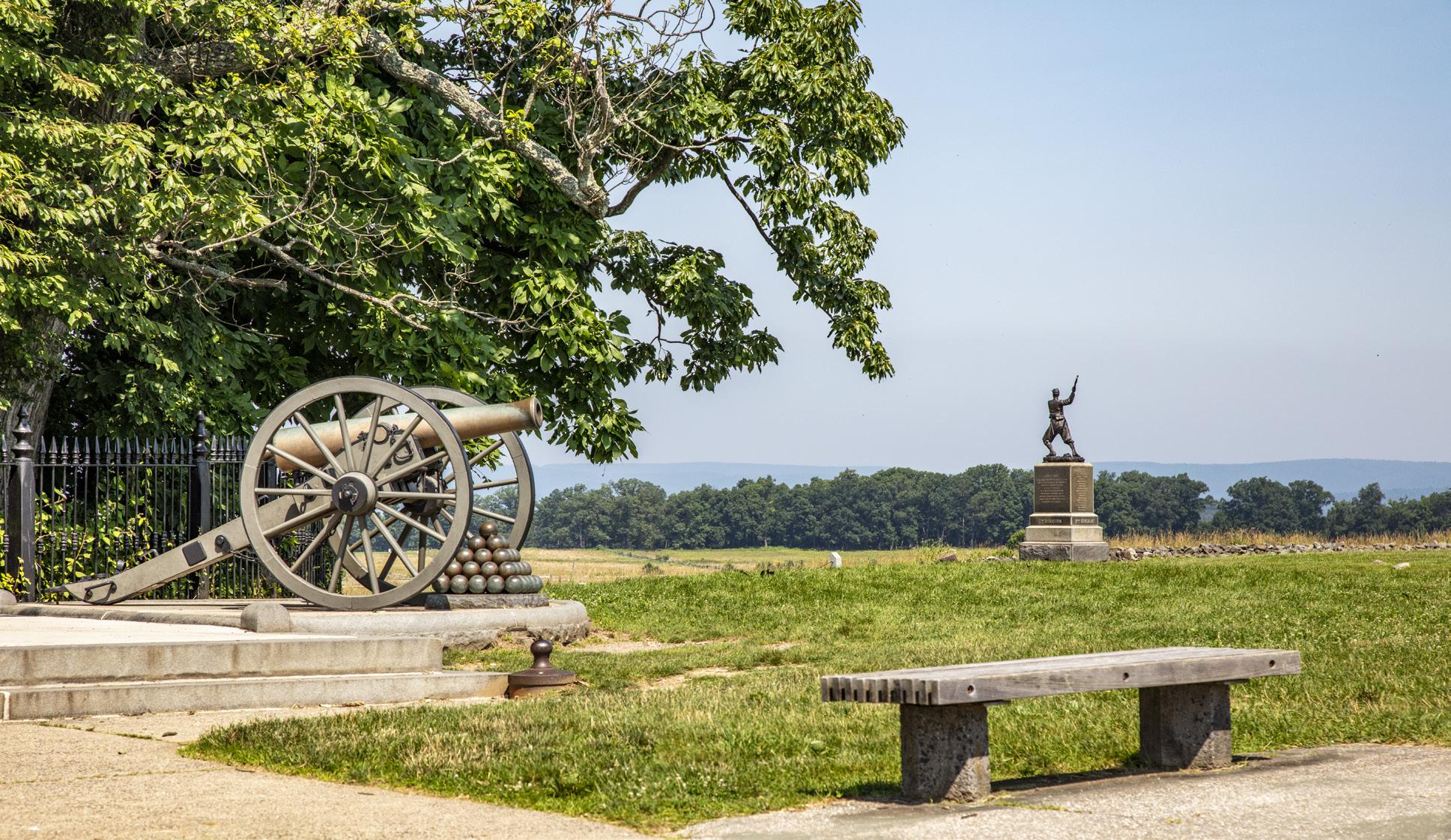
16 CivilWarNews.com January 2023 16 January 2023 CivilWarNews.com
High Water Mark clump of trees located behind the cannon. (Jack W. Melton Jr.)
Sixty-Ninth Pennsylvania Volunteers monument in front of the High Water Mark. (Jack W. Melton Jr.)
The area where General Armistead was mortally wounded. (Jack W. Melton Jr.)
Maj. Gen. (as of Apr. 15, 1865) George A. Custer (Library of Congress)
Lieutenant Alonzo H. Cushing. (Library of Congress)
Stuart was still smarting from the surprise attack by Federal cavalry units at Brandy Station in early June. At Gettysburg was the very Union leader who had tried to sneak up on his rear on Fleetwood Hill at Brandy Station. Stuart had repulsed that attempt and before him at East Cavalry Field was Gregg, the commander who had tried to make a fool of him in Virginia.
Anticipating an attack coming from the north along the Hanover Road, Gregg moved brigades commanded by Custer and Colonel John B. McIntosh into position along the Low Dutch Road. At this point, the two adversaries had roughly equal numbers, each with about 3,500 riders. After firing four shots from a single cannon in what was believed to be a signal to the infantry on the other side of Cemetery Hill that he was in place, Stuart sent his forces forward, ordering brigades commanded by Wade Hampton and Fitzhugh Lee to mount an attack.
He also ordered a battalion commanded by Lieutenant Colonel Vincent Witcher to dismount, advance, and hold the Rummel farm’s barn and a line of fencing. Artillery fire and advancing sharpshooters forced
Witcher’s men to first retire, then turn and unleash a deadly volley before falling back across a field. From there, the battle ebbed and flowed with many combatants
engaging in hand-to-hand combat. Artillery on both sides didn’t fire for fear of hitting their own men. Out of 432 men that Witcher took into action at East
GET TYSBURG explore


Explore
Cavalry Field only 96 survived. Hampton, in the middle of the fight, was wounded by a saber cut to the head and a pistol shot to the thigh. On the Union side, Custer led several charges, including an assault on the defenders at the fence line, but emerged unscathed. After the competing forces disengaged from close combat, Federal artillery forced Stuart to withdraw to the York Road and set up camp for the night.
While both sides claimed victory in the vicious East Cavalry Field fighting, the Union cavalry under Gregg thwarted Stuart’s advance toward the rear of the Federals battling the allout infantry assault. We’ll never know the answer as to Stuart’s intentions because of the Union cavalry east of Cemetery Hill. It gave Webb the time to organize a counterattack against Confederate infantry that breached the Union defense, preserving the Army of the Potomac’s center, possibly the entire effort during those three days and the future of the war.
By Gettysburg, Gregg was a veteran who had been promoted to brigadier general in December 1862. Gregg remained with the Army of the Potomac after Gettysburg and was promoted to

Brevet Major General during the Siege of Petersburg. In January 1865, he abruptly resigned his commission and settled in Reading, Pennsylvania, citing family affairs as the reason. He owned farming property in Milford, Delaware, but found himself yearning for life as a soldier, but was denied reinstatement to the army. He was involved in raising funds to preserve Valley Forge as a national historic site, briefly served as U.S. Consul to AustriaHungary, and was involved in Pennsylvania political activities. An equestrian statue of Gregg was erected in a plaza in Reading by the Commonwealth of Pennsylvania in 1921, five years after his death.
Carl Sell is a frequent contributor to Civil War News. Because his great grandfather and great uncle attacked the High Water Mark on July 3, 1863, he has read and researched extensively about the event. His great uncle, George White, is identified in an eye-witness account included in this story. Both were wounded that day, eluded capture, and survived the war. Carl can be reached at sellcarl@aol.com or 703-971-4716.
Historic Sites and Experiences
Children
Gettysburg’s most family-friendly interactive children’s history museum Explore the stories of Gettysburg through experiences of children who lived here during the battle. Engaging rst-hand accounts and interactive exhibits bring the stories to life.



Ticket to the Past –Unforgettable Journeys
The NEW virtual reality experience at the Gettysburg Lincoln Railroad StationTM Travel back to 1863. Meet some unlikely station occupants. Hear stories of their experiences during the aftermath of the battle Witness their unforgettable journeys.


11 a.m. | Ford Education Center
Designed for families with children ages 10-14.
Winter Lecture Series–Featuring Rangers, Historians & Authors Saturdays & Sundays, Jan. 7–Feb. 26 | 1:30–2:30 p.m. Free tickets required and available the day of each presentation at
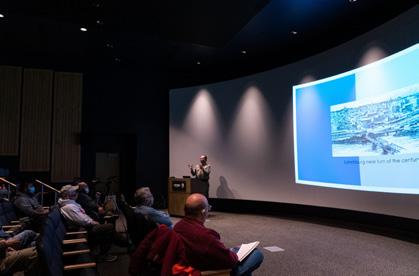
17 January 2023 17 January 2023 CivilWarNews.com CivilWarNews.com A Rough Coarse Life: The World of the Civil War Soldier A NEW temporary exhibit including items never-before-seen on display. Artifacts, documents and works of art offer a window into the lives, experiences and memories of those who struggled, suffered and survived a century and a half ago. Now Open Gettysburg National Military Park Museum & Visitor Center THE OFFICIAL START TO YOUR GETTYSBURG VISIT Proceeds from tickets and other purchases in the Museum & Visitor Center benet Gettysburg National Military Park and Eisenhower National Historic Site.
the Film. Experience the Gettysburg Cyclorama. Explore the Museum
the Battleeld
a Licensed Battle
See
Tour
with
eld Guide.
Connect with National Park Service Ranger programs
the grounds at Eisenhower National Historic Site
Visit the Gettysburg National Cemetery
Journey to our historic sites and experiences
For tickets and current hours, call 877-874-2478 or visit GettysburgFoundation.org THE GETTYSBURG FOUNDATION PRESENTS:
of Gettysburg 1863
For tickets and current hours, call 877-874-2478 or visit GettysburgFoundation.org
Gettysburg National Military Park’s popular winter programs return to the Museum & Visitor Center in 2023. Family Adventures: History Kids Reading Adventures Club Saturdays, Jan. 7–Feb. 25 | 11 a.m. | Theater Designed for families with children ages 4-10. Time Travelers Reading Adventures Club Saturdays, March 4–25 |
the
Limited seating on a first come,
basis. gf-explore gettysbrug ad_CWN 0123.qxp_Layout 1 11/21/22 4:12 PM Page 1
Ticket Counter.
first served
Equestrian statue of Maj. Gen. David McMurtrie Gregg (1922), by Augustus Lukeman, 4th Street and Centre Avenue, Reading, Penn.
V. R Lock Plate
A debate on a well-known Civil War internet forum centered around the American Civil War provenance of any 1853 British Enfield long rifles with a marking of “V. R” under the crown on the lock plate. It was flatly stated that, if so marked, the Enfield was the property of the British War Department and would not have seen use in the American Civil War.

It is difficult to deal in absolutes. It is especially difficult to deal in absolutes about every Pattern 1853 Enfield because there were
so many different commercial gunmakers producing them during the early 1860s. Also, as I like to say, “you are entitled to your own opinions, but not your own facts.” Let’s take a look at a few of the known facts.

First, to say that no P-53 Enfield long rifles marked “V. R” were used in the Civil War is incorrect. The royal cypher “V. R” stands for Victoria Regina (Queen Victoria). It suggests government ownership similar to the eagle stamped on U.S. Armory produced military weapons. However, virtually every single London Armoury (L.A.Co.) marked lock plate produced during the American Civil War-era had the royal cypher whether made for commercial export or a British Government contract. Due to scant surviving London Armoury Company (LAC) records, historians have depended on US, CS, and English documents as the main source for information on the firm. That, and the weapons themselves, are all we have to study.


London Armoury was started in February 1856 in Bermondsey, across the river from the city of London. It was an arms manufacturer producing both Adams designed revolvers and P-53 Enfield long rifles for the British War Department. The board of directors was offered a large contract by the War Department in 1859 if they would purchase a duplicate set of machinery identical to what was used at Royal Small Arms Manufactory, which they did. Adams disagreed with the new direction and left the firm.
LAC produced their P-53 Enfield long rifles on contract in identical fashion and used the exact same machinery regardless of the customer. The British, US, and CS governments all had contracts filled by LAC marked with “V. R” under the crown on the lock plate. Were those P-53s made for US/CS contracts exactly identical to the British Government contracts? Without getting too deep into the woods, there is some evidence that those made for export to the US/CS largely had Palmer type barrel bands vs Baddeley bands as specified for British Government contracts. Even that distinction is not absolute. Some P-53s with Baddeley type bands may have been imported late in the Civil War. Anecdotally, Baddeley type bands were claimed to have been dug by relic hunters in Georgia. So, who knows? This much is known, they were all first class, parts interchangeable weapons. What makes all this interesting within the context of the careful study of the material culture of the mid-19th century is that it discourages dealing in absolutes. These matters weren’t concluded with an eye toward what collectors and Civil War buffs would think important 160 years later. The British War Department used the “V. R” mark as a way of identifying government ownership of those military arms which passed their inspection and could be issued to their own troops much as the US Government marked the lock plate with a spread
eagle and “US.” The British government did not knowingly sell government arms to either side in the US Civil War, unlike the Austrian government who did sell their obsolete arms from the Royal Armory.

The TOWER lock plate marking was also intended to suggest that a weapon passed government inspection with gauges at the “Tower” government arms inspection facility. There was one in Birmingham on Bagot Street and of course, the Tower facility in London. We know none of the hundreds of thousands of Birmingham Small Arms Trade commercially produced P-53s marked TOWER ever got anywhere near a British Government arms inspection facility. Of course, these are also acknowledged as widely used by both sides in the Civil War.
London Armoury had the same machinery as the Royal Small Arms Manufactory. LAC did this with an eye toward selling parts interchangeable P-53 Enfield long rifles to the War Department; then the US Civil broke out. In fact, LAC had to finish up a War Department contract before beginning to first fill orders for the Commonwealth of Massachusetts, and then the Caleb Huse contracts for the CS Government. How many were made? If LAC had a set of the same machinery as Royal Small Arms Manufactory, and the output there was 6,000 arms per month, it seems reasonable that LAC could produce about half the same amount, or 3,000 per month. Whatever the exact figures may have been, the LAC P-53s were imported to America in fairly large numbers, and they
were all marked “V. R” under the crown behind the hammer. We can put the notion to rest that no Enfield long rifles with the royal cypher “V. R” were used in the Civil War. There were a sizeable number exported to America and used by both sides.

London Armoury sold their products to anyone who had the money, and with whomever it was legal to transact business with, including both American governments during the Civil War. It was a large gun manufacturing operation and at one point their minimum order was 10,000 arms per contract. LAC did not for a moment concern itself that the “V. R” appearing under the crown on the lock plate might run contrary to what other commercial gunmakers in London and Birmingham were doing and might be confusing to collectors 160 years later.
Craig L. Barry was born in Charlottesville, Va. He holds his BA and Masters degrees from UNC (Charlotte). Craig served The Watchdog Civil War Quarterly as Associate Editor and Editor from 2003–2017. The Watchdog published books and columns on 19th-century material and donated all funds from publications to battlefield preservation. He is the author of several books including The Civil War Musket: A Handbook for Historical Accuracy (2006, 2011), The Unfinished Fight: Essays on Confederate Material Culture Vol. I and II (2012, 2013). He has also published four books in the Suppliers to the Confederacy series on English Arms & Accoutrements, Quartermaster stores and other European imports.
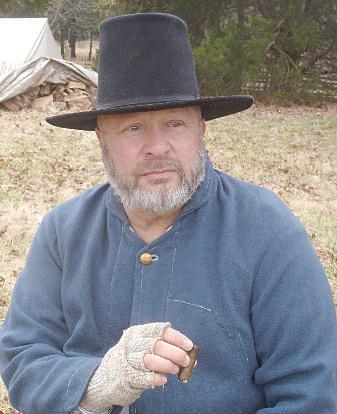
Typical plain LAC lock with V. R under crown behind hammer and date 1861 over L.A.Co. in front of the hammer.
 (Jack W. Melton Jr.)
(Jack W. Melton Jr.)

18 CivilWarNews.com January 2023 18 January 2023 CivilWarNews.com
Crown over V. R marking on a Pattern 1853 lock.
A Fresh Look for Old Stories
Last October a new Civil War Trails sign was installed at the Humphrey’s County, Tenn., Museum. The Museum at 201 Fort Hill Rd., in Waverly, Tenn., is one of over 1,400 Civil War Trails (CWT) sites across six states marketed for travelers from around the world. The new sign describes the importance of a Civil War fort located there as well as the experiences of the soldiers, both black and white who served there.



The project was completed
thanks to a partnership between Humphreys County Tourism, the museum, and Civil War Trails, Inc. The museum staff provided research and reviewed the final content including the new map. The tourism office sponsored the work, and the CWT team completed sign installation and is in the process of updating the print and digital brochures that help further promote the site. The installation at the museum was one of 61 projects the CWT team completed across the state. Although the new sign is educational, the CWT program is focused on promoting travel. “We deliver economic development by the carload—everyday.” Said Drew Gruber, Executive Director of Civil War Trails. According to Civil War Trails, Inc., travelers might spend between $600$1,000 per trip including the cost to stay 2-3 nights. There are three CWT sites in Humphrey’s County and over 350 throughout the state which means that the revenue generated from travel supports businesses and residents in Humphrey’s County and beyond.
This sentiment was echoed by Karin Landers, Tourism Director for the county who said, “this is an amazing travel opportunity for history veterans and novices alike. Add to that the awesome
outdoor amenity of the beautiful grounds.” “Ted Rice is such an asset to the museum and to the community.” “I hope visitors are able to schedule a visit with Ted as a tour guide!”
Ted Rice, President of the Humphrey’s County Museum pointed out that the new sign helps champion the story of the black men who served there. “Fort Hill is a monument and educational tool in honor of the United States Colored Troops of Humphreys County, Tenn.,” said Ted. Many of those soldiers were formerly enslaved and after the issuance of the Emancipation Proclamation joined the United States military. Gruber reiterated the importance of this effort specifically. “Stories like this one are only now being developed throughout the state and Waverly is ahead of the game thanks to the partners who made this possible,” said Gruber. For more information about visiting the museum on “Fort Hill” you can begin planning your trip at, www.visithumphreys. com. To find out more about the Civil War Trails program or request a brochure visit www. civilwartrails.org. Follow Civil War Trails and create some history of your own. Snap a selfie with the new sign and use #signselfie #civilwartrails #madeintn.
Ted
19 January 2023 19 January 2023 CivilWarNews.com CivilWarNews.com Letters to the Editor: Please email: mail@civilwarnews.com Subscribe or Renew Online at CivilWarNews. com
Rice, President of the Humphrey’s County Museum helps position the Civil War Trails directional ‘trailblazer’ sign. These directional signs work in tandem with the popular Civil War Trails brochures to help guide guests to each site. Courtesy, Civil War Trails, Inc.
Jason Shaffer (left), Director of Operations, and Chris Brown (right), Assistant Director of Civil War Trails, snap the new sign panel into place. These signs are uniquely fabricated to allow the signs to be updated as new research is uncovered. Courtesy, Civil War Trails, Inc.
Chris Brown (left), Assistant Director of Civil War Trails and Ted Rice (right), President of the museum work together to lift the new sign into place. There are over 1,400 Civil War Trails sites across six states. Courtesy, Civil War Trails, Inc.
Need advertising info for Civil War News? Email us at: ads@civilwarnews.com
“The Most Terrific Fire that I Ever Saw”: Artillery at Fredericksburg
by Tim Talbott
“It was the most destructive Artillery fire of the war,” claimed Capt. Thomas Henry Carter, who commanded a battery of Confederate guns at Fredericksburg. “Horses and men piled up by scores [with] in some two hundred yds,” and made for a scene that Carter would probably never forget. Positioned on the south end of the battlefield at Prospect Hill, a location soon named “Dead Horse Hill” due to the accurate and destructive fire of opposing Federal artillery, it was only one of many areas where artillery influenced the Battle of Fredericksburg.
Not long after arriving on the Stafford County side of the Rappahannock River in midNovember 1862, the Federal artillery was positioned on the high ground. Across the river on the heights south and west of Fredericksburg, the Confederates eventually assembled their force. When bridging materials finally arrived for the Federals, they crossed on December 11, under heavy rifle fire from Gen. William Barksdale’s Brigade. In an effort to clear out the Rebel street fighters, Union artillery let loose a barrage on the town from almost 150 guns located on Stafford Heights. Doing little
damage to Barksdale’s men, who found and created what cover they could, the heavy pounding took its toll on Fredericksburg’s buildings, streets, and yards.
Pvt. William Abernathy, a Mississippian, remembered that the land behind their position “was ploughed by shot and shells as though a disc plough had run over it.” Although ensconced in cellars and other cover, “Now and then would come, following the bursting shell, a cry for water. Every old soldier knows that a cry for water means that the man has been stricken unto death, and all day long that winter day, the 11th of December, the dreadful work went on,” recalled Abernathy. Another Southerner noted that, “The town could not boast of a whole window” undamaged by the Federal guns.
For the Federals, December 12, 1862, involved getting their troops across the river on the now secure pontoon bridges. By the following day, Confederate artillery pieces on Marye’s Heights and Willis Hill were well dug in and placed where they could do the most damage. While speaking with Gen. James Longstreet before the battle, artillerist Lt. Col. Edward Porter Alexander explained that, “General, we cover that ground now so well that we will comb it as with a fine-tooth comb. A chicken could not live on that field when we open on it.”
When the first Federal infantrymen moved out of Fredericksburg toward the Confederate position, the Washington Artillery of New Orleans opened on them. One artillerist noted that “We could see our shells bursting in their ranks, making great gaps.” Doing such damage at long distance was the job of the artillery, and the defenders performed well that day.
Federal soldiers attested to the destructive fire throughout the day’s assaults. Sgt. George Washington Whitman, poet Walt Whitman’s younger brother, who fought in the 51st New York, wrote his mother after the battle that it was “the most terrific fire of grape, canister and percussion Shell . . . that I ever saw.” He explained that “their batteries being on high ground . . . they threw percussion shells into our ranks, that would drop at our feet and explode killing and wounding Three or four every pop.” Union artillery batteries moved through the city and onto the attack plain, but proved largely ineffective due the superior elevated position of the Confederate guns and the Federals utilizing primarily smoothbore pieces instead of rifled guns.
Almost simultaneously, the Federals on the southern end of the battlefield, kicked off their attack. Their left flank advance came to an abrupt halt by the daring and skill of Maj. John Pelham of Gen. J. E. B Stuart’s Horse Artillery. With a single 12-pounder Napoleon, Pelham and his crew delayed the Union attack for almost an hour, until he finally withdrew the gun.
After Pelham left the field, the Union artillery moved onto the flat plain and hammered Confederate infantry on the wooded ridge. Pounding the unseen defenders’ position with shot and shell, the Federal guns tested the resolve of both Confederate infantry and artillery on the high ground. As previously mentioned, the pelting fire killed many southern horses. Thinking their work effective, the Federal artillery stopped firing and their infantry marched forward.
Gen. Thomas J. Jackson’s force, strong with artillery on both flanks, to the south under Lt. Col. Reuben Lindsay Walker and to the north with guns commanded by Captains Greenlee Davidson and John Brockenbrough, blasted the Federal infantry and forced them to slow their assaults. As historian Frank O’Reilly notes: “Yankee cannoneers had the benefit of higher quality and better caliber guns, with more reliable ammunition, even with numerous misfires. Rebel artillery offset their handicaps with superior positions and better angles of fire.”
As more artillery from both sides entered the fray around what became known as the “Slaughter Pen,” Confederate Capt. Joseph W. Lattimer found a piece of high ground just north of Capt. Davidson’s position where he unlimbered his battery to throw iron at the Federals.
Federal
The Union infantry found the Southern line’s center weak due to a lack of artillery in the heavily wooded area, as well as a marsh the Confederates believed would prevent their enemy’s progress. Exploiting this vulnerable position, the Yankees achieved a temporary breakthrough before reinforcements counterattacked and drove the Federals back.
Eventually, with the coming of darkness, the battle sputtered to a close on both ends of the battlefield; finally the cannons went quiet.
CVBT has saved a number of important artillery positions at Fredericksburg. Willis Hill, where part of the Washington Artillery of New Orleans fired, was the organization’s first preservation victory. CVBT has also added Pelham’s Corner and



The mission of CVBT is to preserve land associated with the four major campaigns of: Fredericksburg, Chancellorsville, Mine Run, and the Overland Campaign, including the Wilderness, and Spotsylvania Court House. To learn more about this grassroots preservation non-profit, which has saved over 1,700 acres of hallowed ground, please visit: www.cvbt.org.

20 CivilWarNews.com January 2023 20 January 2023 CivilWarNews.com
Located on the south end of the battlefield, the Confederate artillery on Prospect Hill represented by this 6-pounder cannon took a pounding from the Federals during the Battle of Fredericksburg.
artillery on the northside of the Rappahannock River inflicted tremendous damage on Fredericksburg’s buildings. A U.S. 3-inch ordnance rifle marks the position as shown above. (Photos courtesy CVBT.org)
The Washington Artillery of New Orleans fired on the attacking Federals from Willis Hill, near today’s Fredericksburg National Cemetery. CVBT helped save this part of the battlefield in 1996.
Lattimer’s Knoll on the southern end of the Fredericksburg battlefield, as well as the Norfolk Artillery’s entrenched position on the far northern end.
Visit our new website at: HistoricalPublicationsLLC.com
Tim Talbott is the Chief Administrative Officer with the Central Virginia Battlefields Trust.
Location of Lincoln Speech Identified
by Leon Reed
Hundreds of people passing through Gettysburg National Cemetery around 2 p.m. on Remembrance Day (Nov. 19) were curious what a group of 8-10 people was doing with the spool of red, white, and blue ribbon on both sides of the fence separating the National and Evergreen cemeteries. As one member of the group explained to some curious boy scouts, “you’re the first people since the day Mr. Lincoln gave his speech to see exactly where the president stood to deliver that speech.”
That insight is the result of a decade’s work by former Disney animator and Lincoln buff Christopher Oakley, his “New Media” students at the University of North Carolina-Asheville, advanced software that allowed a fresh look at six photographs taken the day of Lincoln’s speech, a variety of other high-tech tools, and the street smarts of a variety of Civil War, photography and technology buffs.
Oakley had announced his findings the previous day at the Lincoln Forum conference. Previous “guesses” about the location included the site of the Henry Bush Brown Lincoln
monument near the rostrum, the site of the present-day Soldiers National Monument, and various other spots in Evergreen Cemetery. In recent years, a rough consensus emerged that the speaker’s platform was located “somewhere in Evergreen Cemetery, not too far beyond the present-day fence,” which wasn’t there in 1863.
Finding Lincoln’s location wasn’t the original effort of Oakley’s “Digital Lincoln Project,” which he started at UNC–Asheville in 2013. His first project was to create a realistic digital Lincoln “and bring him to life reading the Gettysburg Address.” The effort to find the speaker’s platform spun out of this project.
“We started with the written record and then turned our attention to the six known photos of the event,” said Oakley. There were two distinct phases of photo research: enhancing the photos and then studying them carefully to get as much information as possible out of the photos.
“They are rich with detail,” said Oakley, and contain “lots of information.” The team identified the precise locations from which the photos were taken, to allow
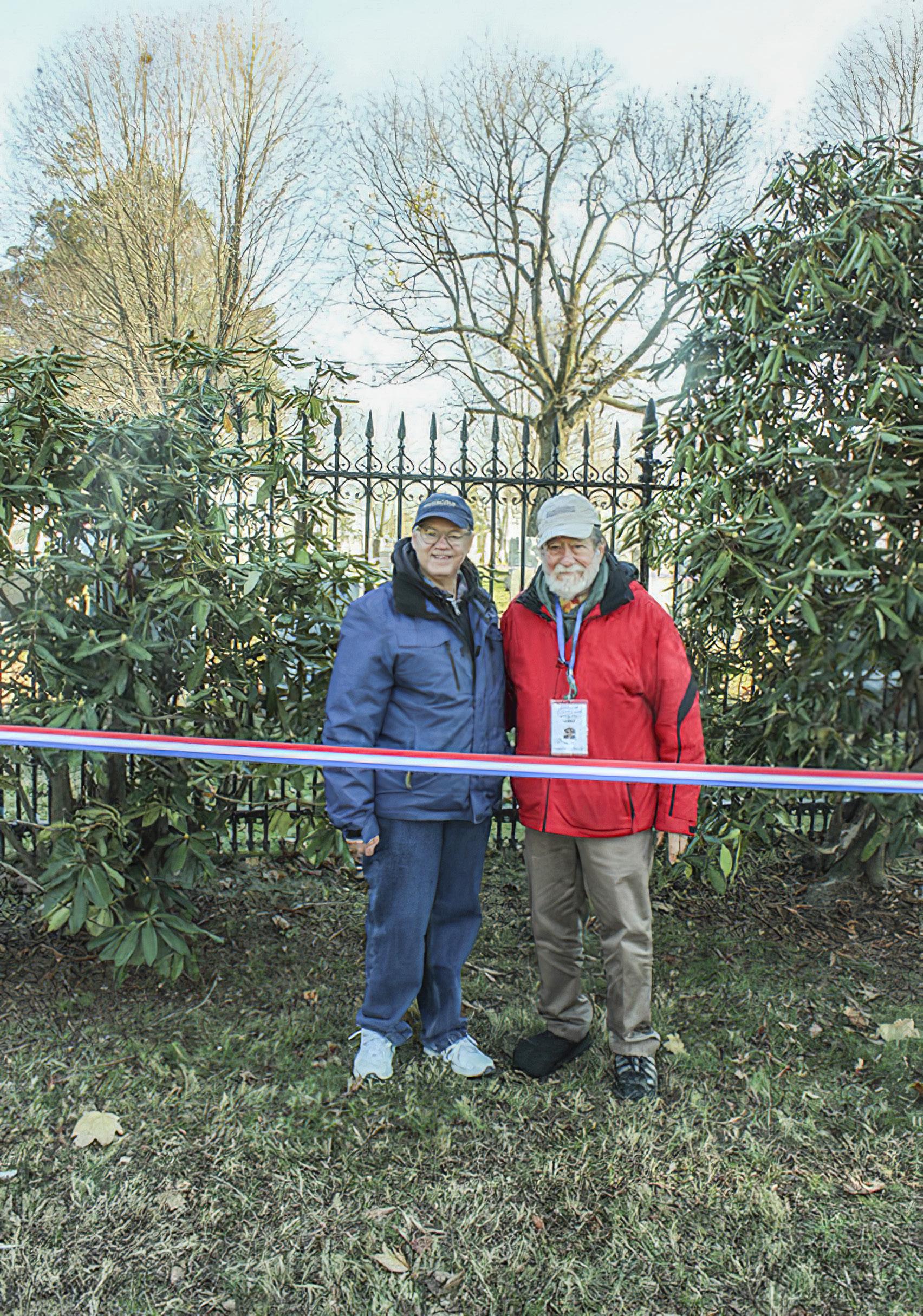
triangulation. Four were taken from two places in the cemetery, one was taken from the second floor of the Evergreen Cemetery gatehouse, and the sixth was taken from where the Quality Inn stands today. The research also involved 3-D modeling “and some old-fashioned sleuthing.”
Oakley’s team concluded that the platform was much larger than the agreed-upon size, was shaped like a trapezoid, and straddled the boundary between the cemeteries. Most of the seats were in Evergreen but the speakers were standing in the National Cemetery. They also concluded that the people on the platform sat in a semicircle, not straight rows.

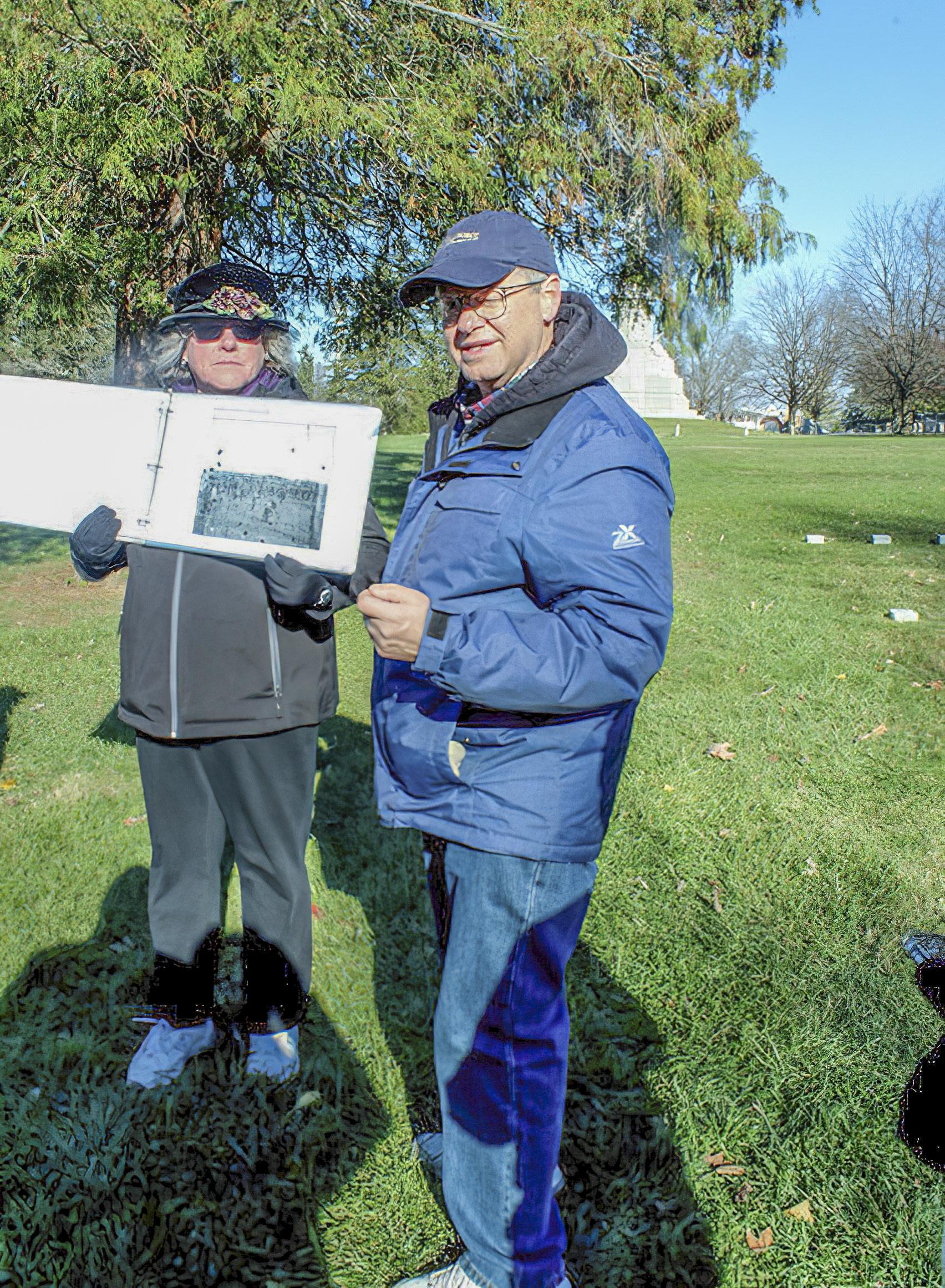
Saturday’s walking expedition included Jennifer Schuessler, the New York Times reporter who crafted a front-page article in the morning’s paper about Oakley’s announcement; an archivist from the Library of Congress; several of his photo research collaborators, and a few conference attendees interested in the project. They set off from the Quality Inn and stopped at each camera position to view the photo(s) taken from that spot and discuss how the information helped pin down the location. They wound up at the site of the platform and used the ribbon to mark the dimensions of the platform. Along with a few curious spectators who joined them, they then took turns posing at “the spot.”
When asked if it really mattered where Lincoln stood, Oakley described the experiences of his students. “At first, almost none of them were interested in history; they joined the program for the technology; but as we got deeper into the project, they all became interested in history.” He added, “When we came to Gettysburg to familiarize everyone with the site and take reference photos, I noticed that as we got closer to the site, all the normal horsing around stopped. By the time we got to the site it was complete silence: the kids thought they were on hallowed ground. Knowing you are standing on the spot where Lincoln actually gave the speech ignites the imagination and transports you back.”
Leon Reed is a retired Senate aide and U.S. history teacher. He lives in Gettysburg and is the author of History in Granite and Bronze: The Civil War Artwork of Gettysburg, Antietam, and Washington, D.C
21 January 2023 21 January 2023 CivilWarNews.com CivilWarNews.com
Christopher Oakley and Civil War News author Leon Reed pose at the spot where Lincoln stood to deliver the speech.
Christopher Oakley stands at spot (near 1st Minnesota memorial urn) where Alexander Gardner took three photos on November 19, 1863.
Christopher Oakley stands at spot Lincoln waited to mount platform.
Trust Receives an Opportunity to Acquire and Restore “General Pickett’s Buffet” Site
For decades, the famous “General Pickett’s Buffet” has been a part of the battlefield backdrop for visitors to Gettysburg National Military Park. Now, as restauranteur Gary Ozenbaugh sets out to relocate his popular business, the chance has arisen for the Trust to acquire and restore the original site.

Following a $1.5 million acquisition campaign and subsequent restoration costs, the Trust will be able to more seamlessly integrate the site into the adjacent parkland. Consisting of a half-acre, the site overlooks the field of Pickett’s Charge where, over 150 years ago, 12,000 Confederate soldiers advanced toward Cemetery Ridge. The same ground also saw continued military service in World War I and World War II. Additional information on this multilayered history and the developing plan to restore the area to its Civil War era appearance is available at www.battlefields.org/3to1match.
Although the eatery is moving on from its Steinwehr Avenue roots, it is not disappearing from Gettysburg. A restaurant operated by the same team is set to open as part of the reimagined Boyds
Bears complex. The scenario is a true win-win for everyone involved; more preserved battlefield and a beloved institution thriving in a new location, retaining local jobs, and accommodating even more customers.
“It has been a privilege to contribute to the Gettysburg community for so many years,” said Ozenbaugh. “Knowing that, through working with the Trust, I am able to help enrich the experience of visitors for generations to come is an absolute joy.”
Protecting the Past: 22 Acres Saved at Louisiana’s Port Hudson and Mansfield
Louisiana contains more than 30 principal battlefield sites tied to the Revolutionary War, War of 1812, and the Civil War. With its recent addition of 2.57 acres at Port Hudson and nearly 20 acres at Mansfield, the Trust has reached a preservation total of almost 772 hallowed acres saved in the Bayou State.
Since 1993, the Trust has saved 258.57 acres at Port Hudson and 459.29 acres at Mansfield.
Carrying priceless value that adds to the state’s expansive history, these battlefields, both state historic sites, will now grow and augment opportunities
for visitors to discover the many stories ingrained in the soil. One of the most contested locations during the summer of 1863, Port Hudson was critical in determining control of the Mississippi River. The Federals fought long and hard to capture the site from the Confederates. After a 48-day siege, the southern citadel surrendered on July 9, 1863. The newly preserved tract is located within the Confederate defenses used during the siege. It also contains portions of postsiege earthworks constructed by the Union’s Corps d’Afrique. With the objective to capture Louisiana’s Confederate capital at Shreveport, Union forces launched the Red River Campaign in the spring of 1864. However, Confederate forces stood fast, blocked the road to Shreveport, and forced Union forces to retreat at the Battle of Mansfield on April 8, 1864. The recently acquired tract covers land tied to the second phase of the 1864 battle. Learn more about the Trust’s preservation victories at www. battlefields.org/preserve/ celebrate-our-victories.
Discover New Ways to Support the Trust’s Mission
For over a decade, the Trust has worked ardently to maintain its coveted four-star rating from the nonprofit Charity Navigator, demonstrable evidence of its dedication to the mission and supporters. With its effectiveness
evident in the more than 55,000 acres of battlefield land it has protected, the Trust encourages you to learn how you can help preserve, educate, and inspire.
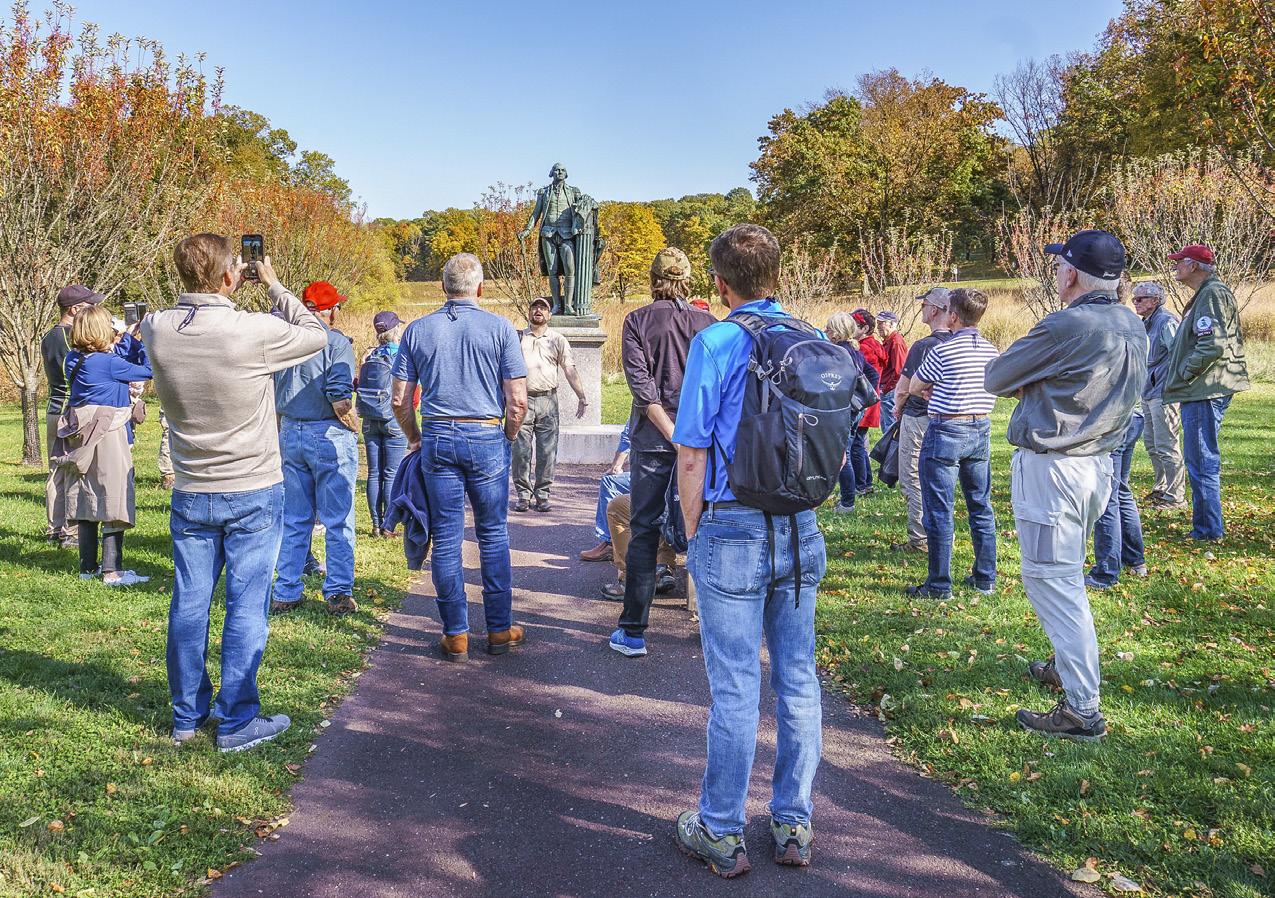
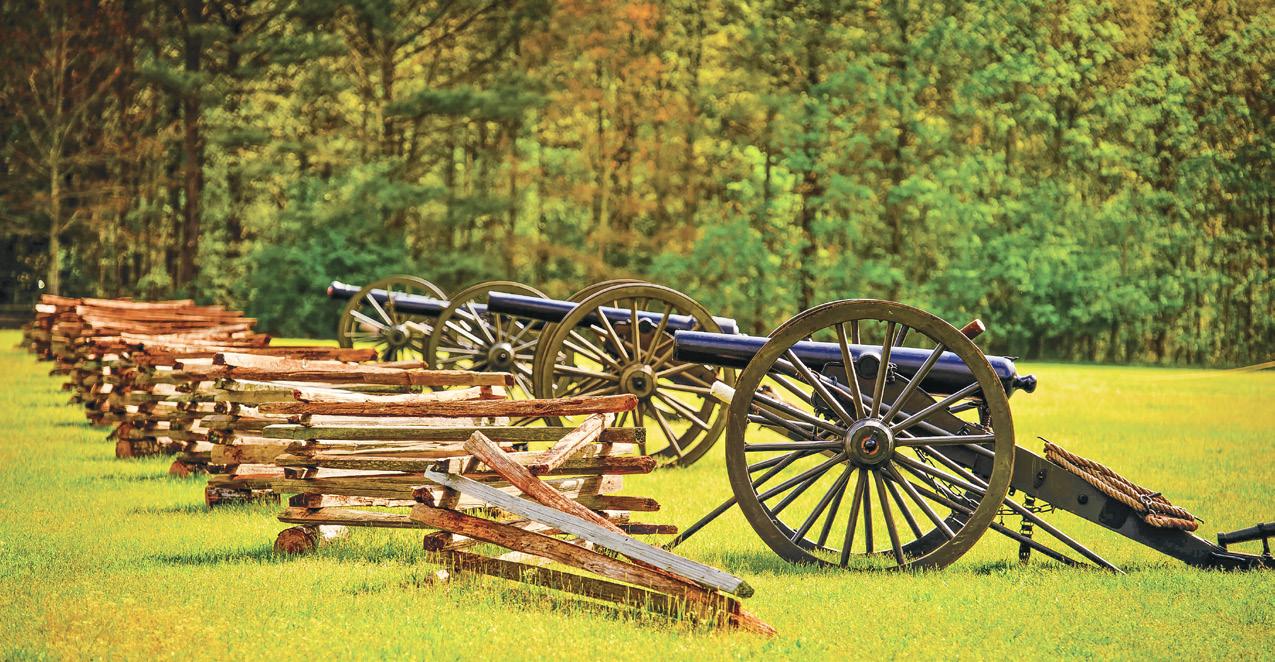

If you’re looking for a gift, consider a gift membership to the Trust (including a subscription to Hallowed Ground magazine). You can also help protect battlefield land in the name of a loved one! Additionally, the Trust offers workplace giving for federal
history at the nearby Brandywine and Princeton Battlefields.
Trust Mourns the Passing of Football Legend and Preservationist Vince Dooley
employees, IRA donations for members over 70 years old, and more. Learn more at www. battlefields.org/give.
Trust Color Bearers Gathered for Annual Grand Review
In mid-October, the Trust’s annual Grand Review took place in King of Prussia, Penn. There, roughly 150 Color Bearers walked in the footsteps of General Washington’s troops at Valley Forge National Historical Park. They explored this heartland of Revolutionary War history through an offering of nine tours and one compact history talk. As such, attendees walked away with a whirlwind of knowledge of the Revolution’s Ten Crucial Days and Philadelphia Campaigns, and a pride in contributing to 210 preserved acres of hallowed
The Trust joined the outpouring of grief following the passing of Coach Vince Dooley in late October. Although best known for his 25-year career as head football coach at the University of Georgia, Dooley was an integral part of the historic preservation community, serving three terms on the organization’s Board of Trustees and a term as chairman of the Board of Curators of the Georgia Historical Society. Although he served in many capacities on the Trust’s board between 2013 and May 2022, when his final term expired, Dooley was proudest of his time chairing the organization’s education committee. He was also instrumental in the protection of 180 acres at the Kettle Creek Battlefield in Washington, Ga. Dooley also served two years in the Marine Corps, had his master’s degree in history, and was a published author. In 2015, he released The Legion’s Fighting Bulldog.
Virginia County Votes to Permit Data Center Construction Adjacent to Manassas Battlefield
At a Prince William Board of County Supervisors meeting that began the night of November 1, hundreds of local citizens, as well as conservation and preservation organizations, waited patiently until after midnight for an opportunity to speak out against a controversial proposal that will allow massive data centers to be
22 CivilWarNews.com January 2023 22 January 2023 CivilWarNews.com
While the Trust perseveres to acquire the “General Pickett’s Buffet” site, the popular eatery will relocate elsewhere in Gettysburg. Photo by Noel Kline.
Port Hudson Battlefield in Jackson, La. Photo by Gerard Plauche.
Color Bearers tour Valley Forge at the Trust’s 2022 Grand Review. Photo by Buddy Secor.
What a data center might look like when placed upon land tied to the Battles of Manassas. Photo of battlefield by Rob Shenk/ data center image by Tim Aubry, Greenpeace.

constructed adjacent to Manassas National Battlefield Park. Despite significant public opposition, the Board of Supervisors passed the measure 5-2, clearing the way for major development.
“Thirty-five years ago, the modern battlefield preservation movement began, spurred by the massive suburban growth across Northern Virginia,” said Trust President David Duncan. “Today, the threats are different but the need to call for careful planning that balances modern development with respect for America’s past remains unchanged.”

Despite the disappointing outcome, the American Battlefield Trust is prepared to work with Prince William County to mitigate the impact of the site plans. Learn how you can support Trust advocacy efforts at www.battlefields.org/preserve/ speak-out.
Trace 3,515 Acts of Valor on Virtual Map
A new global map from the Medal of Honor Valor Trail,™ a joint initiative of the American Battlefield Trust and the Congressional Medal of Honor Society, allows users to virtually

follow in the footsteps of Medal of Honor recipients by clicking on a location to learn more about the actions that led to their distinguished service and their personal histories.
The Medal of Honor Valor Trail™ initiative spans the full lineage of the Medal of Honor, from its Civil War origins into the 21st century. It is designed to connect the places most deeply connected to the lives and legacies of recipients, from battlefields to burial places, memorials to museums, hometowns to namesake sites. In doing so, the Valor Trail is creating a community of sites that together illuminate the core values of service that spans centuries.
“Recipient stories have rarely been told from the places where their heroics unfolded,” said Trust President David Duncan. Medal of Honor citations typically describe a single act of valor above and beyond the call of duty. Each is exceptional, but when viewed collectively through a map, they tell a much broader story that helps show the exceptional men and women who, generation after generation, have answered the nation’s call to service. Explore the Places of Valor map and the trail at large at www.valortrail.org.
Gun Works, Inc.
Thousands of blackpowder hobbyists and aficionados, from history buffs and re-enactors to modern hunters and competitive shooters, trust
Medal of Honor Valor Trail™ global map record for recipient Sergeant First Class Thomas P. Payne.
Gun Works for its expertise in all things blackpowder: guns, supplies, and accessories and parts for both reproductions and antique guns. Whether you’re just getting started or you’re a life-long devotee, everything you need is right here in
catalog.

23 January 2023 23 January 2023 CivilWarNews.com CivilWarNews.com
Image by American Battlefield Trust.
DIXIE GUN WORKS, INC. 1412 W. Reelfoot Avenue PO Box 130 Union City, TN 38281 INFO PHONE: (731) 885-0700 FAX: (731) 885-0440 EMAIL: info@dixiegunworks.com VIEW ITEMS AND ORDER ONLINE! www.dixiegunworks.com Major credit cards accepted FOR ORDERS ONLY (800) 238-6785 PROFESSIONAL SERVICE AND EXPERTISE GUARANTEED
TODAY! STILL ONLY $5.00! The tried-and-trusted choice of today’s blackpowder enthusiasts.
2023 DIXIE GUN WORkS’
ORDER
Dixie
the
Louis T. Wigfall. The Johnston family stayed in Wigfall’s Richmond home during his convalescence. The Confederacy did not have any political parties to structure exchanges of ideas. Wigfall actively contributed to Richmond’s political turmoil and Davis resented any questioning of the effectiveness of his policies.


On December 10, Davis departed Richmond by train on a morale boosting western tour.
No Confidence



“Nobody ever assumed a command under more unfavorable circumstances.” –C.S. Gen. Joseph E. Johnston
In November 1862, both U.S. Gen. Ambrose Burnside and C.S. Gen. Joseph Johnston were assigned commands they did not want. On November 7, 1862, Burnside was promoted to be the commander of the Army of the Potomac despite pointing out his abilities were not up to the position. Burnside was told either he took the position, or second choice Gen. Joseph Hooker would.

President Jefferson Davis’s solution to having limited resources was to shuttle men and supplies between armies as needed. Four small independent armies operated in the Western Theater; generals Braxton Bragg’s in Tennessee, John C. Pemberton’s was based in
Vicksburg, Miss., Edmund Kirby Smith’s, in East Tennessee, and Theophilus Holmes,’ in Arkansas. During the 1862 Federal incursions into Kentucky, the lack of cooperation and public squabbling between the armies convinced Davis he needed an overall commander to coordinate the resources.
On November 12, Johnston reported for active duty after recuperating from wounds suffered during the May 31, 1862, Battle of Seven Pines, Va. Johnston knew it was unrealistic to be reinstated as commander of what was now the Army of Northern Virginia, as he had hoped; the position was held by Gen. Robert E. Lee. Instead, he was assigned command of the Department of the West. Johnston soon realized that due to the distances involved, it would be more practical to split the department’s force into two armies. Johnston was also uncomfortable with Davis’s
expectation that he would be the commanding officer of any army he was visiting, without having knowledge of its day-to-day activities. Furthermore, Davis had the commanders’ reports sent directly to Richmond, Va., and would inform Johnston of any changes in plans after the fact. Johnston believed he was being set up to fail.
Before the War, Johnston, Davis, and Lee had been friends and were classmates together at West Point. The split between them occurred in September 1861 because rank and status were important to Johnston. Johnston believed he out ranked Gen. P. T. Beauregard and was not within the Virginia chain of command headed by Lee. As far as Johnston was concerned, Davis did not sufficiently support him.
On the other hand, Davis doubted Johnston’s loyalty due to his friendship with Senator
He brought one valise and was accompanied by his nephew and a servant. Crowds cheered Davis as the train passed by the stations.
On December 11-13, Burnside fought the Battle of Fredericksburg, Va., as part of his plan to reach the Confederate capitol at Richmond. He had tried to get across the Rappahannock and beyond Fredericksburg before Lee could block his movement on the capitol, but the pontoon bridges needed to cross the Rappahannock were held up by bureaucratic delays. As Burnside waited, Lee blocked the crossing. Instead of altering his plan, Burnside made repeated frontal attacks on Lee’s elevated position, resulting in devasting Federal losses. “What luck some people have,” Johnston wrote to Wigfall when informed of the battle. “Nobody will ever come to attack me in such a place.”
At Murfreesboro, Tenn., Davis ordered Johnston to send 9,000 men from Bragg to Pemberton. If the Federals attacked Bragg, “fight if you can,” said Davis, “and fall back beyond Tennessee.” To Wigfall, Johnston wrote: “This has blown away some tall castles-in-the-air. I have been dreaming of crushing [U.S. Gen. Ulysses] Grant with Holmes and Pemberton’s troops, sending the former into Missouri, and with the latter, Bragg, & Kirby Smith, marching to the Ohio.”
On December 30, Burnside took advantage of unusually warm weather and ordered his cavalry to attack the Virginia Central and Fredericksburg railroads. The cavalry only traveled 30 miles before being stopped to await further orders. Burnside had received a telegram from
24 CivilWarNews.com January 2023 24 January 2023 CivilWarNews.com
Major Gen. Ambrose Burnside. Colorization © 2022 civilwarincolor.com, courtesy civilwarincolor.com/cwn. (Library of Congress)
General Joseph E. Johnston, C.S.A. Colorization © 2022 civilwarincolor.com, courtesy civilwarincolor.com/cwn. (Library of Congress)
President Jefferson Davis, C.S.A. Colorization © 2022 civilwarincolor.com, courtesy civilwarincolor.com/cwn. (Library of Congress)
Washington. Two of Burnside’s division commanders had made it into a room with Lincoln. They couldn’t bring themselves to say, “that the whole trouble was that the privates had no confidence in General Burnside.” Instead, they suggested an investigation.
Lincoln considered the pair as two self-promoting officers who simply wanted to get their commander’s job. Burnside wanted them cashiered and Henry Halleck, General in Chief of the Armies, supported Burnside. Lincoln didn’t see the point in firing Burnside or cashiering the officers. Burnside was advised that the government endorsed the idea of forward movement, but the government was not trying to drive him.

On December 31–January 2, 1863, the Battle of Stone’s
River, Tenn., was fought between Bragg and U.S. Gen. William Rosecrans. Rosecrans was ordered to find a fight and win it, to give teeth to the newly signed Emancipation Proclamation. The Federals had cut the telegraph lines, so Johnston was unaware of a major battle until it was over.
On January 4, back in Richmond, Davis commented that a few Yankees who had cried “on to Richmond” actually got there—as prisoners.” On January 20, Burnside ordered his troops men to pack up their winter camp at Falmouth, Va., swiftly march to United States Ford, cross the Rappahannock and outflank Lee. By afternoon the clear sky had turned cloudy; in the evening incessant rains came, and the wind howled. The roads turned into mud over two feet deep in some places.

The next morning the mud was so “… despairingly deep as to check the discordant, unmusical braying of the mules, as if they feared their mouths would fill, to have it so deep that their ears, wafted above the waste of mud, were the only symbol of animal life, were depths to which the army had now descended for the first time.”
Cannon were dragged with tripled teams but would sink unless logs and fences were placed under it during a breather.
“Our position was like that of liliputions [in Gulliver’s Travels] in a great mud pile,” wrote a solider. Across the river the Confederates enjoyed themselves, offering advice and signs pointing the way to Richmond and “BURNSIDE STUCK IN THE MUD.” His officers finally convinced Burnside, who was not a quitter, to give up. According to a private, “it was no longer a question of how to go forward, but how to get back.”
After what became known as the “mud march,” Burnside’s offer to resign was accepted. On January 26, 1863, Hooker was appointed commander of the Army of the Potomac. Burnside was appointed to command the Department of Ohio.
Johnston was asked to investigate complaints regarding Bragg. Gen. Benjamin Franklin “Frank” Cheatham said, “he would never go into battle under General Bragg again.” Johnston’s forte was commanding in the field. Honor prevented him from submitting a negative report with the result of subsequently being rewarded with Bragg’s command. He wanted to be ordered to replace Bragg as the commander of the Army of the Tennessee. As the army itself was in relatively good condition, he submitted a positive report.
Davis declined Johnston’s
request to relieve him twice; Johnston wrote to Wigfall, “If you can help me out of my present place I shall love you more than ever.”
Sources:
Davis, William C. Jefferson Davis: The Man and His Hour: Lume Books, 2016 Catton, Bruce. Glory Road (Army of the Potomac Trilogy Book 2): Open Road Media, 2015 Symonds, Craig L. Joseph E. Johnston: A Civil War Biography: W. W. Norton & Company, 1994 Wert, Jeffrey, D. The Sword of Lincoln: The Army of the Potomac: Simon & Schuster, 2005
Stephanie Hagiwara is the editor for Civil War in Color.com and Civil War in 3D.com. She also writes a column for History in Full Color.com that covers stories of photographs of historical interest from the 1850’s to the present. Her articles can be found on Facebook, Tumblr and Pinterest.
25 January 2023 25 January 2023 CivilWarNews.com CivilWarNews.com
Senator Louis T. Wigfall, C.S.A. Colorization © 2022 civilwarincolor.com, courtesy civilwarincolor.com/cwn. (Library of Congress)
Stuck in the mud; A flank march across country during a thunder shower. Edwin Forbes, artist. (Library of Congress)
Want to Advertise in Civil War News? Call 800-777-1862 or email ads@civilwarnews.com Subscribe online at CivilWarNews.com
Close to Home
A grand Confederate monument stands on Broad Street in Augusta, Ga. It towers over the cars and people below and, at 76 feet, is taller than most nearby buildings. A statue of a common soldier standing at rest crowns the marble column. Below are four generals, Lee, Jackson, W.H.T. Walker, and Thomas Cobb. The memorial was erected by the Ladies Memorial Association in 1878 at a cost of $17,000, roughly $500,000 in today’s money, a vast sum for a Southern city after the Civil War. This imposing structure, however, is not the sole Confederate monument in Richmond County. Two other memorials, far more modest than the one on Broad Street, convey an even more poignant message about the cost four years of war imposed on the people of this Georgia county.
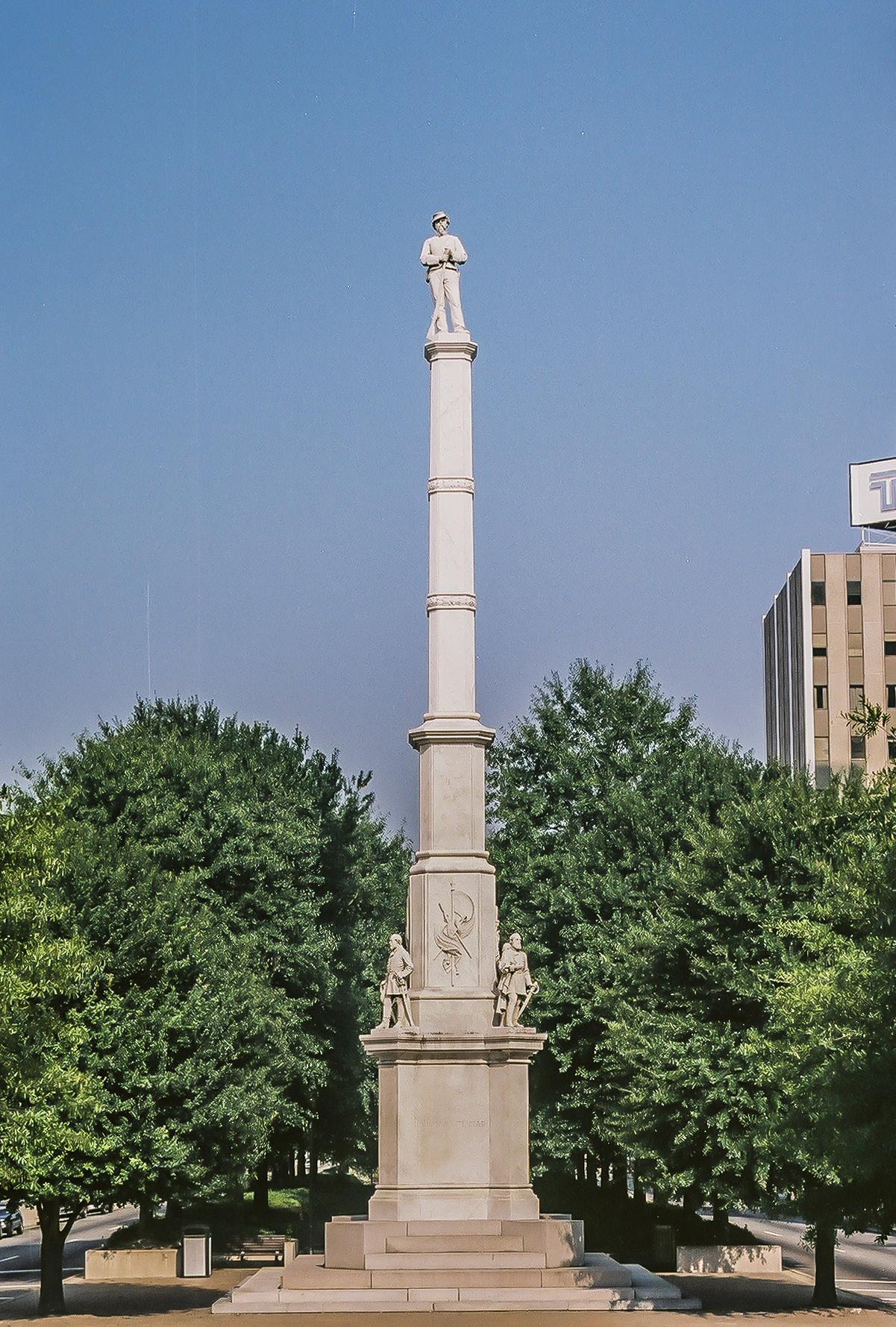
Greene Street, just two blocks south of Broad, is a long, beautiful avenue with a gardenlike median. A walk through this garden from west to east leads you past numerous monuments honoring men and women from all aspects of Augusta’s history, from one dedicated to the three Georgians who signed the Declaration of Independence
GEORGIA’S CONFEDERATE MONUMENTS

In Honor of a Fallen Nation
Gould B. Hagler, Jr.

This unique work contains a complete photographic record of Georgia’s memorials to the Confederacy, a full transcription of the words engraved upon them, and carefully-researched information about the monuments and the organizations which built them. These works of art and their eloquent inscriptions express a nation’s profound grief, praise the soldiers’ bravery and patriotism, and pay homage to the cause for which they fought.
866-895-1472
the Sabbath School who fell. Twenty-four names are inscribed here, names of men who prayed together in this single Methodist Church. Other surfaces list the other war dead of the county. The names are so numerous that they overflow the tablets designed for them and spill to the base below. Altogether nearly 300 men from this one community are honored by this modest cenotaph.
Another mournful monument, one perhaps even sadder than this one, is difficult to find. It is in a section of Richmond County which for many decades has been part of Fort Gordon. Before the area was acquired by the United States Government it contained farms, crossroads hamlets, and numerous country churches with their cemeteries. The churches are long gone, of course, but the cemeteries remain. At the intersection of two dirt roads is cemetery # 30, which contains the oldest Confederate monument in Georgia. It was built in June 1866 by the Linwood Sunday School. The War claimed the lives of 23 men from this tiny community. Like their comrades and fellow Christians from Saint James’, these men were killed in battle, died of wounds after days or weeks of suffering, succumbed to disease in camp or hospital, or went from this life to the next
while trapped in a dismal prison. During the Civil War over a quarter of a million men lost their lives in service to the Confederacy. Over 300,000 Union soldiers and sailors died. Numbers this huge tell of a vast armed struggle and remind us of the monstrous scale and long duration of the war. These big numbers tell us a lot, but the smaller numbers carry a different, and perhaps a more profound, kind of meaning. They scale the tragedy down from the level of the nation to the level of the community, the neighborhood, the church, and the family. The short lists of names from the Saint James’ Sabbath School in town and from the Linwood Sunday School in the countryside make an impression that is immediate and intensely personal. These letters inscribed in stone paint an image of a minister of God preaching to a congregation dressed in black. Everyone in church, including the clergyman, is in mourning. Everyone has lost a family member, a friend, or a comrade-in-arms.
Perhaps the minister is preaching on the themes of the two inscriptions on the Greene Street cenotaph. Immortalis est veritas read the words on one surface; Truth is immortal.
On another face Dulce et
to one honoring four Southern poets. Near the end of your stroll, after passing Fifth Street, you will encounter an obelisk built in 1873 by the Cenotaph Club and the Saint James’ Sabbath School. Like the monument on Broad, this one honors Richmond County men who lost their lives in the war.

A cenotaph is a sepulchral monument honoring a dead person or persons buried elsewhere. Many of the dead to whom this cenotaph is dedicated are buried far from home, many in unmarked graves, in places unknown to their loved ones. They went to war never to return, even in death.
The names of the dead are inscribed on the cenotaph. One tablet lists members of
26 CivilWarNews.com January 2023 26 January 2023 CivilWarNews.com
www.mupress.org
toll-free
Broad Street monument in Augusta. All photos by Gould Hagler.
Greene Street Cenotaph.
decorum est pro patria mori is inscribed; It is sweet and honorable to die for one’s country. I have always been puzzled by the first adjective in this quote. Perhaps some members of the congregation find it as odd as I do.





A version of this article appeared earlier in the Blue and Gray Dispatch.






Gould Hagler is a retired lobbyist living in Dunwoody, Ga. He is a past president of the Atlanta Civil War Round Table and the author of Georgia’s Confederate Monuments: In Honor of a Fallen Nation, published by Mercer University Press in 2014. Hagler speaks frequently on this topic and others related to different aspects of the Civil War and has been a regular contributor to CWN since 2016. His email is gould.hagler@gmail.com.
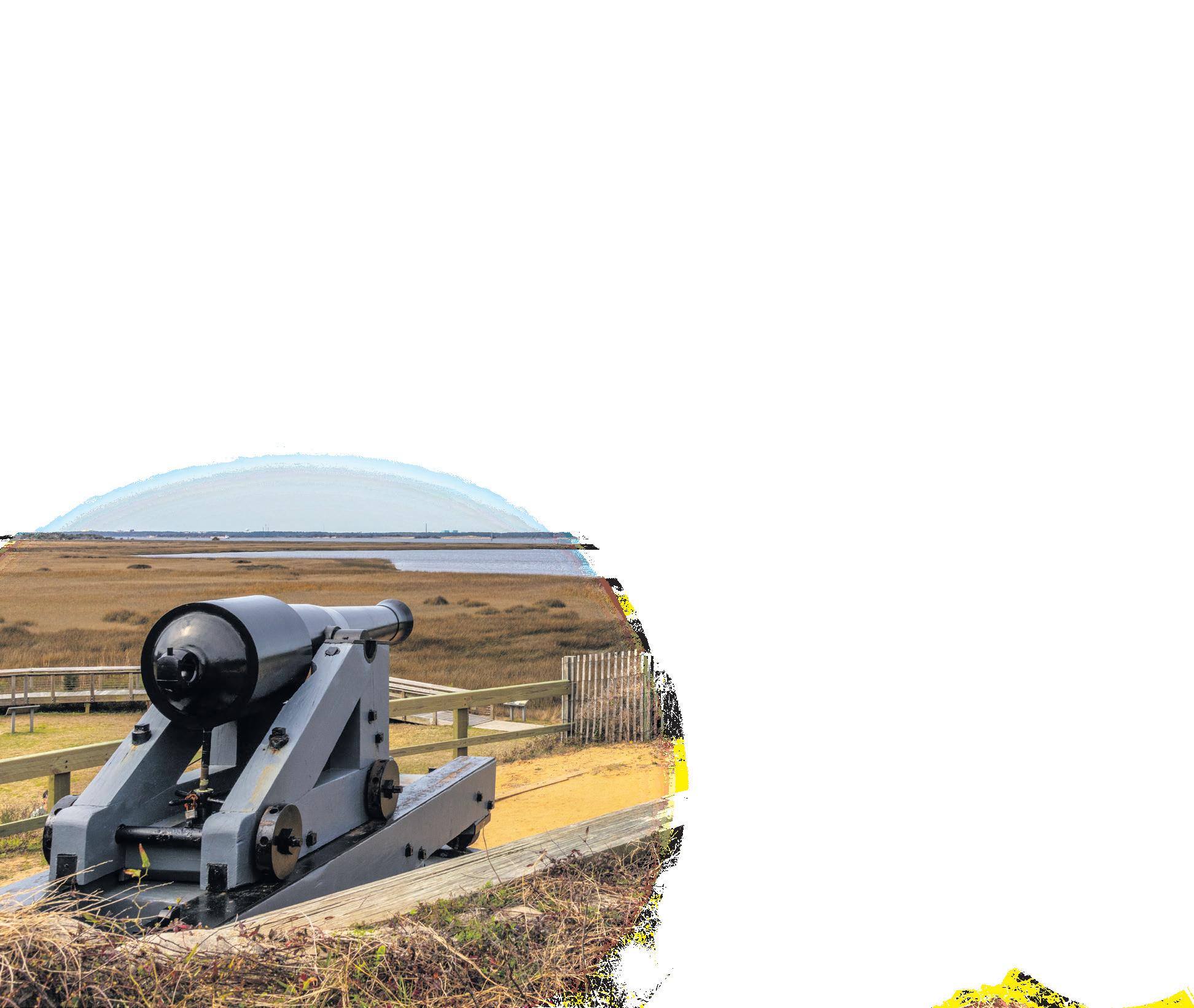
27
2023 27 January 2023 CivilWarNews.com CivilWarNews.com
January
Memorial in cemetery #30, Fort Gordon.
Contact Mike at: 910-617-0333 • mike@admci.com Provenance a Must! Fort Fisher items wanted Publishers/Authors Send your book(s) for review to: Civil War News 520 Folly Road, Suite 25-379, Charleston, SC 29412 48 E. Patrick St., Frederick, MD. 301-695-1864 / civilwarmed.org Divided by Conflict. United by Compassion. – MAKER –LEATHER WORKS (845) 339-4916 or email sales@dellsleatherworks.com WWW. DELLSLEATHERWORKS.COM
41st Annual Central Virginia Military Antique Show





HENRICO COUNTY, Va.—
The 41st annual Central Virginia Military Antique Show was held on November 12, at the Richmond Raceway Complex. Formerly called the “Capital of the Confederacy Show,” this is one of the three longest running predominantly Civil War shows in the country. Throughout its long history it was affiliated with the Central Virginia Civil War Relic Collectors Association, but in recent years the primary show promoter passed from Mike Kent to Carl Sitherwood and Mike Ward of BulletAndShell.com.
On a gorgeous fall day, attendance was up nearly 25% over the previous year. Starting with a healthy line at the show’s opening, a steady stream of hundreds of customers poured in to view the historical military items shown on over 200 dealer and display tables. To get the word out and boost attendance, a large amount of advertising money was spent promoting the show via print, social media, and signage in a 50-mile radius.
The show promoters had arranged for several large, newto-the-market collections to be put up for sale exclusively at this event. This created a huge buzz and added meaningfully to the abundance of reasonably priced items to buy. Many dealers commented on how strong sales were.
Without doubt, this is the leading show for Civil War
artillery. There was more Civil War ordnance material for sale here than at any show in recent memory. Noted Civil War artillery projectile authors were set up along with several top collectors in the field. Jim Thomas, another Civil War author, was helping staff The Horse Soldier’s tables. Jim generously donated copies of his book as door prizes as did Ransom Hundley, Jim Scarr, and Historical Publications LLC. More than a dozen display tables made the four show award judges’ work challenging. When the final scorecards were tabulated there were three show prizes to give out. They were: Historical significance award went to Gerald C. Roxbury for “Confederate Naval Cutlasses”; Most Educational to Mike Wright for “My Father’s Relics”; and Best of Show to Mark Ramer for “Civil War Fuses.”
Attendees were enormously appreciative of the displays and nonprofit informational booths. Several commented as to how educational exhibitions had fallen off in recent years and how nice it was to have them back in healthy numbers. There was great appreciation from the show promoters, dealers, and attendees alike for the hard work put into displaying and the sharing of the fantastic relics. Best of Show winner, Mark Ramer admitted to having worked getting his display ready for over two years.
Uniformed Henrico County policemen acting as part of the round-the-clock security coverage team reported no incidents. Many guests also attended the modern gun show being held next door in the other raceway facility building. The remarkable show results and turnout speak loudly in support of the hobby, especially after some other shows have struggled recently. Saving the best news for last, it was announced that the show will go on again on November 18, 2023 for its 42nd year. This is a weekend later than 2022 to eliminate a date conflicting with the Richmond Marathon and the
some amazing relics.
28 CivilWarNews.com January 2023 28 January 2023 CivilWarNews.com
Central Virginia Civil War Relic Collectors Club table with
Mike Ward, show co-sponsor, stands behind BulletAndShell.com tables loaded with, of course, bullets and shells.
Tulsa Gun Show. Many dealers have already voiced support for this date change so there is every reason to believe that the show will be even bigger next year. Visit www.TheRelicShow.com for additional information and table reservations.
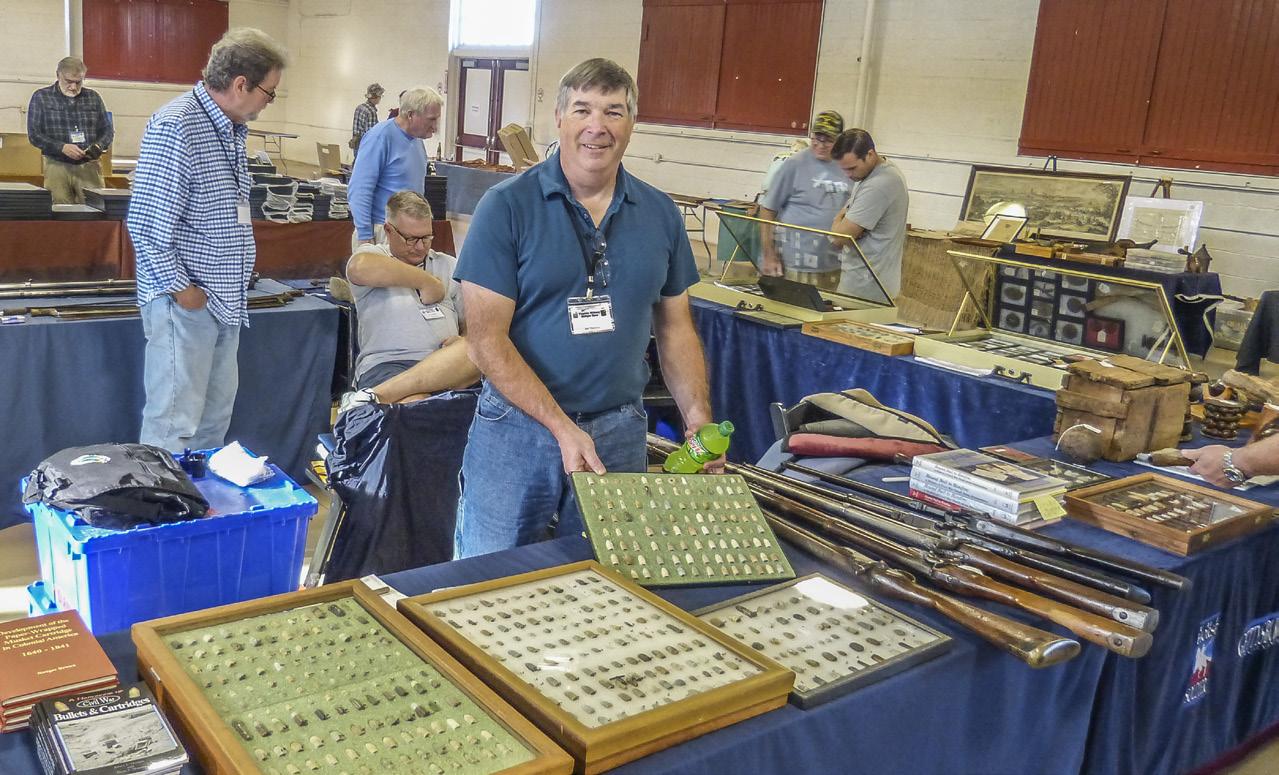




The Central Virginia Show is proud to announce the show will be even bigger and better next year. Due to a Racetrack construction project the show will be hosted at the Meadow Event Park in Doswell, Va. Note that it will be a week later than last year on November 18th.

ll29 January 2023 29 January 2023 CivilWarNews.com CivilWarNews.com Promoters of Quality Shows for Shooters, Collectors, Civil War and Militaria Enthusiasts Mike Kent and Associates, LLC • PO Box 685 • Monroe, GA 30655 (770) 630-7296 • Mike@MKShows.com • www.MKShows.com February 4 & 5, 2023 Chickamauga (Dalton) Civil War Show December 2 & 3, 2023 Middle TN (Franklin) Civil War Show
Jim Thomas shows off a tremendous selection of bullets at The Horse Soldier’s table.
Attendees looking for a deal at the show. Plenty of dug and non-dug artifacts were available for purchase at the show.
Mike Wright proudly shows his award winning display of “My Father’s Relics” to an interested patron.
Tom and Debbie Hays of Stones River Trading Company talking relics with Bill Irvin of Perry Adams Antiques.
Charting a More Perfect Union homepage.
Georgia search results coast survey.

Researchers seeking information on coastal operations during the American Civil War will benefit from mining the collection of almost 500 wartime maps and sketches of fortifications, as compiled through the Office of Coast Survey. These maps and illustrations and various publications populate the Charting a More Perfect Union website at https://historicalcharts. noaa.gov/CivilWar/index.html.
The image at the top shows that users can conduct searches using various criteria. The writer selected Georgia in the ‘State or Region’ box for this example. The results yielded 30 archival

hits, which one can sort in various methods. See the search results image above..
On the top right is the image of the fortification on Sapelo Island, Ga., as drawn in 1863. Various sketches of the fortifications protecting Savannah reside in this database, including a detailed drawing of Forts Tattnall and Lee in the Savannah River (see image on the right). Spend some time investigating this material, which covers many sections of the country.

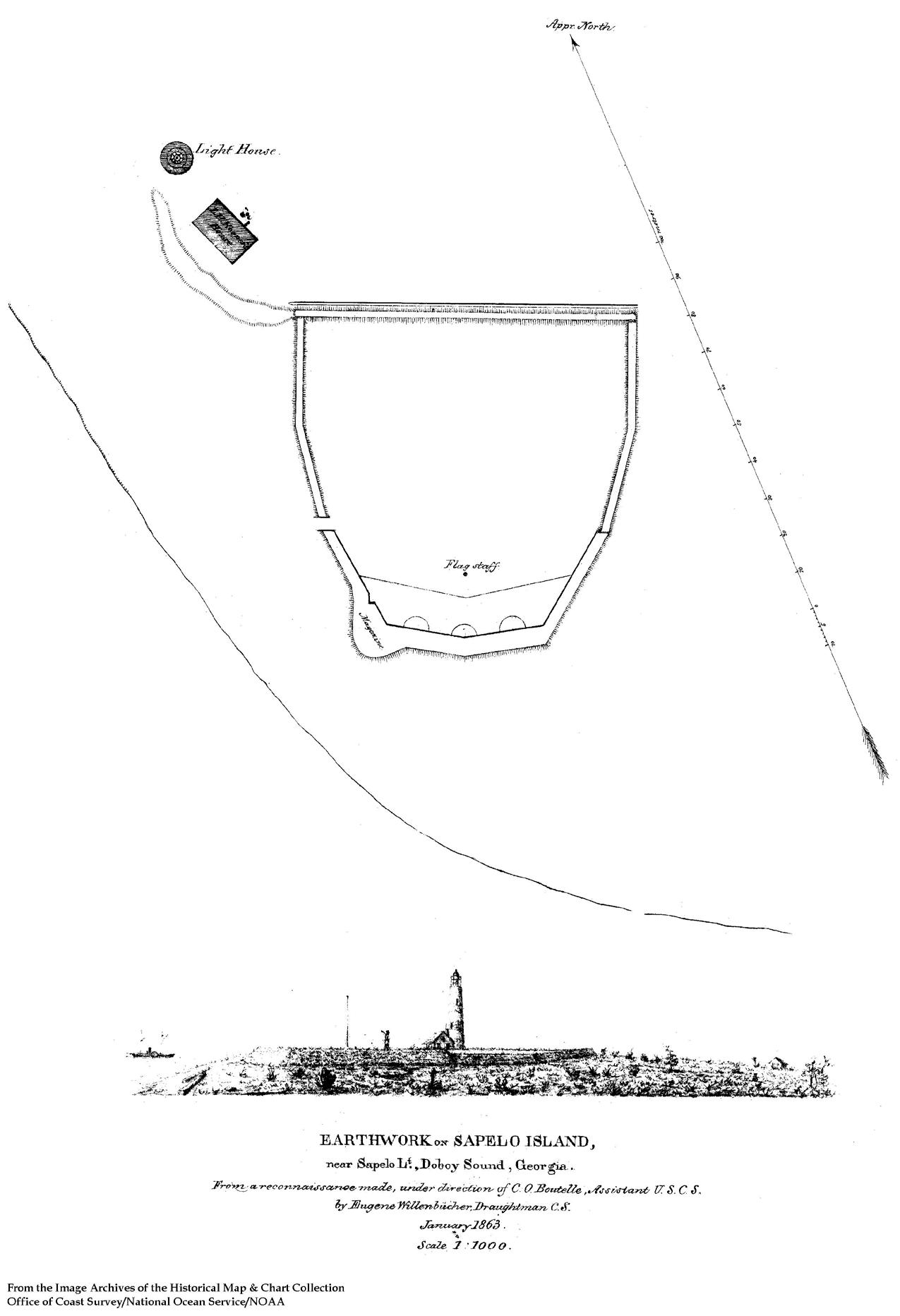
Next month’s column will explore Civil War publications housed on the Office of Coast Survey website. Until then,
continued luck in researching the American Civil War!
Michael K. Shaffer is a Civil War historian, author, lecturer, and instructor, who remains a member of the Society of Civil War Historians, Historians of the Civil War Western Theater, and the Georgia Association of Historians. Readers may contact him at mkscdr11@gmail.com or request speaking engagements at www.civilwarhistorian. net. Follow Michael on Facebook, www.facebook.com/ michael.k.shaffer, and Twitter @ michaelkshaffer.

30 CivilWarNews.com January 2023 30 January 2023 CivilWarNews.com Visit our new website at: HistoricalPublicationsLLC.com Deadlines for Advertising or Editorial Submissions is the 20th of each month.
Charting a More Perfect Union NOAA’s Historical Map & Chart Collection
Sapelo earthworks.
Forts Tattnall and Lee.
Until now, a daily account (1,630 days) of Georgia’s social, political, economic, and military events during the Civil War did not exist. In Day by Day through the Civil War in Georgia, Michael K. Shaffer strikes a balance between the combatants while remembering the struggles of enslaved persons, folks on the home front, and merchants and clergy attempting to maintain some sense of normalcy. Maps, footnotes, a detailed index, and bibliographical references will aid those wanting more.






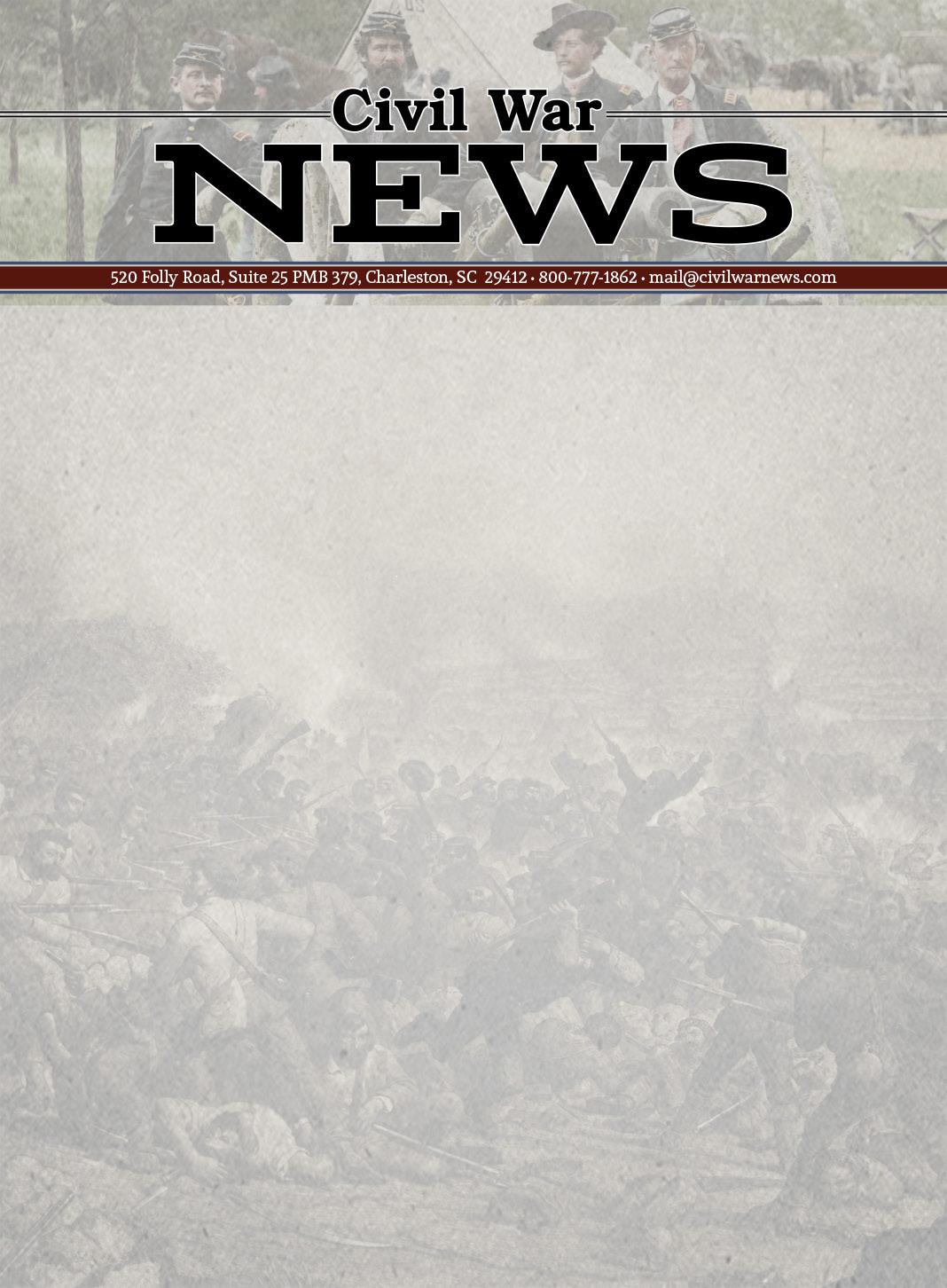


February 2022 • $37.00, hardback
Michael K. Shaffer is a Civil War historian, instructor, lecturer, newspaper columnist, and author. He is a member of the Society of Civil War Historians, Historians of the Civil War Western Theater, and the Georgia Association of Historians. Contact the author: mkscdr11@gmail.com







www.mupress.org • 866-895-1472 toll-free



31 January 2023 31 January 2023 CivilWarNews.com CivilWarNews.com
Day by Day through the Civil War in Georgia
Join the Crew! civilwarnavy.com 1 Year—4 Issues: $37.95 Subscribe Now at civilwarnavy.com Or send a check to: CSA Media, 29 Edenham Court, Brunswick, GA 31523 International subscriptions subject to postage surcharge. Publishers/Authors Send your book(s) for review to: Civil War News 520 Folly Road, Suite 25-379 Charleston, SC 29412 bookreviews@civilwarnews.com Presented By: MID-SOUTH MILITARY HISTORY & CIVIL WAR SHOW midsouthmilitaryhistory@gmail.com | facebook.com/MilitaryHistoryCivilWarShow (901) 832-4708 or (662) 279-0538 Historical Publications, LLC Civil War News • 800-777-1862 520 Folly Road, Suite 25 PMB 379 Charleston, SC 29412 www.CIVILWARNEWS.com UP-TO-DATE COVERAGE • PRESERVATION NEWS • BOOK REVIEWS SHOWS, LIVING HISTORY AND REENACTMENTS • HISTORICAL ARTICLES MONTHLY COLUMNS • CALENDAR OF EVENTS STAY INFORMED! Only $41.00/One Year • $71.00/ Two Years THE MONTHLY CURRENT EVENTS NEWSPAPER -FORCIVIL WAR ENTHUSIASTS SINCE 1974 12 ISSUES PER YEAR PRINT & DIGITAL EDITIONS AVAILABLE CALL OR SUBSCRIBE ONLINE TODAY! 2018 46, $3.50 America’s Monthly Newspaper For War Enthusiasts Never-Before Seen Scrapbook Sheds New Light—Provides Valuable Insights heated the Lincoln’s governorssupportpresident’s for Lincoln nervous Troops ground, D.C., mattered peoplethe Virginia sympathizers Washington, kidA maintained Roosaing provides insightssion nation’scorrespondence, souvenirs Roosa Newproximately patrioticcovers commented aspects and the collection particular militia regiments early the secessioncompromise be militia took seriously. January General Sandford, commander Division division wasn’t provoke offer declined. earlier, January South West attemptinggarrison, Military Association Majorsupport. the frontation, over simmered brought front other expedition. approaching Charleston when Charleston opened Sumter North complacent November 2020 $3.50 America’s Monthly Inside this issue: preservationist surrounded Theater,-As onescribedHistory and Preservation Community Mourns: The Loss of Legendary Historian Edwin Cole Bearss amongguide, travelling and knowledge, passion protecting organizationsBearss early age,After countryfollowed Marine JanuarylimitedEd Bearss’ All Time Favorite Civil War Books Partridgebest four newspawould stopbetween Expanded November Book INSIDE EVERY ISSUE Want To Advertise In Civil War News? Email us at ads@civilwarnews.com Call 800-777-1862 28 Emerging Civil War 14 The Unfinished Fight Chris Mackowski, Bonaventure University’s Jandoli was honored by the American organization devoted to focused on the protection of Through educational programs the trust also informs the public of our nation’s history. teacher workshops to his tours to Mackowski Receives Outstanding Service Award from American Battlefield Trust conducting tours, and writing initiatives for endangered Civil and unexpected honor for me,” has given me some amazing there for those opportunities. It’s celebrated its 20th year 2022, days workshops, battlefield and pivotal conflicts of America’s the trust spearheaded the creation At this year’s in-person presented workshop on the teaching Civil War controversy Chris Mackowski (right) accepts an award for outstanding service from the American “virtual field trip” for the trust on He has authored, co-authored, or appeared in all the major Civil Trust, regional battlefield Congress property on the Spotsylvania Subscribe online at CivilWarNews.com Visit our new website at: HistoricalPublicationsLLC.com
Why Robert E. Lee Still Matters
In Richmond, there’s a movement afoot to rename the Robert E. Lee Memorial Bridge. At Charlottesville, a statue to the Confederate general was removed last year. In Abilene, Texas, Lee Park, named after the general, has been changed to that of a local football coach.
The list could go on and on, as we’ve all seen.
But let’s step back from all the dither. Remember George C. Scott, the star of Patton (1970)?
In 1976, the country’s Bicentennial year, NBC’s Today show featured, every Friday, a full two-hour program highlighting one of the fifty states. The show focusing on Virginia offered local scenery, historical highlights and personal glimpses.
Scott presented one of them. As backdrop for his monologue, Scott led a walking tour of the campus of Washington and Lee University in Lexington. As he did so, he talked about General Lee before entering the Chapel to stand beside Valentine’s famed recumbent statue.
“What are you and I supposed to learn from or feel about the world and the character of a man like R. E. Lee?” he asked. “He’s cold. We’re cool. He’s passe. We’re avant. He’s out of it. We’re up to here in it.”
“Well,” Scott continued, “there are a few qualities this remarkable creature had which may serve us too, if we consider them.” Patience.
Quiet good humor. Adoration of children. Loyalty.
Respect for hard work. Dedication to an ideal.
Love of animals. Appreciation of duly constituted authority— coupled with an abhorrence of authoritarianism.
A devotion to history, for, as General Lee said, “It is history that teaches hope.” Gentleness, and the aspiration to achieve gentlemanliness.
Understanding of the state of being young.
Courtesy toward the conditional frailty of advanced age. Acceptance of responsibility.
Personal integrity.
With that, Scott ended. His monologue was so instantly popular that W & L was besieged with reprint requests. The University contacted Scott, secured his text and reprinted it as a pamphlet (which is how I obtained it).1
I believe that Scott’s assessment of Lee’s character, which is still shared by millions of Americans, should outshine and overshadow all the kerfuffle about Lee being a “rebel,” a slaveholder and all the other stuff we’ve been hearing.
A lot of people these days are bemoaning the scarcity of heroes today in America. I answer that all one has to do to find them is to look back to history and its leading figures…especially Robert E. Lee. As for slavery, yes, Lee was a slaveholder by inheritance, but he eventually freed his slaves. As for the South’s peculiar institution, Lee, as John M. Taylor has recently written, was one “of enlightened Americans who deplored slavery but who could see no immediate solution.”2 As early as late 1856, Lee was confiding to Mary that he did not see the possibility of peaceable emancipation, but rather that abolition “can only be accomplished by them through the agency of a civil and servile war.”3 Besides, like many others, Lee could not foresee an answer to the question of what to do with the freed people?
I return to Ezra J. Warner’s declaration in Generals in Gray that Lee is “perhaps the most universally revered of American soldiers.”4 That was in 1959. I believe it still is.
No more salient reflection of Lee’s character is to be seen than in how Lee responded to the secession crisis of 1861, in particular to the departure from
the Union of his home state of Virginia. Lee opposed the concept of state secession, but as early as January 29, 1861, he had written to Rooney, his second eldest son, that “a Union that can only be maintained by swords and bayonets, and civil war that are to take the place of brotherly love and kindness, has no charm for me.”5
By the time of Fort Sumter, seven Southern states had seceded. Lincoln’s call for 75,000 volunteers to suppress the rebellion prompted a convention in Richmond to pass an ordinance of secession on April 17.6 “Now Virginia had forced him to act,” writes Earl Scheck Miers. At the time Lee was at Arlington, across the river from Washington. There he received a request from Francis Blair, close friend of Lincoln, and also from General Scott, to meet them the next day. Lincoln had authorized Blair to “ascertain Lee’s intentions and feelings.”7
Lee went first to the Blair home on Pennsylvania Avenue. There, by order of Secretary of War Simon Cameron, he offered Colonel Lee promotion and command of the U.S. Army for the purpose of putting down the insurrection.8
Various of Lee’s biographers have tried to reconstruct the two officers’ conversation, which centered on Lee’s declaration of intent to resign from the service. John Esten Cooke, writing just a year after Lee’s death, has Blair exclaim, “For God’s sake, don’t resign, Lee!”9 “If I owned the four millions of slaves in the South, I would give them all up to save the Union, but how can I draw my sword upon Virginia, my native state?” Mary Williamson (1895) has Lee asking.10 Similarly, in a biography billed as “for boys and girls,” J. G. de Roulhac Hamilton and Mary Thompson Hamilton, writing in 1917, have Lee telling Scott, “If I owned four millions of slaves, I would cheerfully sacrifice them for the preservation of the Union, but to lift my hand against my own State and people is impossible.”11

In 1934 there appeared the first volume of Douglas Southall Freeman’s long-awaited biography of Lee. Dr. Freeman captures Scott’s reaction to Lee’s statement of intent: “Lee, you have made the greatest mistake of your life; but I feared it would be so.” Scott went on, advising the fifty-four year-old colonel that he should resign at once: “your present attitude is equivocal.”12
Most historians, though, focus not on what Colonel Lee said to General Scott, but what he wrote to him. The Rev. J. William
Jones, pastor of Lexington’s Baptist Church during Lee’s tenure as president of Washington College, wrote one of the early biographies of the General. In it he quotes in full the letter Lee wrote Scott two days after their meeting, in which Lee announced his resignation from the United States Army. He explained that he would have submitted it sooner “but for the struggle it has cost me to separate myself from a service to which I have devoted the best years of my life and all the ability I possessed.”13 Fitzhugh Lee, the General’s nephew, quotes it as well in his biography of 1894.14 Another exConfederate, Walter H. Taylor (AG for the ANVa), alludes to the Lee-Scott exchange, too, in his General Lee: His Campaigns in Virginia 1861–1865 with Personal Reminiscences.15
Thomas Nelson Page (1853–1922), known primarily as a Southern novelist popular even in the North during the 1880s, turned his attention to Lee in a biography appearing in 1911. In a chapter titled, “The Choice of Hercules,” Page quotes from the letter Lee wrote to Reverdy Johnson, a Baltimore attorney, in 1868: “I declined the offer he made me to take command of the army in the field, stating as candidly and courteously as I could that, though opposed to secession and deprecating war, I could take no part in the invasion of the Southern States.”16
Lee’s letter to Reverdy Johnson has become a staple of the Lee literature. It’s in Robert E. Lee and the Southern Confederacy by Henry Alexander White, a history professor at Washington and Lee (published in 1897), J. William Jones, Life and Letters of Robert Edward Lee Soldier and Man (1906), as well as other works.17
Gamaliel Bradford dug up a primary source in his Lee the American (1912). Citing Gen. Edward D. Townsend as the only witness to the Lee-Scott meeting, and Townsend’s Anecdotes of the Civil War (1883), Bradford gives this account of the event:
General Scott knew that he [Lee] was at Arlington Heights, at the house of his father-in-law, Mr. Custis, and one day asked me if I had ever seen or heard of him lately. I replied in the negative, except that he was on leave and at Arlington Heights. Said the general, “It is time he should show his hand and if he remains loyal should take an important command.” I then suggested that I should write a note to Lee and ask him to call at
the general’s headquarters. “I wish you would,” replied the general. The note was written and the next day, April 19, 1861, Colonel Lee came to the office. The general’s was the front room of the second story. His round table stood in the center of the room and I had a desk in one corner. The aides were in an adjoining room with a door opening into the general’s. When Lee came in, I was alone in the room with the general and the door to the aides’ room was closed. I quietly arose, keeping my eye on the general, for it seemed probable he might wish to be alone with Lee. He, however, secretly motioned me to keep my seat and I sat down without Lee having a chance to notice that I had risen. The general having invited Lee to be seated, the following conversation, as nearly as I can remember, took place. Gen. Scott: “You are at present on leave of absence, Colonel Lee?” –Col. Lee: “Yes, General, I am staying with my family at Arlington.”—Gen. Scott: “These are times when every officer in the United States service should fully determine what course he will pursue and frankly declare it. No one should continue in government employ without being actively employed.” (No response from Lee.)— Gen. Scott (after a pause): “Some of the Southern officers are resigning, possibly with the intention of taking part with their States. They make a fatal mistake. The contest may be long and severe, but eventually the issue must be in favor of the Union.” (Another pause and no reply from Lee.)—Gen. Scott (seeing evidently that Lee showed no disposition to declare himself loyal or even in doubt): “I suppose you will go with the rest. If you purpose to resign, it is proper you should do so at once; your present attitude is an equivocal one.”—Col. Lee: “the property belonging to my children, all they possess, lies in Virginia. They will be ruined, if they do not go with their State. I cannot raise my hand against my children.”18
Of Scott’s suggestion— demand?—that Lee resign, Clifford Dowdey writes in 1965, “If Lee could not accept an offer to lead a United States Army, he should resign his commission.” And that’s what he did.
32 CivilWarNews.com January 2023 32 January 2023 CivilWarNews.com
General Scott was surely disappointed, as Dowdey observes, “It was known that Scott was finagling to hold a number of Southern officers in the army, that Lee was his favorite soldier.”19
It is interesting that biographer James C. Young doesn’t mention Lee’s meeting with Scott of April 18, but in a chapter entitled “Lee Faces His Tragedy” he dwells on the letter Lee wrote on the night of April 20.
After dinner he asked to be alone, going to his room on the upper floor.
In a room below Mary waited as the man above faced his tragedy. The servants went on tiptoe, the white of their eyes showing large, in the way of the black man when his spirit troubles him. At intervals Mary heard Lee’s voice in the mutter of an invocation for higher guidance. Then his step sounded again, the pace of a soldier, back and forth across the floor.
When he paused, and there was no sound, she went into the hall, expecting him. A long hour passed, yet he failed to come. When had another captain of history undergone such trial? Caesar at the Rubicon, Napoleon debating whether he should save the Revolution, suffered little but the pangs of interest. Lee, the religious man, the patriot, the moralist in his wish “to do right,” suffered profoundly, sorrowing for his country and his honor.
When he did descend he came with resolute face, lighted by the inner fire of the man’s fine soul, burning in a white flame this night. And he said simply, almost cheerfully: “Well, Mary, the question is settled. Here is my letter of resignation, and a letter I have written to General Scott.”
Only the Fates, who looked on to see man and woman in close embrace, could know the import of those words. General Scott, in Washington, received the letter the next day, memorable for its concluding words, “Save in defense of my native State, I never desire again to draw my sword.”20
In his life-study of Lee (1934), Robert Winston summarizes Lee’s meeting with Frank Blair and Winfield Scott on April 18, but focuses more on the letter Lee wrote to the aged general on the 20th: “To no one, General,
have I been as much indebted as yourself, for uniform kindness and consideration, and it has always been my ardent desire to merit your approbation. I shall carry to the grave the most grateful recollections of your kind consideration, and your name and fame shall always be dear to me.”21 “Well, Mary,” Lee told his wife after having composed his letter to Scott, “the question is settled.”22
Lee explained his position in letters to relatives. To his sister Ann he affirmed, “I have not been able to make up my mind to raise my hand against my relatives, my children, my home….Save in defence of my native State, with the sincere hope that my poor services may not be needed, I hope I may never be called on to draw the sword.”23
With his usual acerbity, Emory Thomas writes of Lee’s decision:

Had Lee chosen to remain in the United States Army or had he resigned and only raised corn while other men fought and died, he would have elected infamy. He would have had to spend the rest of his life explaining his actions to deaf ears. And not the least of a legion of accusers would have been his own wife, who became a fiercely partisan Confederate. Robert Lee would have been most in danger in his own bed.24
Remarkably, Michael Korda, in his recent biography of Lee (2014) misses the drama of this event, writing merely that in his meeting with Scott, “Lee presumably made his position clear.”25
It may not be too much to say that in such breezy asides, modern historians are willfully overlooking the sterling qualities of, as Scott described him, “this remarkable creature.” But every time I travel to Lexington—my grandson is a junior at W & L— you can bet I’m not thinking of the Generals’ chances on the football field (sorry, Hunter!), but on General Lee and the vast and clenching hold he has on my consciousness, and my heart.
Endnotes
1. George C. Scott, Notes on a Visit to Robert E. Lee (Lexington: Washington and Lee University, 1980), 9-10.
2. John M. Taylor, Duty Faithfully Performed: Robert E. Lee and His Critics (Dulles VA: Brassey’s, 1999), 41.
3. Allen C. Guelzo, Robert E. Lee: A Life (New York: Alfred A. Knopf, 2021), 145.
4. Ezra J. Warner, Generals in Gray: Lives of the Confederate Commanders (Baton Rouge: Louisiana State University Press, 1959), 179.
5. Michael A. Fellman, The Making of Robert E. Lee (New York: Random House, 2000), 87; Randolph H. McKim, The Soul of Lee (New York: Longmans, Green and Co., 1918), 25.
6. Emory M. Thomas, Robert E. Lee: A Biography (New York: W. W. Norton, 1995), 187-88.
7. Earl Schenck Miers, Robert E. Lee: A Great Life in Brief (New York: Alfred A. Knopf, 1956), 27; Charles R. Knight, From Arlington to Appomattox: Robert E. Lee’s Civil War Day by Day, 1861–1865 (El Dorado Hills CA: Savas Beatie, 2021), 2.
8. Douglas Southall Freeman, R. E Lee, 4 vols. (New York: Charles Scribner’s Sons, 1934-35), vol. 1, 436-37.
9. John Esten Cooke, Robert E. Lee (New York: G. W. Dillingham, 1871), 28.
10. Mary L. Williamson, The Life of Gen. Robert E. Lee for Children, in Easy Words (Richmond: Johnson Publishing Co., 1895), 41.
11. J. G. de Roulhac Hamilton and Mary Thompson Hamilton, The Life of Robert E. Lee for Boys and Girls (Boston: Houghton Mifflin, 1917), 95.
12. Freeman, Lee, vol. 1, 437.
13. J. William Jones, Personal Reminiscences of General Robert E. Lee (Richmond: United States Historical Society Press, 1989 [1875]), 138-39.
14. Fitzhugh Lee, General Lee (Wilmington: Broadfoot Publishing Company, 1989 [1894]), 88.
15. Walter H. Taylor, General Lee: His Campaigns in Virginia 18611865 with Personal Reminiscences (Dayton OH: Press of Morningside Bookshop, 1975 [1906]), 20.
16. Thomas Nelson Page, Robert E. Lee Man and Soldier (New York: Charles Scribner’s Sons, 1911), 40. The mythic Hercules had to choose between pleasure and virtue. The strongman’s dilemma was dramatized by Handel in an oratorio (1750).
17. Henry Alexander White, Robert E. Lee and the Southern Confederacy 1807-1870 (New York: Haskell House Publishers, 1968 [1897]), 100; J. William Jones, Life and Letters of Robert Edward Lee Soldier and Man (Harrisonburg VA: Sprinkle Publications, 1986 [1906]), 131-32.
18. Gamaliel Bradford, Lee the American (Boston: Houghton Mifflin, 1912), 30-31.
19. Clifford Dowdey, Lee (Boston Little, Brown and Company, 1965), 130, 133.
20. James C. Young, Marse Robert: Knight of the Confederacy (New York: Rae D. Henkle Co., 1929),
84-85.
21. Robert W. Winston, Robert E. Lee: A Biography (New York: Grosset & Dunlap, 1934), 90.
22. Burke Davis, Gray Fox: Robert E. Lee and the Civil War (New York: Fairfax Press, 1981 [1956]), 15.
23. Margaret Sanborn, Robert E. Lee: A Portrait [1807-1861], 2 vols. (Philadelphia: J. B. Lippincott Company, 1966-67), vol. 1, 314; Frederick Maurice, Robert E. Lee the Soldier (Boston: Houghton Mifflin, 1925), 56-57.
24. Thomas, Lee, 190.
25. Michael Korda, Clouds of Glory: The Life and Legend of Robert E. Lee (New York: HarperCollins, 2014), 225.
Stephen Davis of Cumming Ga., is a native Virginian who’s been reading about Robert E. Lee since the fourth grade. Now retired, he’s writing a faux autobiography of General Lee. In his Introduction, Steve writes how the priceless manuscript came into his possession.
General Lee and the Sparrow
In his Memoirs of Robert E. Lee (1887), Armistead L. Long, who had served on the General's staff, relates this story:
At some point in the Petersburg Campaign, Lee was visiting a battery, drawing a crowd of soldiers near him. “Men,” he admonished, “you had better go farther to the rear; they are firing up here, and you are exposing yourselves to unnecessary danger.”
General Long picks up the story:
The men drew back, but General Lee, as if unconscious of danger to himself, walked across the yard, picked up some small object from the ground, and placed it upon the limb of a tree above his head. It was afterward perceived that the object for which he had thus risked his life was an unfledged sparrow that had fallen from its nest. It was a marked instance of the love for the lower animals and deep feeling for the helpless which he always displayed.
Long thought so much of this anecdote that he had William Ludwell Sheppard, one of the most noted exConfederate illustrators, render a drawing, “General Lee and the Sparrow,” for his Memoirs (1887).
I don't know if this incident actually occurred. But the important point, I think, is that Southerners believed it was in keeping with the soul and character of Robert E. Lee that Sheppard's illustration was commissioned.
Edited with commentary by Stephen Davis, I Thank the Lord I Am Not a Yankee includes selections of her wartime and postwar journals which are most expressive of her Confederate patriotism and Southern pride.

February 2023 • $35.00, hardback Stephen Davis is author of ten books on the Civil War, most of which treat the Atlanta Campaign. His two recent volumes on Confederate General John Bell Hood have won several prizes, including the Fletcher Pratt Award of the New York CWRT.
www.mupress.org
866-895-1472 toll-free www.mupress.org
33 January 2023 33 January 2023 CivilWarNews.com CivilWarNews.com
Eliza Frances Andrews (1840–1931) received a strong education and was a successful writer and educator. Her War-Time Journal of a Georgia Girl surely ranks among the most observant and intelligent wartime memoirs by a Southern woman.
“I Thank the Lord I Am Not a Yankee...”
www.emergingcivilwar.com

From the Editor
Each fall semester, as we head into Thanksgiving, I challenge my students to notice things. As writers, they’ll need to constantly stay alert to the world around them for story ideas, but because we all fall into our daily routines or get sucked into our cellphone screens as we walk about, we forget to stay in tune with our surroundings. I challenge them to take their “horse blinders” off and pay attention to the world around them. Importantly, I don’t tell them to “look around” or to “see”—I tell them to “notice.” They need to practice using all five senses. It’s a vital professional skill.
My timing for this assignment is intentional because the exercise goes beyond mere professional usefulness. Noticing the world around us keeps us from taking it
for granted. It helps remind us to be grateful; and therein lies one of the great secrets of happiness: a grateful life is a happy life. It’s a joyful life.
My favorite expression of this notion comes from a Benedictine monk named Brother David Steindl-Rast. He has a TED talk you can watch on YouTube, which is well worth your time. He’s also featured in a stunningly beautiful, short documentary by Louie Schwartzberg called “Beauty. Nature. Gratitude.”
Schwartzberg showed off a clip from the film as a TED talk, also available to watch on YouTube. I can’t recommend these videos highly enough.
As we remember to give thanks this year, let us remember that the world around us is full of things to be grateful for; and in giving thanks, we can find joy.
– Chris Mackowski, Ph.D. Editor-in-Chief, Emerging Civil War
Happy Thanksgiving
For ECW’s November newsletter, we deviated from our usual line-up of articles. To celebrate Thanksgiving, we’ve asked members of the ECW community to share the things they’re most thankful for this year. We assumed everyone was thankful for family and friends, so we asked folks what else they’re thankful for.
Sarah Kay Bierle: This may sound backwards at first: I’m thankful for the pain I’ve
experienced while doing research and public history this year because it’s making me stronger and more resilient. From some awful discoveries in archives to some horrific comparisons between the Ukrainian conflict and the American Civil War, and some disturbing questions/ conversations about past and present, this year has stretched my mental and emotional limits of working in public history. I might wish the circumstances had been different, but I can see how events and findings this year are hopefully making me a better researcher and a more compassionate individual. For that, I am thankful. I’m also sincerely grateful for a few people connected to ECW who didn’t let me walk through those moments or weeks alone.
Sheritta Bitikofer: I am thankful for good health and for the positive chances of good outcomes in everything we do. I’m thankful for a husband who continues to be stubbornly supportive of the dreams we make together. I’m unendingly thankful for good smelling candles and yummy comfort food, which I hope to enjoy a lot of in the next couple of months. I’ll always be thankful for well-rested nights and productive days, though they may come infrequently. I’m grateful for the new roof over our heads and the love that lives within the walls. I’m thankful, in advance, for all the good things coming our way in the holiday season and new year; and to be cheesy, I’m thankful for the love, patience, and compassion of our family and friends through all the trials and difficulties that life brings.
Neil Chatelain: I would like to say thanks to my many students from over the years. Every day is a new challenge, but it is also an opportunity to work with the next generation. Doing so gives me hope for the future and challenges me to become a better teacher and historian as a whole.
Doug Crenshaw: I’m thankful for the friends who have really helped me through a tough year, also very grateful for the opportunity to share history with others.
David Dixon: I am thankful for my kind and generous colleagues in the history business who have read chapters, manuscripts, and blog posts and offered constructive criticism to improve my work. I am also thankful that more readers and historians are challenging traditional paradigms and prompting all of us to think about history in new ways.
Bert Dunkerly: I am thankful for the hard work done behind the
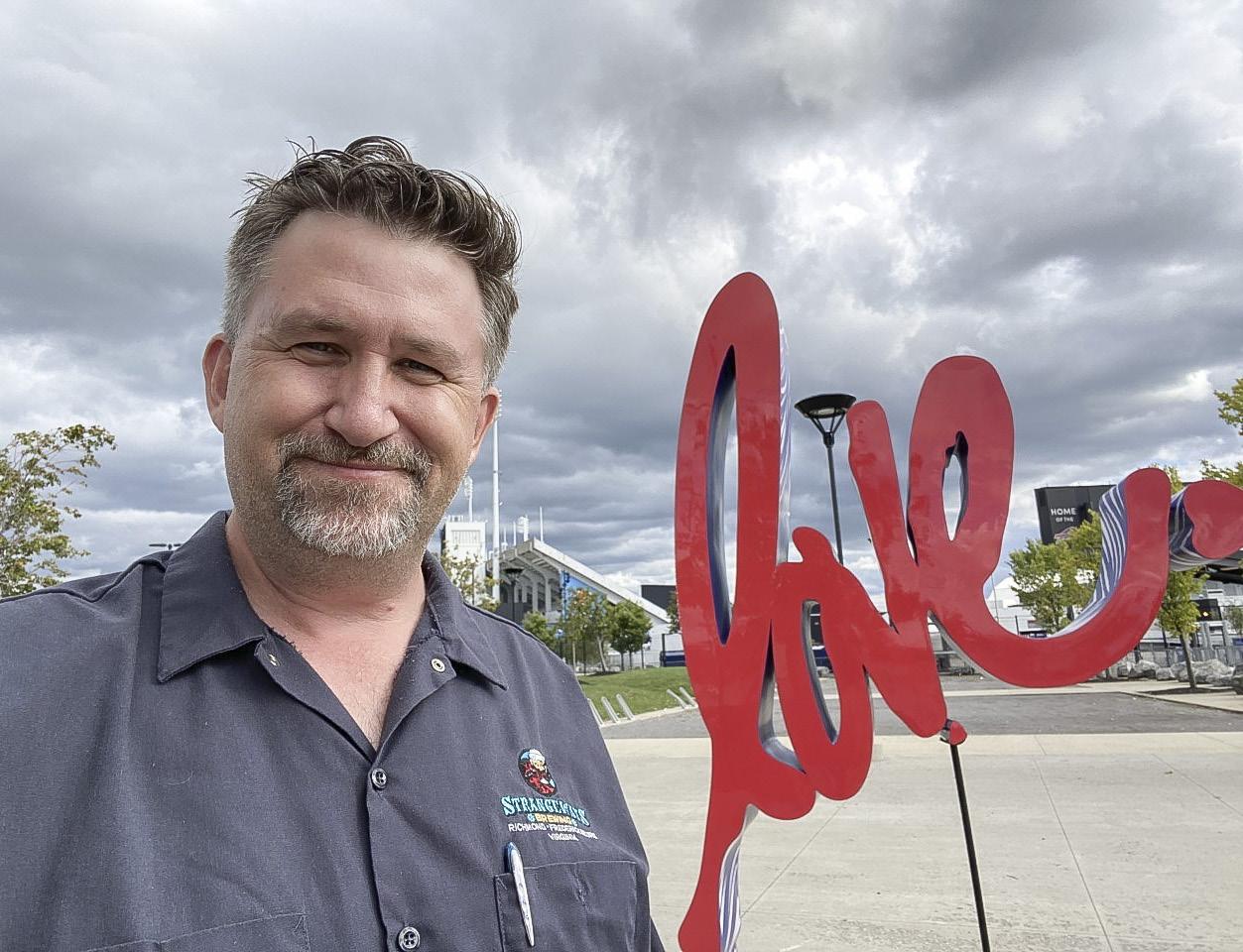
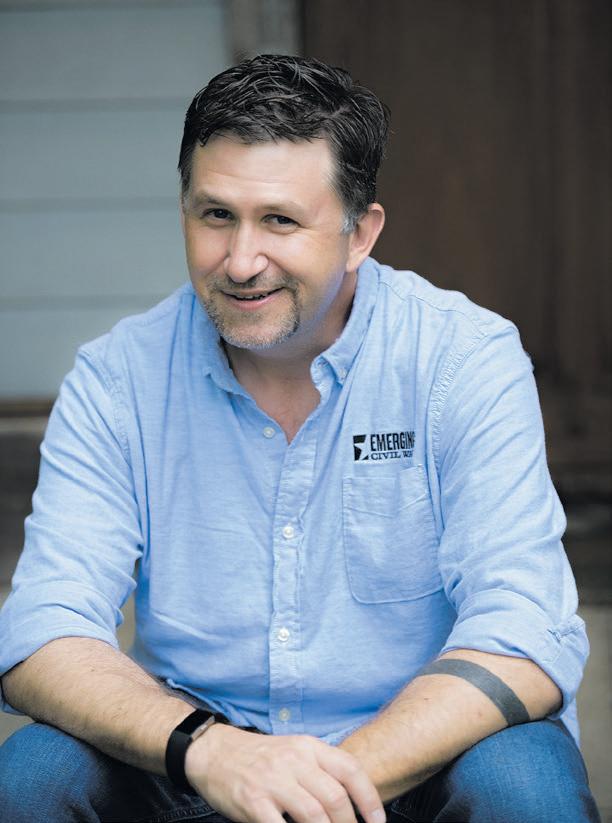
scenes by the Savas Beatie staff: Lisa, Angela, Veronica, Donna, and Sarah; for cooler weather (finally); and for the fact that the end of the Steelers’s miserable season is in sight.
Meg Groeling: I am thankful for the opportunities Emerging Civil War has offered me to write and actually have folks read my words. I am also thankful for all the younger female historians ECW has nurtured and encouraged; may there be many more!
Chris Heisey: Never does a day go by that I do not read something Civil War related. I am grateful to all the Blue and Gray who left behind delicious accounts about the horrors of war they experienced. To all the historians who write and feed today’s students with thoughtprovoking work and scholarly pursuits to help us all think, I express my sincere gratitude for that nourishing food for our brains. Also, I am thankful for being a part of Emerging Civil War in a small way and having the opportunity to contribute to various projects that reward me with getting to know those who produce great work. Finally, I appreciate being able to go to a battlefield anytime I choose, where something still abides. That so many dedicated preservationists helped conserve for posterity these sacred places where we freely can go and ponder, is a providential blessing to be forever cherished.
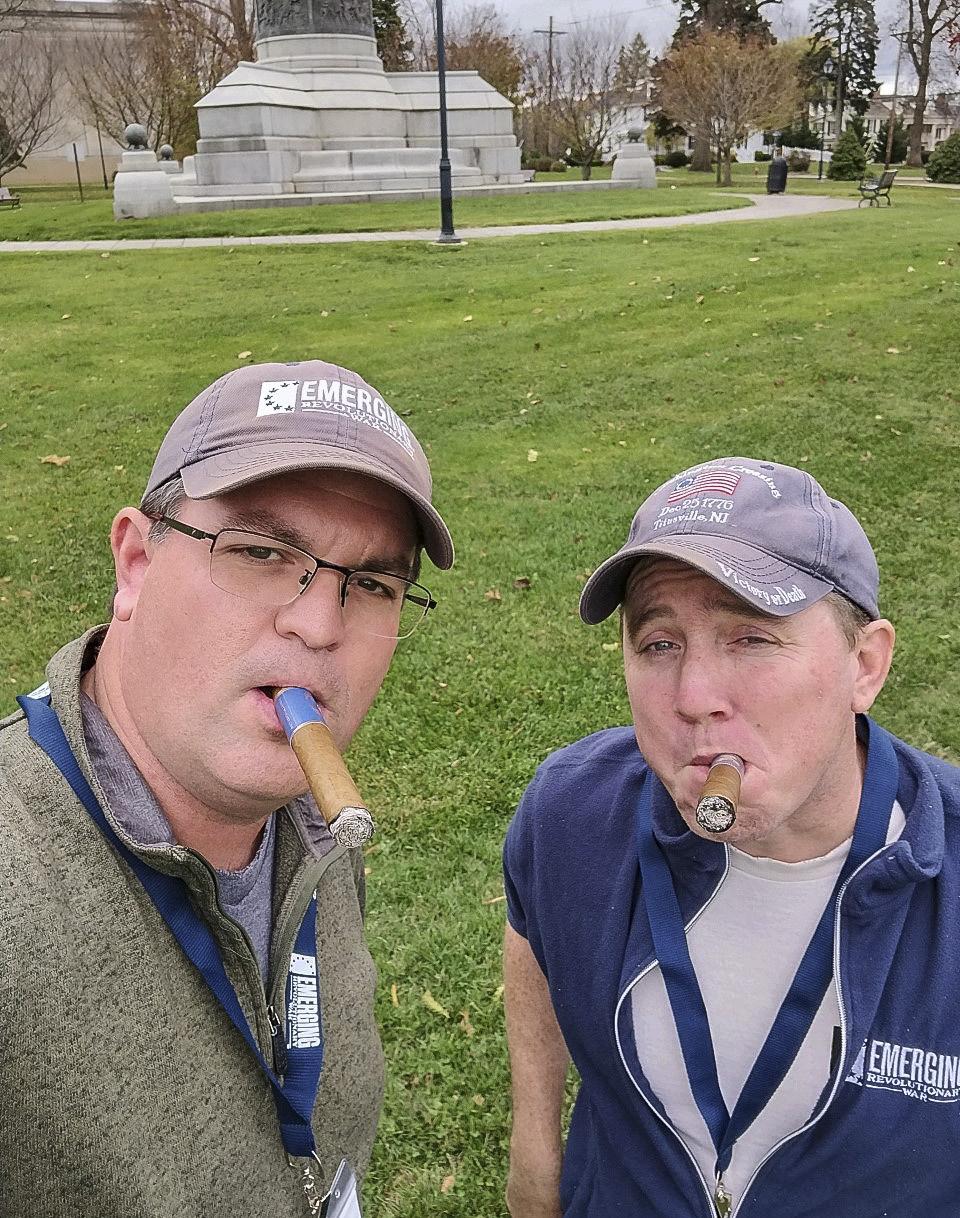
Dwight Hughes: This year, I am thankful for all our little furry and feathered friends and neighbors in the woods surrounding our home. We had a beautiful fall, and now leaves are off. Bluebirds flock to deck feeders outside my study window. Gray and white juncos (snowbirds) have arrived, announcing the beginning of winter and the holidays. Gray bushy tails are, as always, gamboling about in frantic selfimportance. Deer occasionally wander by at dawn or dusk with the sun low through the trees, as do fox, racoon, and possum. No more yard/garden chores for a few months. Stay in; stay warm. Maybe I can get some writing done.
Jon-Erik Gilot: I’m thankful for the community we’ve built at the Andrew Carnegie Free Library & Music Hall in Carnegie, Penn., and for everyone who comes out to support our 2nd Saturday Civil War Series and the Captain Thomas Espy Post. We’ve had over 1,000 visitors this year between the two! I’m also thankful for Sarah, Chris, and everyone who helps to keep the lights on at ECW so that the slackers like me can always find our way home.
Frank Jastrzembski: I’m thankful for the support that Shrouded Veterans has received and the opportunity to share my research on the ECW blog.
Brian Matthew Jordan: I’m thankful for Lorraine Caswell and Nancy Drugan, two truly
34 CivilWarNews.com January 2023 34 January 2023 CivilWarNews.com
Chris Mackowski
Rob Orrison and Mark Maloy enjoy a pair of victory cigars from Liberty Cigars during their Emerging Revolutionary War bus tour.
ECW Editor in Chief Chris Mackowski at Highmark Stadium in Orchard Park, N.Y., reminds us what a life of gratitude can bring us.
outstanding high school English teachers who taught me much about writing. Lorraine was a demanding teacher with her own litany of writerly conventions. She would not tolerate more than five conjunctions on a page; “lazy writers,” she insisted, relied on conjunctions. The word “very” headed a long list of “poor word choices.” Nancy was a sharp thinker who challenged students to find their style, hone their craft, and choose lively verbs. Without their time, care, and patience; without the essays they lovingly drowned in red ink, I may never have found my authorial voice.
Patrick Kelly-Fischer: I’m grateful to have joined ECW this year; it’s been a lot of fun getting to write here, and I’m looking forward to meeting some of y’all in person in 2023. I’m also grateful to live in such a beautiful place as Colorado. I’ve done more exploring lately, and even after eight years living here, I’m still amazed at how incredible the state is.
Chris Kolakowski: I’m thankful for all our readers and those who engage with our scholarship. It is great to see the reach of what we are doing.
Chris Mackowski: I realize it almost seems cliché to say “my health,” but that tops my list this year. I had what could’ve been a serious health scare earlier this year, and while I’m fortunate it turned out to be nothing, I had a few tense weeks of not-knowing. The youngest of my three wonderful children is five, and I want to be around a long time for him. It was scary to think I might not be. We only have today, and every day that comes after is a gift. Take care of yourselves to give yourselves as many extra days as you can get, and tell your kids and grandkids you love them.
Ryan Quint: I’m thankful for great friends who have helped me through a pretty tough year on the personal side of things. I’m also thankful for a great team at work who are never hesitant to question how we’ve done things and how we can do things differently.
Terry Rensel: I am thankful for the opportunities in my life that allowed me to live in, and see, great swaths of our country and to now be able to do history on a daily basis.

Brian Swartz: I am thankful for my sweet wife, Susan, who patiently accompanies me to so many battlefields, and for our son, Chris, who has tramped those battlefields with me.
and reflect. I am grateful for a community to bounce ideas off of, friends to rest with, and those who read our writings and help make the work worth it.

Cecily Zander: This year I am especially thankful for the Center for Presidential History at Southern Methodist University for giving me the time and space to work on my book; ECW’s readers for their engagement with our work and their passion for Civil War history, and (even though it’s not allowed) for my friends and family, including Moe the dog, who has made 2022 a much better year.
Phill Greenwalt, Billy Griffith, Rob Orrison, Mark Malloy, Kevin Pawlak, and Dan Welch are thankful for a successful Emerging Revolutionary War bus tour to Valley Forge and Monmouth in November!
The Ninth Annual Emerging Civil War Symposium at Stevenson Ridge

Emerging Civil War is pleased to announce Timothy B. Smith as the keynote speaker for our 2023 Symposium, August 4-6 in Spotsylvania, Va. Our theme this year is “1863: The Great Task Before Us,” and Tim will be presenting on “Grant’s Key Decisions in the Vicksburg Campaign.” Early


bird registration is only $200/ ticket through December 31. To order, or to get more information, visit our Symposium page: https://emergingcivilwar. com/2023-symposium.
ECW Multimedia






On the Emerging Civil War Podcast in November:
Historian Joe Ricci talked about the November 1864 “lost opportunity at Spring Hill, Tenn.,” one of the great “what-if” moments of the Civil War.
Greg Wade, president of the Franklin Civil War Roundtable talked about the November 1864 battle of Franklin, Tennessee.

The Emerging Civil War Podcast is available through Spotify, Apple Podcasts, and wherever fine podcasts are available. You can also subscribe to our podcast through Patreon (https://www.patreon.com/ emergingcivilwar), where we are now also offering exclusive bonus content for subscribers. That’s just $3.99/month, and proceeds go toward defraying the production costs of the podcast.
“The best little book on Barnard”
The American Civil War was the rst war in which both sides widely used entrenchments, repeating ri es, ironclad warships, and telegraphed communications. It was also the rst American War to be extensively photographed. Mathew Brady, Alexander Gardner and Timothy O’Sullivan are famous for having made iconic photographs in the Civil War’s eastern theater. George N. Barnard deserves to be ranked in this top tier for his photographic work in the war’s western theater. A civilian photographer hired by Gen. William T. Sherman’s chief engineer to take pictures of forti cations around Atlanta, Barnard took several hundred of them in and around the city in the fall of 1864. His most famous is the site of Union Maj. Gen. James B. McPherson’s death in the battle of Atlanta, July 22, 1864. Thus far, no comprehensive, de nitive listing has been made of the photographer’s work. For this book we have chosen a hundred images we deem “signi cant.”






128 page Paperb ac k: $19.95 (+$3.50


S & H)

Ordering info: $19.95 plus $3.50 s&h South Carolina residents add 9% sales tax Mail a check to: Historical Publications LLC 520 Folly Road, Suite 25 PMB 379 Charleston, SC 29412 or Order online at www.historicalpubs.com
Jon Tracey: As we wind down a fall that has been filled with challenges for me, I am thankful for the time set aside to pause Timothy B. Smith comes to the 2023 Emerging Civil War Symposium at Stevenson Ridge
35 January 2023 35 January 2023 CivilWarNews.com CivilWarNews.com
100 Signi cant Civil War Photographs: Charleston in the War features newly restored images of scenes in the famed city, taken 1860–1865. e cameramen include the better-known, such as George N. Barnard and George S. Cook, as well as some lesser-known ones: Samuel Cooley, Charles Quinby, the partners Haas & Peale, Osborn & Durbec. Text by Stephen Davis and Jack Melton accompanies each featured photograph, describing the pictured scenes and the history surrounding them. e selected images depict a variety of settings: that portion of Charleston known as e Battery, the “Burnt District” (the area of the city destroyed by the Great Fire of December 1861), the Charleston Arsenal, and the many churches that allow Charlestonians to call theirs “the Holy City.” Special sections of this book are devoted to the huge Blakely guns imported from England by the Confederates and close-ups of Barnard’s views. e history of Civil War Charleston goes back to e Defense of Charleston Harbor (1890) by John Johnson, Confederate major of engineers, and to Reminiscences of Forts Sumter and Moultrie in 1860-’61 (1876) by Capt. Abner Doubleday, Federal second-in-command. Since then Charlestonians have contributed to the history of their city, notably Robert N. Rosen and Richard W. Hatcher III. e historical text surrounding 100 Signi cant Photographs draws on these and other works. A unique feature is its reliance upon the writings of actual participants, such as Augustine T. Smythe (1842–1914) and Emma Edwards Holmes (1838–1910). As a contribution to this literature, 100 Signi cant Civil War Photographs: Charleston in the War o ers rewards for all readers, from the casual novice to the serious student. CHARLESTON
DAVIS & MELTON 100 SIGNIFICANT CIVIL WAR PHOTOGRAPHS CHARLESTON IN THE WAR 100 Signi cant Civil War Photographs: Charleston in the War features newly restored images of scenes in the famed city, taken 1860–1865. The cameramen include the better-known, such as George N. Barnard and George S. Cook, as well as some lesser-known ones: Samuel Cooley, Charles Quinby, the partners Haas & Peale, Osborn & Durbec. Text by Stephen Davis and Jack Melton accompanies each featured photograph, describing the pictured scenes and the history surrounding them. The selected images depict a variety of settings: that portion of Charleston known as The Battery, the “Burnt District” (the area of the city destroyed by the Great Fire of December 1861), the Charleston Arsenal, and the many churches that allow Charlestonians to call theirs “the Holy City.” Special sections of this book are devoted to the huge Blakely guns imported from England by the Confederates and close-ups of Barnard’s views. The history of Civil War Charleston goes back to The Defense of Charleston Harbor (1890) by John Johnson, Confederate major of engineers, and to Reminiscences of Forts Sumter and Moultrie in 1860-’61 (1876) by Capt. Abner Doubleday, Federal second-in-command. Since then Charlestonians have contributed to the history of their city, notably Robert N. Rosen and Richard W. Hatcher III. The historical text surrounding 100 Signi cant Photographs draws on these and other works. A unique feature is its reliance upon the writings of actual participants, such as Augustine T. Smythe (1842–1914) and Emma Edwards Holmes (1838–1910). As a contribution to this literature, 100 Signi cant Civil War Photographs: Charleston in the War o ers rewards for all readers, from the casual novice to the serious student. Stephen Davis JACK W. MELTON JR. CHARLESTON IN THE WAR 160 pages, Over 100 Photos, Maps, Index, Bibliography, Softcover. ISBN: 978-1-61850-167-7 $19.95 + 3.50 S&H Order online at www.HistoricalPubs.com or call 800-777-1862
IN THE WAR
Wrecking Atlanta Shadow dating the practice timing photograph studying shadows. series of the 1880s. When the men the 1st Missouri Engineers (oneofPoe’s thecaption,“theFirstMissouriEngineersdestroyingarailroadshowingtheuseofhooks for Monday, November Freedpeople on the Boxcars Peachtree Battery–Another View – MAKER –LEATHER WORKS (845) 339-4916 or email sales@dellsleatherworks.com WWW. DELLSLEATHERWORKS.COM Subscribe online at CivilWarNews.com
Cyrus McCormick and the Battle of Shiloh
The Graphic War highlights prints and printmakers from the Civil War discussing their meaning and the print maker or artist’s goals.
We have written before about the intersection of commerce and the horrors of war through the marketplace of lithographs. In this month’s column we feature the more egregious usage of commercial marketing of a product using one of the bloodiest battles of the Civil War. The Battle of Shiloh, April 6 and 7, 1862, was the most horrific combat to that
point. Nearly 25,000 combined casualties included 3,500 killed over the two-day period. More than 16,000 were wounded. The Confederates lost nearly 1,000 captured or missing, while Federal troops suffered close to 3,000 wounded or missing. The latter came when Union Brigadier General Benjamin Prentiss surrendered his
surrounded command at the Hornet’s Nest. According to most sources, Prentiss’ delaying action allowed Grant to establish a new line of defense closer to Pittsburg Landing. It may be that action depicted in the lithograph featured this month. Simply titled “Battle of Shiloh – April 6th, 1862,” it was the work of the Cosack & Company publishing firm of Buffalo and Chicago.

The Cosack firm, like many lithographic houses, morphed into several different iterations over the course of its long life from 1864 to well into the 20th century when it closed in 1920. Founded by immigrants Herman Cosack and Hugh Clay, it produced the usual items such as trade cards, plates for color books, broadsheets, and standalone lithographs. By 1885 when this print was published, “the firm had the largest press room in the United States at 70x200 feet with a ceiling 40 feet high… employing two hundred people.”1 The artist who executed the
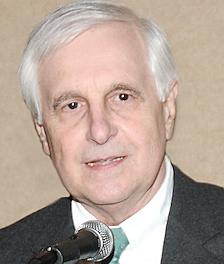
lithograph is unknown, but the original artist of the painting that was the source of the lithograph was French military painter Theophile Poilpot.
Poilpot spent his entire life and career (1848–1915) in Paris turning out academic art, particularly of military subjects. As his obituary revealed, Poilpot “did not confine himself to French subjects, and his paintings are located in a number of countries. Several of his best-known works are part of collections in the U.S., including ‘Bull Run,’ in Washington, D.C., and the ‘Merrimac and Monitor.’ Other major works by Poilpot include the ‘Battle of Jena,’ now in Paris, the ‘Crowning of Emperor Alexander III,’ in Moscow, the panorama of the ‘Battle of Balaklava,’ now in London, the ‘Transatlantic Panorama,’ which was shown at the Universal Exposition in 1889, the ‘Algerian Panorama,’ shown at the Paris Exposition of 1900, and the famous ‘Panorama of
36 CivilWarNews.com January 2023 36 January 2023 CivilWarNews.com
Battle of Shiloh – April 6th 1862 / Cosack & Co. Lith. Buffalo & Chicago. Print shows a roadway, possibly Corinth Road, separating the Union forces under the command of General U.S. Grant, on the right, and the Confederate forces on the left; in a shattered building, in the midst of the fighting, stands a “McCormick Harvester & Twine Binder,” untouched by the cannon and musket fire. This advertising print copies a portion of Théophile Poilpot’s painted panorama. (Library of Congress)
the Revolution and the Empire,’ now in Paris.”2 Poilpot made his reputation with cycloramas or as they were called in the 19th century, panoramas.
Chicago became the cyclorama center of America due to Chicagoans Howard Gross “who made ‘Battle of Gettysburg’ and ‘Jerusalem on the Day of the Crucifixion’” …and A. T. Andreas, publisher of the three volume ‘History of Chicago,’ who hired…Poilpot to produce ‘Battle of Shiloh’ for Chicago.”3
As historian Yoni Applebaum revealed, “Cycloramas of other Civil War battles followed in rapid succession, all of them depicting notable Union victories and intended primarily for Northern audiences. In August 1885, Chicago promoters hoping to reproduce the sensational success of the Gettysburg Cyclorama unveiled a new cyclorama of the Battle of Shiloh. It used the features of 2,000 actual participants in the battle, and when it opened just a week after the death of General Ulysses S. Grant, seemed poised for great success.”4
In order to provide the utmost accuracy in his 400 by 50-foot panorama of Shiloh, Poilpot “interviewed several survivors and represented more than 2,000 individual faces from their carte de visite photographs.” Unfortunately, only 30 “cyclorama” or “panorama” paintings exist in the world, the two most vivid in Atlanta and Gettysburg, depict those battles. Shiloh “was later exhibited in Washington, D.C., but is now considered lost.”5
What remains is the Cosack print. Although the print is labeled “Battle of Shiloh-April 6th 1862,” its immediate subject is debatable. According to the Library of Congress, the scene Cosack depicted is action of April 6 on the Corinth Road. According to another opinion, the fighting shown may represent Benjamin Prentiss’ stand along the Sunken Road that same day.6 Prentiss was surrounded and according to early reports, largely promoted by Prentiss after the war, the action saved the Union to fight another day. The print certainly appears to support the latter interpretation. Over to the right, (or North) in mid foreground is U. S. Grant and his staff; behind him in the background are the Union camps. Unidentified and almost hidden in the far left of the print (South) is a wounded Confederate officer on his horse. Could this be Albert Sidney Johnston just after he received his mortal wound? If so, it would certainly make sense that this is the action around the
sunken road, which was never sunken; the peach orchard, and Prentiss’ command.
Perhaps the most jarring aspect of Cosack’s interpretation of Poilpot’s work is the obscene introduction in a shattered building, in the midst of the fighting, of a “McCormick Harvester & Twine Binder,” untouched by cannon and musket fire. In fact, the title margin reads “Battle of Shiloh-April 6th 1862/ The ‘McCormick’ Machines come Victoriously out of every contest, and without a Scratch/ Presented with Compliments of McCormick Harvesting Machine Company.” The right title margin reads “Entered according to Act of Congress/in the Year 1885 by the/ McCormick Harvesting Machine Co./in the office of the/Librarian of Congress at Washington.”
The left margin reads: “Copied by Special Permission/from the/ Panorama Painting/on Exhibition in Chicago.” Above this legend is “General Grant and Staff.” The lithograph is nothing more than an advertisement for the McCormick Harvester Company which owned the land on which Poilpot’s original “panorama” of Shiloh appeared.
Chicago city leaders decided in the early 1880s that the city needed to remember the great fire of 1871 and show the world its remarkable resurgence. A cyclorama was the answer. The “Chicago Fire Cyclorama building between Madison and Monroe Streets on Michigan Avenue” was built “on land owned by the family of mechanical reaper magnate Cyrus McCormick.” According to historian Carl Smith, “it was erected in 1885 to host The Battle of Shiloh.”7
What was originally a horrific and tragic battle early in the Civil War was turned into a crass commercial advertisement for farm equipment. It would not be the first nor the last. In 1896, the Budweiser brewing company acquired Otto Becker’s depiction of Custer’s last stand and eventually produced more than a million prints advertising a combination of beer and military disaster. What could be more American?
Endnotes:
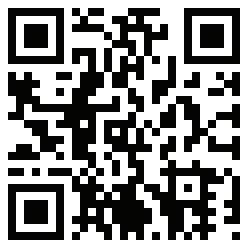
1. Jay Last, The Color Explosion: Nineteenth Century American Lithography, 58.
2. “Theophile Poilpot Dead/ Famous Military Painter Succumbs in Paris in His 67th Year.” New York Times, February 2, 1915.
3. Rick Kogan, “Long before movies and screens, Chicago went nuts for something called cycloramas.” Chicago Tribune, October 19, 1921. https://www.chicagotribune. com/entertainment/ct-ent-firecyclorama-kogan-1019-202110195fyzf55nave4vkoif6vnd5bjdy-story. html.
4. Yoni Appelbaum, “Cycloramas,” Essential Civil War Curriculum https://www. essentialcivilwarcurriculum.com/ cycloramas.html.
5. Picryl, https://picryl.com/ media/battle-of-shiloh-april-6th1862-cosack-and-co-lith-buffaloand-chicago.



6. Historynet, Battle of Shiloh Pictures https://www.historynet. com/battle-of-shiloh-pictures.
7. Carl Smith, Franklyn Bliss Snyder Professor of English and American Studies and Professor of History, Emeritus, at Northwestern University. https://www. chicagohistory.org/cyclorama.
After 43 years in the museum field, Cilella devotes his time collecting American prints and maps and writing. His most recent books are Upton’s Regulars: A History of the 121st New York Volunteers in the Civil War (U. Press Kansas, 2009). His two-volume Correspondence of Major General Emory Upton, (U. of Tennessee Press, 2017), received the 2017–2018 American Civil War Museum’s Founders Award for outstanding editing of primary source materials. Upton’s love letters to his wife 1868-70, (Till Death Do Us Part) was published in 2020 by the Oklahoma University Press. His current book, the memoirs of Private Dewitt Clinton Beckwith of Upton’s Regulars for McFarland Press will be released this Spring.
37 January 2023 37 January 2023 CivilWarNews.com CivilWarNews.com Publishers/Authors Send your book(s) for review to: Civil War News 520 Folly Road, Suite 25-379 Charleston, SC 29412 bookreviews@civilwarnews.com Publishers/Authors Send your book(s) for review to: Civil War News 520 Folly Road, Suite 25-379 Charleston, SC 29412 www.CollegeHillArsenal.com Tim Prince College Hill Arsenal PO Box 178204 Nashville, TN 37217 615-972-2418 www.CollegeHillArsenal.com Ulysses S. Grant Portrayed by E.C. Fields Jr., Ph.D. HQ: generalgrantbyhimself.com E-Telegraph: curtfields@ generalgrantbyhimself.com Signal Corps: (901) 496-6065 Facebook@ Curt Fields
Coquettish Confederate Spy Celebrated as the Siren of the Shenandoah Valley
by Bob Ruegsegger
Maria Isabella Boyd was born to a prosperous family with strong Southern ties in Martinsburg, Va., a part of the Old Dominion strategically situated at the northern entrance to the agriculturally vital Shenandoah Valley.
Although Belle Boyd’s countenance was not exactly angelic, she had other very appealing assets, a heavenly body and a flirtatious nature, that served her well during espionage efforts on behalf of the Confederacy throughout the Civil War.
The Belle Boyd House in Martinsburg, W.V., was built by Benjamin Reed Boyd, Belle’s father, and a local merchant. It stands at 126 East Race Street. The former Boyd residence and storehouse was purchased and restored by the Berkeley County Historical Society to establish a museum to house exhibits featuring local history.


“We are very popular to be honest with you. We’ve had almost 3,000 visitors to this house alone during this year,” said Susan Crowell, communications director for the MartinsburgBerkeley County Convention and Visitors Bureau. “People

come for different reasons. Some come here for Belle Boyd. Others come for the Berkeley County history, which includes the Civil War. Some want to learn more about Martinsburg in general,” said Crowell. “It’s a very popular spot.”
The Greek Revival style residence was built in 1853. The Boyds resided on the property until about 1858, but by the time the Civil War began, the Boyd’s were living on South Queen Street.
“We think Belle only lived here for about a year and a half. She was just a young girl. They sent her to Baltimore to a finishing school,” said Carol Appenzellar, curator/collections manager with the Berkeley County Historical Society. “When she came back after having her coming out party in Washington, the family had already moved to South Queen Street,” said Appenzellar. “That house no longer stands; that is the house where she supposedly shot and killed a Union soldier on July 4, 1861, when the Federals had taken Martinsburg.”
When the Civil War erupted, Martinsburg was in Virginia. Martinsburg became part of the newly formed state of West
Virginia in 1863. Martinsburg was critical to the Union’s war effort because the Baltimore and Ohio Railroad passing through the town provided the means to transport supply shipments and facilitate troop movements crucial to the defense of Washington.
“Belle’s career as a Rebel spy did not start at the house that’s standing now,” said Carol Appenzellar. “The South Queen Street house is not standing, so we interpret this slightly earlier family home.”
When Federal soldiers came into Martinsburg, 17-year-old Belle was arrested for shooting and killing a soldier who was forcing his way in to the Boyd residence to confiscate rumored Confederate flags. A particularly aggressive soldier was rough on Mary Boyd, Belle’s mother, so the young girl whipped out a concealed Colt 1849 Pocket Pistol

and shot him. Mortally wounded, Private Frederick Martin, 25, of Company K, 7th Pennsylvania Volunteers, later died.
Belle was exonerated for the
killing of Private Martin. Union authorities apparently considered it reasonable for a Southern girl to defend her mother.
Subsequently, General
At age 12, Belle rode her horse into the ballroom during a dinner party her parents were hosting. While the guests were amused, Belle’s parents viewed the stunt with extreme disfavor. All photos by Bob Ruegsegger.
38 CivilWarNews.com January 2023 38 January 2023 CivilWarNews.com
This five-room cottage, circa 1830’s, was moved to its present site in 1982. Items of special interest are displayed throughout the house for a self-guided tour.
Note the portrait of President Jefferson Davis in the upper left corner.
Belle Boyd left her Greek Revival home on Race Street to learn how to become a “proper young lady” at the Mount Washington Female College in Baltimore.
Patterson ordered Federal guards posted outside the Boyd’s Queen Street home to keep the family safe, avoid potential trouble that might be caused by Union troops, and to keep a watchful eye on young Belle.
Inspired perhaps by Federal indulgence, leniency, and outraged by the invasion of her Virginia home by Union troops, Belle Boyd, an ardent secessionist, decided to actively support the cause of Southern independence through espionage.

Belle Boyd was called the “Siren of the Shenandoah” among other colorful and disparaging sobriquets by both her admirers and detractors. Her admirers dubbed her La Belle Rebelle.
Most female spies of the War Between the States era fell into two extreme categories; the seductress who used her charms to manipulate men, and the impersonator who dressed as a male to intermingle unobtrusively.
Belle Boyd employed both in her role as a Confederate operator.

“She wasn’t a particularly beautiful woman, but she was charming and coquettish,” said Appenzellar. “She would get [military] information from the soldiers and pass it on to Confederate officers. She was mentioned several times by name in the Official Records of The War of Rebellion by the Union army,” Appenzellar noted. “One of the Union dispatches actually mentions trouble with people like Belle Boyd.”
Boyd’s spying became troublesome. She became a celebrated emissary with a widely-recognized reputation for her ability to cross Union and Confederate lines with relative impunity. Union authorities sought to keep her from behind Federal lines because her efforts at espionage, over time, proved to be particularly mettlesome.
When Belle’s aunt and uncle moved from Washington, D.C., to manage the Fishback Hotel in Front Royal, Va., Belle went to Front Royal to assist them, and do a little spying as well.
While Federal troops occupied Front Royal, the officers were billeted in the Fishback Hotel where Fanny Stewart, Belle’s aunt, was the innkeeper. A cottage in a tree-shaded courtyard behind the hotel was reserved for the

39 January 2023 39 January 2023 CivilWarNews.com CivilWarNews.com TOUR CULPEPER BATTLEFIELDS & HISTORIC SITES www.culpeperbattlefields.org Cedar Mountain Battlefield, Culpeper County, Va. BUDDY SECOR Visit preserved battlefields. Discover amazing stories. Engage with our past. JOIN A TOUR many options available
This plaque at 126 E. Race Street in Martinsburg, West Virginia, identifies the home of Belle Boyd. Toward the end of 1853, Benjamin Reed Boyd and his family moved into this Greek Revival residence.
Belle Boyd Portrait in the ballroom of her East Race Street home in Martinsburg.
proprietor’s family and exclusive guests.
When Federal officers were quartered in the hotel, the Stewart family moved into the cottage. Belle found the situation at the Fishback Hotel and the cottage outback highly conducive to her espionage aspirations.

From the cottage, Belle performed her best known service related to the May 23, 1862, Confederate victory at the
Battle of Front Royal. General Jackson’s forces advanced toward Front Royal but hesitated during the initial engagement with Union pickets.
When Belle heard the gunfire, she decided that General Jackson had to be advised that Federal soldiers were exiting the town and that if he reacted quickly he could seize the bridges over the Shenandoah River before the Yankees burned them in retreat.
As no man from town was heroic [fool] enough to run through the opposing skirmish lines to alert Jackson, Belle decided that she would assume the risk herself.
On foot, Belle Boyd ran down the street and across the open fields courageously exposing herself to Union gunfire.
“I did not stop to reflect. My heart, though beating fast, was not appalled,” wrote Belle in her memoirs, Belle Boyd, in Camp and Prison.
“I put on a white sun bonnet, and started at a run down the street, which was thronged with Federal officers and men,” wrote Boyd. “I soon cleared the town and gained the open fields, which I traversed with unbated speed, hoping to escape observation until such a time as I could make good my way to the Confederate line, which was still rapidly advancing.”
She wore a dark-blue dress with a fancy white apron affixed. The contrast in colors made her more conspicuous from a great distance than was comfortable. The skirmishing between the outposts was sharp. Miraculously she survived the dash through enemy lines unscathed. Her darkblue dress was later cut up into two shirts for wounded Rebel soldiers.
“The Battle of Front Royal was her big thing. Historians debate whether or not General Jackson already had the information. He probably did. He had his own scouts. She just confirmed it,” said Appenzellar. “She rode horses in the night and passed on critical information. She was an ardent Southerner and secessionist who had very passionate views. “
From her cell in the Old Capitol Prison in Washington, Belle Boyd vehemently, and unequivocally, expressed her political stance regarding her fidelity to the United States.
“Tell Mr. Stanton from me, I hope that when I commence the oath of allegiance to the United States Government, my tongue may cleave to the roof of my mouth; and that if I ever sign one line that will show to the world that I owe the United States Government the slightest allegiance, I hope my arm may fall paralyzed by my side.”
The Belle Boyd Cottage on Chester Street in Front Royal, Virginia, is operated by the Warren Heritage Society. The cottage is among the oldest buildings in town. In 1982, the old cottage was offered to the Warren Heritage Society and relocated to its present site.
“It was not her home. She was sent to live here with her aunt and uncle because she got in trouble.
Her parents couldn’t handle her,” said Melanie Gregory, manager with the Warren Heritage Society in Front Royal. “To avoid going to jail or legal trouble, her parents sent her to live with her aunt and uncle, the innkeepers at the Fishback Hotel.”

When Washington fell under martial law, Belle’s uncle, fearing his own arrest, vacated his home, abandoned his law practice, and fled with his family to Front Royal where Belle would visit her relatives for months at a time.
She rode into the camps and stayed for a week at a time gathering intelligence. She was frequently seen strolling down Main Street arm in arm with Federal officers.
Men young and old appeared to adore Belle. She was very good listener and an excellent flirt. Women generally didn’t particularly care for Belle.
The Belle Boyd Cottage has a central hall with a parlor and dining room downstairs. On the second floor there are two bedrooms. There was no kitchen; an outdoor kitchen served the hotel guests as well as the cottage residents.


“If you love the Civil War, you will love this house,” said
Gregory. “This cottage illustrates how a typical Civil War era house would have been set up: the dining room, parlor, and the bedrooms. It’s very interesting,” she observed. “If you want to learn anything about Belle Boyd during the Civil War, this is the place to come.”
An upstairs bedroom in the Bell Boyd Cottage depicts the room of A.W. Clarke, a correspondent for the New York Herald who was staying at the inn prior to the Battle of Front Royal.

Belle and the reporter both overheard Federal soldiers discussing battle plans. Clarke realized that Belle would attempt to convey their tactics for battle to the approaching Confederate forces. Before Clarke was able to advise Federal officers of Belle’s treacherous intentions, Belle locked him in his hotel room. With all the commotion downstairs, Clarke’s cries for help went unheard, and Belle personally carried the vital intelligence to Jackson’s command.
“When you go into the room where the reporter was sitting, you realize that she risked her own life to save Stonewall Jackson’s life,” said Melanie Gregory. “You can see the reporter’s hat, his
40 CivilWarNews.com January 2023 40 January 2023 CivilWarNews.com
Belle Boyd Cottage sign.
This upstairs bedroom in the cottage depicts A. W. Clarke’s room.
Dining Room Belle Boyd Cottage.
Carol Appenzellar serves as curator / collections manager with the Berkeley County Historical Society in Martinsburg.
Melanie Gregory is the manager of the Belle Boyd Cottage, operated by the Warren Heritage Society, the Front Royal organization that owns and operates the historical museums on Chester Street.
paper, his pen. He knew what she was going to do. She just shut the door and locked him in there,” she said. “That’s worth coming here for.”
After being imprisoned for spying on a number of occasions, Belle Boyd found herself in very hot water. She decided that it was in her best interest to flee America. In 1864, the Siren of the Shenandoah boarded the steamer Greyhound, a blockade runner, in Wilmington, North Carolina. Bound for England loaded with cotton bales, the Greyhound was intercepted by the Union blockade, seized, and sent to Boston to be sold as a prize. Belle Boyd was banished to Canada.
From Canada, Belle sailed to England where she wrote her memoirs, Belle Boyd, in Camp and Prison, to help support herself.

Following the Civil War, Belle returned to America where she exploited her notoriety during the war to earn a living as an actress, billing herself as Belle Boyd of Virginia. Occasionally, she rode onto the stage on horseback and frequently depicted dramatic scenes from her memoirs.
Perhaps, in a sense, the Siren of the Shenandoah, at the time a 20-year-old girl, may even have manipulated President Lincoln when, via letter from England,

she proposed suppressing the publication of her memoirs in exchange for the release of her husband Samuel Wylde Hardinge from imprisonment at Fort Delaware.
“If you will release my husband & set him free, so that he may join me here in England by the beginning of March, I pledge you my word that my book shall be suppressed,” wrote Belle Boyd Hardinge. “Should my husband not be with me by the 25th of March I shall at once place my Book in the hands of a publisher.”
On February 3rd, ten days following Belle’s demand and threat to expose “atrocious circumstances,” Samuel Hardinge was released from imprisonment. Lincoln may have admired Belle Boyd’s audacity in sending an ultimatum to the President of the United States. Samuel Hardinge’s only wrongdoing was that he was Belle Boyd’s husband. Perhaps, Lincoln, “with malice toward none and charity for all,” considered that.
Hardinge boarded the steamship Cuba, after a visit to his family home in Brooklyn, and joined his wife in England several weeks later.

The Siren of the Shenandoah died of a heart attack at Kilbourne City [now Wisconsin Dells] in
Southern Wisconsin, at age fiftysix. Four Union army veterans served as her pallbearers. An auxiliary of the Grand Army of the Republic contributed funds for her burial. The United Daughters of the Confederacy were asked to scatter the place of her interment with dirt from Virginia, so that Belle—La Belle Rebelle—could repose in eternal peace.

“I admire her for what she did. There are people from all over the United States, even people from outside the country, that love her and come here just to see the Belle Boyd Cottage,” noted Melanie Gregory. “Just to see her things. Just to see where she lived. Just to see her home where she lived for three months. They come to see that. They love her. They see her as a hero.”
Bob Ruegsegger assignments frequently take him to historic sites throughout Virginia, the Mid-Atlantic, and the Southeast. His favorite haunts include sites within Virginia’s Historic Triangle—Jamestown, Yorktown, and Williamsburg. Bob served briefly in the U.S. Navy. He is a retired educator and has been an active newspaper journalist for the last twenty years.

41 January 2023 41 January 2023 CivilWarNews.com CivilWarNews.com Deadlines for Advertising or Editorial Submissions is the 20th of each month. Email to ads@civilwarnews.com e Artilleryman is a quarterly magazine founded in 1979 for enthusiasts who collect and shoot cannons and mortars primarily from the Revolutionary War, Civil War to World War II. Now expanded and fully illustrated in rich color throughout the entire magazine. 520 Folly Road, Suite 25 PMB 379, Charleston, SC 29412 • 800-777-1862 • mail@artillerymanmagazine.com www.ArtillerymanMagazine.com The Artilleryman Magazine FOUR INCREDIBLE ISSUES A YEAR Ulysses S. Grant Portrayed by E.C. Fields Jr., Ph.D. HQ: generalgrantbyhimself.com E-Telegraph: curtfields@ generalgrantbyhimself.com Signal Corps: (901) 496-6065 Facebook@ Curt Fields
Civil War News book reviews provide our readers with timely analysis of the latest and most significant Civil War research and scholarship. Contact email: BookReviews@CivilWarNews.com.

Confederate “Tories”
True Blue: White Unionists in the Deep South during the Civil War and Reconstruction (Conflicting Worlds: New Dimensions of the American Civil War). By Clayton J. Butler. Bibliography, notes, index, photographs, map 248 pp., 2022. Louisiana State University Press, hardback, $45.
 Reviewed by Salvatore Cilella
Reviewed by Salvatore Cilella
against foreign born fighters but “neighbors.” Confederate General Samuel Ferguson attacked the regiment under Colonel George Spencer and later remarked how strange it was: “In the very center of the Confederacy” were “men wearing the enemy’s uniform, killed—as some were—within a half mile of their own houses.” (67).
a choice between freedmen and former rebels,” they “could either ally themselves to the revanchist regime, leave their homes, or resign themselves to silence and political impotence.” (129). Most capitulated to the reality on the ground.
It undoubtedly all started with Jubal Early and his founding of the “Lost Cause” myth, then was moved along seamlessly by the Daughters of the Confederacy, and probably culminated in the Civil War Centennial “Celebration”/ “Commemoration” in 1961–1965. I write of the notion of two, principled, monolithic armies, “Billy Yank” and “Johnny Reb” (ably aided by Bell Irvin Wiley) facing off against each other in solidarity as brothers in arms. The Centennial only fueled the monolithic myth.
Thankfully, recent Civil War scholarship has persuasively pushed back against the grain and offered solid and nuanced insights into the realities of the conflict, both north and south. In his new book, True Blue: White Unionists in the Deep South During the Civil War and Reconstruction,
Clayton J. Butler has admirably exposed the myth of Confederate solidarity. As the title indicates, Butler follows the Confederate Tories well into Reconstruction. The difference is that much more has been written about Unionism in the border states and the upper south. Butler takes on Unionism in the deep South. He devotes one chapter apiece to monitor the First Louisiana Cavalry, The First Alabama Cavalry, Bradford’s Battalion and the Massacre at Fort Pillow (1864), and one each to Presidential reconstruction during 1865-67 and Congressional Reconstruction from 1867–1877.
In a tightly constructed argument and narrative, Butler lays bare how members of each “Tory” regiment fared during the war and their fates after the war. Although Confederate Tories were a minority, the story of those in the deep South has never been told or appreciated as well.
The First Louisiana Cavalry was formed in 1861, primarily of foreign born or northern born New Orleans immigrants. They were rejected as traitors to the Confederate government primarily because of their non-American origins. Nearly 50% were foreign born, Cuba, Mexico, Spain, Portugal, Germany, France, and several other European countries were represented in the regiment. (p. 42). Until the arrival of Benjamin Butler’s command, the regiment was hunted by Confederates spurred on by the government’s conscription act of 1862. To the men of the 1st Louisiana, staying with the Union made more sense than the alternative. They viewed the new government as illegitimate and in conflict with the constitution and Union.
The 1st Alabama however, was made up of white, native-born Alabamians who formed the unit during late 1862. In this case Confederate forces no longer had the rationale they were fighting
Although they were roundly beaten, the First Alabama Cavalry suffered much less than Major William Bradford’s 13th Tennessee Cavalry or “Bradford’s Battalion” at Fort Pillow. Although the narrative of the Massacre at the fort has focused correctly on the slaughter of U.S. Colored Troops, 277 of the 585 white Unionists were killed and 202 taken prisoner. (104) As the author points out, it is not his intention to minimize the losses of the USCT, but to balance the historical record. He attributes Nathan Bedford Forrest’s vicious assault on both troops to “perceived race betrayal.” (105)
What’s most remarkable in Butler’s last two chapters is his documentation of the complete reversal of white Unionists during Presidential Reconstruction and its follow-on, Congressional Reconstruction. Always in the minority, the “tory” regiments reveled in the Union victory, but quickly succumbed to the “lost cause” onslaught, joining their defeated Confederate neighbors to win the peace for the South. From the start, white Unionists were first and foremost, for the Union, but racial animosity trumped loyalty as emancipation was not part of the original bargain. In the new president, Andrew Johnson, a white loyalist from Tennessee, they saw a chance to return to the old days, the status quo, antebellum; the feeling was mutual. The Lincoln administration, and later Johnson’s, viewed Southern Unionists as foundational to eventual reconciliation and reconstruction. It was not to be.
First Louisiana Cavalry founder James Madison Wells was a prime example of southern Unionism’s tortured history. Wells owned 95 slaves and saw secession as a slippery slope to emancipation. After the war, President Johnson installed him as Louisiana’s reconstruction governor. He survived 2 turbulent years until the Military Governor of the Gulf District, Philip Sheridan, removed him for incompetence in 1867. (141)
Locally, the social, economic, racial, and political realities pushed Unionists back into the “redemption” fold. As Butler so eloquently points out, “faced with
This powerful book is a much-needed balance to our understanding of the nuances and intricacies of both regions of the country between 1861 and 1877. Butler has combined meticulous research, clear expository writing, and authoritative documentation to present a lucid explanation of a period in American History that demands more understanding.
Salvatore Cilella is the retired CEO of the Atlanta History Center. He is the author of Upton’s Regulars, (Univ. of Kansas Press, 2009). He has edited The Selected Correspondence of General Emory Upton, 2 Volumes. (Univ. of Tennessee Press, 2017). A recipient of the 2019 Founder’s Award, American Civil War Museum. He has edited “Till Death do us Part,” the love letters of Emory and Emily Upton documenting their brief and tragic two-year marriage (University of Oklahoma Press, 2020) and the Memoirs of Dewitt Clinton Beckwith, of Upton’s Regulars, (McFarland Publications) due out Spring 2023.
A New Way to Access an Historical Site
Port Hudson The Most Significant Battlefield Photographs of the Civil War by Lawrence Lee Hewitt. Photos, figures, notes, index, bibliography, 180 pp. University of Tennessee Press, Knoxville, utpress.org, 2021. ISBN 978-16219-0483-0. Hardcover, $49.95.

Reviewed by Lawrence E. Babits
Hewitt began his research into both Port Hudson and the photographic record of a Civil War siege in 1978. His research was initially conducted in his role as Port Hudson State Historic Site’s manager and then it became his doctoral dissertation topic. The book took a long time because he was initially serving two masters, the state site and his dissertation. After finishing the academic work, he continued researching Port Hudson and, more importantly, began looking seriously at its photographic record. Although they were related, the job did not always coincide with the research; over thirty years meant that there was time for reflection and other images to surface, often in sizeable number from previously unknown collections.
The research effort can be seen in the bibliography ranging from regimental histories and
the Official Records, through national archives holdings of the Corps of Engineers, census data, and photographic history. “Photography theory” relates to how a photograph is evaluated. There are several aspects to this interpretive approach including how the photograph was physically produced and artist’s portrayal of the subject in terms of what he wanted to convey. Another aspect is the subject matter, time of photo, location, and direction of the camera view. Anyone familiar with Frassanito’s work has seen how well the approach can work. Hewitt provided an outstanding observation on using material culture, including photography, to help tell history what happened when he pointed out that “Photographs taken at the time and artifacts recovered from the battlefield proved more accurate sources about the struggle there than eyewitness accounts and walking the ground.” His research into camera angles, times (both calendrical and daily hours), and the landscape clarified a great deal about what happened at Port Hudson. This is especially important because post-siege alterations and changes wrought by the Mississippi River left a very different environment to the future.
The 173 photographs are presented in chronological according to work periods of the men who created this record of a Civil War siege longer than the one conducted at Vicksburg, just up the Mississippi River. Hewitt organized six chapters around the work of three teams, McPherson and Oliver (June 14-July 9,1863), McPherson and Chronicle
42 CivilWarNews.com January 2023 42 January 2023 CivilWarNews.com
(July 9-18, 1863), Brooks and Blauvelt (Jan.-April 1864; and three individuals, Smillie (18641865), Fossett (1864-1865), and Ward (circa 1900). Only McPherson and Oliver worked during the siege itself and the team is credited with taking the only photo of a Confederate surrender. The individual photos are explained, related to siege events, and to each other as part of a chapter’s discussion of its photographers.
The issue of who owns an image was also covered. Hewitt pointed out that several institutions hold photos of great importance to Port Hudson’s history. Some wanted to be paid for using images they own but the cost was too great to include them, especially when fine print seems to reveal compensation for each reproduction or reprinting in a text. While institutions may own the photograph, they most emphatically do not own the history it recorded. That belongs to the people, both past and present, and by denying its exploration, the institutions are showing something of an elitist view.
One distraction was noted. With all the cannon photographed, and potential information that might be derived from them, it was puzzling that Hewitt constantly referred to cannon by the term “pound.” He cannot have thought these massive metal objects weighed 12 or 32 pounds; the proper term is pounder. That said, the large number of artillery pieces shown in the photos allows additional research into individual guns as historical topics themselves. [see Artilleryman vol 42(2):48-60, (Spring 2022) and vol 41(4):417, (Fall 2020)]
This book might be seen by some old line historians as simply a coffee table book. Nothing could be farther from the truth. It is a serious historical study that sheds new light on the siege and provides a new starting point for looking at how the photographic record can be utilized for many disparate research projects. It can serve as a reference point for anyone studying the Mississippi River operations before, during, and after 1863. It serves as a western theater version of Frassanito’s groundbreaking Gettysburg study. This is recommended highly.
Larry Babits earned degrees at Maryland and Brown leading to a career teaching archaeology and military history at Washington and Lee, Armstrong State, and East Carolina.
Not Just Another Grumpy Old General
General Gordon Granger: The Savior of Chickamauga and the Man Behind “Juneteenth.”
 By Robert C. Conner, Casemate, www.casematepublishers.com, 264 pp.
By Robert C. Conner, Casemate, www.casematepublishers.com, 264 pp.
ISBN-978-1-63624-130-
 2, softcover, $24.95.
2, softcover, $24.95.
Reviewed by Meg Groeling
the C.S.A. Army of Tennessee was gaining control. Asked by Thomas if he could counterattack a Confederate force on the Union flank, Granger replied, “My men are fresh and they are just the fellows for that work. They are raw troops and don’t know any better than to charge up there.”
(98) Granger’s action brought fresh ammunition and ready fighters, throwing them into Longstreet’s troops. He kept the attack going until dark, allowing the exhausted Federals to retreat in good order.
Robert C. Conner, the author of General Gordon Granger: The Savior of Chickamauga and the Man Behind Juneteenth, is a former journalist, and it shows. His experience crafting pieces for the New York Associated Press gives him the expertise to offer readers the biography of a complicated man. General Gordon Granger is one of the “B List” Union generals who make the history of the Civil War such a compelling field of study. However, some, including Ulysses S. Grant, might have considered him “C List” at best. Granger had a difficult personality.
A West Point graduate and career army officer, his first experiences in combat came during the Mexican-American War. His regular rise through the ranks came despite his reputation as a rude, profane, and irritable officer. Granger’s fame, despite his issues, came at the Battle of Chickamauga. On September 30, 1863, his Reserve Corps saved the U.S. Army of the Cumberland from nearly certain destruction. Without orders, General Granger sent two brigades forward to help Major General George H. Thomas on Snodgrass Hill, where
As glorious as his military career had been to this point, his odd behavior and irascible, sometimes threatening temperament finally ended his promotions. Both Grant and Sherman had become annoyed with him early on for such “dereliction of duty” as finding a battery that looked as if it needed some help and staying there to site guns, etc. Granger’s decision to go to Thomas’s aid did not make up for the fact that he had defied orders. It had happened too often, and General Granger was sent to join Admiral Farragut. Granger led the XIII Corps’ land operations against the Confederate forts in Mobile, Alabama.
When the war ended, Granger was given command of the District of Texas. On June 19, 1865, in the city of Galveston, General Granger read his own General Order No. 3 to the people of Texas. He informed them that, in accordance with a Proclamation from the President of the United States, all slaves were free. This was news to Texas, and the now-free people held joyous demonstrations. These celebrations were the origin of Juneteenth, commemorating the abolition of slavery in the former Confederate state of Texas. The chapter “Juneteenth” (174-189) is one of the most compelling in the entire book. For anyone who is not clear on the concept of the holiday, Conner explains the circumstances surrounding the proclamation and the public reaction to it, both in Texas and the rest of the United States.
Author Robert C. Conner expertly weaves together

the various personality traits that made General Gordon Granger such a perplexing man. Sometimes he was a brilliant general, but sometimes he flew off the handle at minor infractions and threatened maximum punishments, rescinding them the following day. He was outspoken, blunt, and critical of the mistakes of others. It seems as if Granger had two sides to his personality. He courted Louise Garland, who later married James “Pete” Longstreet, and Ellen Marcy, who became the wife of George McClellan. It was a love match when he finally married Maria Letcher in 1869.
As Civil War history continues to evolve, fascinating books like General Gordon Granger: The Savior of Chickamauga and the Man Behind “Juneteenth” will help readers understand that all-important
“B-List” of commanders, soldiers, spies, politicians, and civilians who made the midnineteenth century so absorbing and so relevant today.
Meg Groeling received her master’s degree in military history, with a Civil War emphasis, in 2016, from American Public University. Savas Beatie published her first book, The Aftermath of Battle: The Burial of the Civil War Dead, in the fall of 2015, and she has written First Fallen: The Life of Colonel Elmer Ellsworth, which Savas Beatie will also publish In addition, she is a regular contributor to the blog Emerging Civil War. She and her husband live with three cats in a 1927 California bungalow covered with roses on the outside and books on the inside.
43 January 2023 43 January 2023 CivilWarNews.com CivilWarNews.com Publishers/Authors Send your book(s) for review to: Civil War News 520 Folly Road, Suite 25-379 Charleston, SC 29412








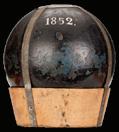











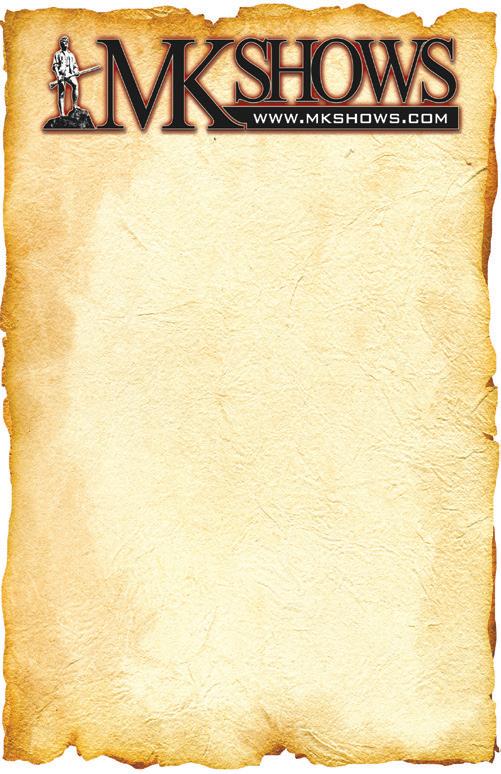





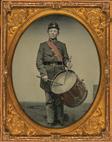
















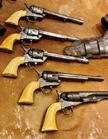


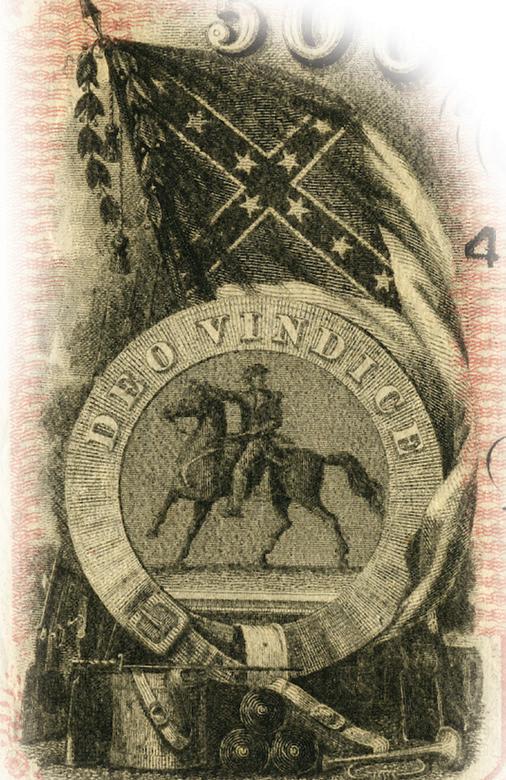
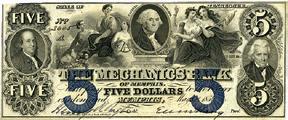
































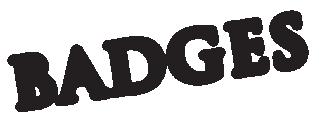




44 CivilWarNews.com January 2023 44 January 2023 CivilWarNews.com Museum Quality Civil War Union & Confederate Artifacts! WE HANDLE THE BEST Antique Bowie Knifes Civil War Swords Confederate D-guards Antique Firearms Dug Relics Buckles & Belts Identified Relics Letters & Documents Uniforms & Head Gear Images & Currency Flags ALLEN WANDLING 618-789-5751 • awandling1@gmail.com MidWestCivilWarRelics.com CONSIGNMENTS WELCOME Contact Glenn Dutton at: glennjdutton@aol.com or 770-351-7565 BUYING & SELLING Field & Heavy Artillery Cannon, Shells, Fuses & Etc. WE BUY ANTIQUE WEAPONS www.AndrewBottomley.com Mail Order Only • Worldwide Shipping Calling the UK from overseas: +44 1484 685 234 Calling our UK cellphone from outside the UK: +44 7770 398 270 email: sales@andrewbottomley.com The Coach House, Holmfirth, England HD9 3JJ Scottish Highlanders Flintlock Pistol £8,500 English Mortuary Basket Hilt £3,800 Spanish Miquelet Pistol £1,750 British Military Flintlock Blunderbuss Dated 1714 £9,500 Your trusted source... ...for BOOKS, year-round author talks & appearances and MORE! www.GettysburgMuseum.com 297 Steinwehr Avenue 717-334-6245 Operated by the nonprofit Gettysburg Nature Alliance Licensed Battlefield Guide tours available! 2023 Civil War Dealers Directory To view or download a free copy visit: civilwardealers.com/dealers.htm Promoters of Quality Shows for Shooters, Collectors, Civil War and Militaria Enthusiasts Military Collectible & Gun & Knife Shows Presents The Finest Mike Kent and Associates, LLC • PO Box 685 Monroe, GA 30655 (770) 630-7296 • Mike@MKShows.com • www.MKShows.com Northwest Georgia Trade Center 2211 Tony Ingle Parkway Dalton, GA 30720 February 4 & 5, 2023 Chickamauga (Dalton) Civil War Show Williamson County Ag Expo Park 4215 Long Lane Franklin, TN 37064 December 2 & 3, 2023 Middle TN (Franklin) Civil War Show l l Open your phone app and hover over the image to go directly to the website for current show schedule. WALLACE MARKERT csacquisitions@gmail.com 16905 Nash Road • Dewitt, Virginia 23840 804-536-6413 www.csacquisitions.com Shiloh 2405 Oak Grove Road Savannah, TN 38372 731-438-3541 ShilohRelics.com History@shilohrelics.com owner Rafael Eledge .com Dealing in the Finest Authentic Militaria Since 1995 with an Emphasis on the American Civil War Pistols, Muskets, Carbines, Rifles, Bayonets, Swords, Uniforms, Headgear, Belt Buckles, Cannon, Buttons, Bullets, Artillery Implements Etc. Are you… out you were stuck with a fake? Tired of continuously checking website and not finding anything new? Irritated when you can’t reach anyone on you get your item, you feel cheated? RebelRelics.com 615-772-7008 akinsarmory@gmail.com “You gonna check out my website or whistle Dixie?” Brian “Rebel” Akins Call the “Rebel,”and let me show you how we put an end to these issues, and many more! Greg Ton Buying the Finest in Confederate, Obsolete and Southern States Currency Greg Ton • P.O. Box 9 • Franklin, TN 37065 Phone: 901-487-5944 • Email: GTon1@aol.com Since 1978 GregTonCurrency.com We have been a family business since 1965, buying and selling fine antiques. Our collection of antiques ranges from Civil War military to antique military and toys. Our collection of Colt firearms and accessories, revolvers, pistols, carbines, accoutrements, photography, edged weapons and swords are of the highest quality. As taught by my father before me, we sell original quality items that are backed by our family guarantee. Vin Caponi Historic Antiques 516-593-3516 • 516-353-3250 (cell) rampantcolt@aol.com vincaponihistoricantiques.com 18 Broadway, Malverne, NY 11565 Contact Glenn Dutton at: glennjdutton@aol.com or 770-351-7565 BUYING & SELLING Field & Heavy Artillery Cannon, Shells, Fuses & Etc. 34 York St • Gettysburg, PA 17325 717-334-2350 • CIVILWAR@UNIONDB.com www. uniondb .com Buying and Selling original Civil War Confederate & Union Buttons, Belt Buckles, and Accoutrements. Allen Gaskins NC Relics www.CollegeHillArsenal.com Tim Prince College Hill Arsenal PO Box 178204 Nashville, TN 37217 615-972-2418 John Sexton ISA-CAPP 770-329-4984 CivilWarAppraiser@gmail.com Certified Member of: Appraisers Association of America Senior Accredited Appraiser (ASA) OVER 40 YEARS EXPERIENCE AUTHENTICATION SERVICES FOR COLLECTORS & MUSEUMS APPRAISALS FOR ANY INTENDED USE attend most major trade shows and auctions nationwide. Available as a Buyers Agent when purchasing rare & expensive items. Consultations as to best monetize valuable objects or collections in current markets. Is your collection appraised and inventoried for your heirs and family? CONFIDENTIAL APPRAISALS & AUTHENTICATIONS Schedule essential estate planning appraisal today for your valuable collection www.CivilWarBadges.com Everitt Bowles • p: 770.926.1132 • c: 678.480.1338 badges@bellsouth.net 1036 Washington Ave. Woodstock, Georgia 30188 The Largest Selection of GAR & UCV Hundreds of Memorabilia Items from Rev War through Vietnam Secure & Easy Guaranteed Authenticity of Every Item BUYING AND SELLING AUTHENTIC CIVIL WAR RELICS AND ARTIFACTS • INDIAN WAR SPANISH AMERICAN WAR • WORLD WARS AND II • VIETNAM WE HAVE BEEN IN BUSINESS SINCE 2000 AND GUARANTEE ALL ARTIFACTS TO BE 100% AUTHENTIC. Steve and Melody Strickland 770-633-5034 • info@dixierelicsonline.com HTTPS://DIXIERELICS.COM The Maryland Arms Collectors Assoc., Inc. presents The “Original Baltimore” Antique Arms Show Since 1955 Maryland State Fairgrounds Timonium, MD North of Baltimore, York Road, MD. - Rt. 45 1,000 8-Foot Tables March 18-19, 2023 Public Hours: Sat. 9 to 5, Sun. 9 to 3. Admission: $10.00 – Modern Handguns are Prohibited –Complete information on web site: www.baltimoreshow.com Or Call 443-497-9253 Known as the “CROWN JEWEL” of Collector’s Shows!
Jan. 4-11, Virginia. Online Seminar
Please join Prof. Jonathan A. Noyalas, director of Shenandoah University’s McCormick Civil War Institute, for a three-part online seminar via Zoom examining various aspects of the Civil War Era in the Shenandoah Valley.
January 4, “Kindred Will all be Divided”: The Eastern Panhandle on the Eve of Civil War; January 6, “An Expression of Helplessness”: Sigel, Hunter, and the Lower Valley’s Civilians in May 1864; and January 11, “That this War May Soon Come to an End”: Perspectives on the Meaning of Union Victory in the Shenandoah Valley, Autumn 1864.” All sessions begin at 7 p.m. EST. Although FREE (donations appreciated), registration is required. Email jnoyalas01@su.edu to register.
Jan. 7-8. South Carolina. Civil War Show
Low Country Civil War Show & Sale at Omar Shrine Temple, Mount Pleasant, Sat. 9-5, Sun. 9-3. Sponsored by American Digger Magazine. For information, 770-362-8671, 716-574-0465, americandiggerevents.com.
Jan. 20-21, Nevada. Antique Gun Show
Las Vegas Antique Arms Show at the Westgate Resort & Casino, Las Vegas, NV. Contact Cheryl Goyda at Morphy Auctions 877-968-8880 x755, cheryl. goyda@morphyauctions.com, visit www.antiquearmsshow.com for more information.
Jan. 28-29, Florida. Antique Gun Show
Florida Military Antique Collectors, Inc. at the Marian Hall, 5632 Sunrise Drive, Fort Myers, FL 33919. Contact Gary 847-863-3929. FMAC, Inc., PO Box 6518, Fort Myers Beach, FL 33932. Email: infofmac@yahoo.com, visit fmaac.tripod.com for additional information.
Feb. 4-5, Georgia. Civil War Show
MK Shows presents the Chickamauga (Dalton) Civil War Show at the Dalton Convention Center, in Ga., for collectors and history enthusiasts. Over 400 sale and display tables. Adults $10, Children under 12 are free. Open Sat. 9-5 and Sunday, 10-3. For info; www.MKShows.com, mike@mkshows.com.
Feb. 10, Pennsylvania. Lincoln Birthday Celebration
Sponsored by the Union League of Philadelphia. Civil War military units, civilians, and heritage groups are welcome and encouraged to march in the parade to honor President Lincoln on his birthday. Participants will gather at the Union League by 10 a.m. Complimentary parking at Laz Garage on the N.W. corner of 15th & Sansom St. Arrive between 9-10 a.m. and obtain a parking pass. Proceed garage at 114 S. 15th St. to park. Return to the Union League. For info; awaski01@gmail.com.
Feb. 11-12, Pennsylvania. Antique Gun Show
The Forks of the Delaware Historical Arms Society, Inc. presents the Antique & Modern Arms Show at the Agricultural Hall, Allentown, PA. Contact 610-438-9006. 1350 Uhler Rd, PMB 138, Easton, PA 18040-9006. Website: http://www.allentownshow.net.
Feb. 17-19, Florida. Reenactment
Olustee Battlefield Historic State Park will host the weekend long 46th Annual Reenactment commemorating the 159th anniversary of the Battle of Olustee. More than 1,500 living historians will give presentations of both civilian and military life during the Civil War. Events will include educational exhibits and speakers, battle reenactment, a skirmish, medical demonstrations, ladies’ tea, sutlers, artillery night firing, an old-fashioned barn dance! Spectators can visit authentic campsites, view artillery inspections, living history programs, listen to a period music and watch the battle reenactment. Festivities will end with the Battle of Olustee Ball at the Ball Tent. Period attire required. Ball is for participants only. For info; 877-635-3655; www.battleofolustee.org.
Feb. 24-26, South Carolina. 29th Festival of Living History
The 158th Anniversary of one of the last Confederate victories of the Civil War. Experience history coming alive during a weekend of battles,
demonstrations, tours, displays, music, crafts, food, and Saturday’s Blue Grey Ball! Tour the historic log cabin, schoolhouse, jail, mercantile building, and soldier’s camps. Eight food and drink vendors on site. Three scripted battles: two on Saturday and one on Sunday. Period church service held on Sunday. All units and individual reenactors (artillery, cavalry, infantry, medical, musical, & civilian) welcome. No fee if pre-registered by Jan. 31. Walk on fee is $10. $150 bounty for first 20 full-size artillery guns registered. All impressions needed for school day at 8 a.m. on Friday. American military impressions from all war periods (colonial through the Gulf Wars) are needed for our Military Timeline. Pioneer and Native Americans welcome. For information; www.battleofaiken.com or battleofaiken@aol.com.
March 3-4, Mississippi. Military History and Civil War Show
We are the oldest Military History and Civil War show in the Mid-South and we are growing! This year will be our 55th show. Located at the Landers Center in Southaven, MS. Friday, the show will open at 2 p.m. for our “First Lookers” and the general public and will close at 7 p.m. Saturday, show hours 9-5 p.m. Admission is $10 for adults and children under 12 are free. For more information please visit our Facebook page at midsouthmilitaryhistory or call Don at 901-832-4708.
March 18-19, Maryland. Antiques Arms Show and Sale
Sponsored by the Maryland Arms Collectors Association. With over 1,000 tables of the finest in collectable rifles, revolvers (pre-1898) and sporting shot guns, this show attracts thousands of serious collectors from across the globe. Open to the public on Sat. from 9-5, and Sun. from 9-3. Admission is $10. Located at the Maryland State Fairgrounds Cow Palace, 2200 York Road, Timonium, MD 21093. For information; www.baltimoreshow.com.
March 24-25. Mississippi. Militaria Show and Sale
Sponsored by Col. W. P. Rogers Camp SCV #321, The 14th Annual Corinth Militaria Show will be held at 2800 South Harper Rd. in Corinth. Vendors will have all kinds of military items including those from the Revolutionary War, Civil War, WWI and WWII. Show hours are 2-7 p.m. on Friday and 9 a.m. to 5 p.m. on Saturday. Admission is $5 and children under 12 are free. For information; Contact Buddy Ellis – 662-665-1419 – bellis1960@comcast.net or Dwight Johnson – 662-284-6125 – dgene@gmail.com.
March 30-April 2, Louisiana. Reenactment and Festival
Plan to attend the 159th Anniversary of the Battle of Pleasant Hill Reenactment and Festival located 3 miles north of Pleasant Hill at 23271 Hwy. 175 in Pelican. The original Battle was fought on Apr. 9, 1864, during the Red River campaign of the Civil War. Friday is school day from 9 a.m. to 1 p.m. On Sat. there will be a parade at 10 a.m. and a program at 11 a.m. at Mansfield State Historic Site. There will be guest speakers, opening ceremonies and then a battle reenactment at 2 p.m. The ball is at 7 p.m. (period dress suggested). 7 p.m. luminary memorial ceremony. Sunday begins with 10 a.m. church services followed by guest speaker. At 1 p.m. is the Crowning Ceremony of Miss Battle of Pleasant Hill followed by the opening ceremony and finally the 2 p.m. battle. For information; www. battleofpleasanthill.com.
April 2, Virginia. Seminar
Shenandoah University’s McCormick Civil War Institute’s annual spring conference on the campus of Shenandoah University, Winchester, Virginia, “Beyond the Mere Routine of Everyday Life”: Encounters & Experiences during the Civil War. Presentations with Jonathan A. Noyalas (Shenandoah University), Lauren K. Thompson (McKendree University), Kathryn J. Shively (Virginia Commonwealth University), and Jonathan W. White (Christopher Newport University). $30 registration fee covers all presentations and lunch at SU. Space is limited, visit www.su.edu/mcwi to register. For information; jnoyalas01@su.edu or phone 540-665-4501.
April 13-16, Georgia. The Georgia Battlefields Association Annual 2023 Tour
Thursday Morning Walking tour of Savannah’s Revolutionary War Sites. Thursday Afternoon-Walking Tour of Bonaventure Cemetery. Thursday evening reception with heavy hors d’oeuvres with a presentation by Dr. MaryElizabeth Ellard on Civil War Veterinary Practices.
Friday & Saturday–Tours of Fort Pulaski, Old Fort Jackson, Wormsloe State Historic Site, King’s Bridge, Fort McAllister, Ebenezer Creek, and remnants of the 1864 landward defenses.
Sunday Morning- Walking tour of The City of Savannah’s Squares.
Price: $580 per person which includes all tours (Thursday-Sunday morning), breakfast is included in the hotel price, Thursday night reception, three lunches, two dinners (Friday & Saturday) and bus rental.
$460 per person for Thursday night reception and tours & meals Friday to Sunday morning.
Host hotel: Hampton Inn & Suites-Historic District at 603 W. Oglethorpe Ave. Savannah, GA 31401 912-721-1600.
Ask for The GBA Rate of $179 per night for Wed. & Thur. nights & $259 per night for Fri. & Sat. nights. If you reserve all four nights, it’s $219 per night plus a 16% tax which adds $34.47 per night for a daily total of $253.47 per night. Breakfast is included in the hotel price. Hotel parking is $30 per night.
Our guide is Jim Ogden, Chickamauga & Chattanooga National Military Park Historian.
We welcome Non-GBA Members to join us on our Tour however you can join GBA for just $25. Registration: Mail a check payable to Georgia Battlefields Assn. (GBA) to PO Box 669953, Marietta, GA 30066. You can also use Paypal or Credit Card to register online at our GBA Website Tours Page http:/georgiabattlefields.org/tours.aspx. If you have trouble registering, please contact our Treasurer: William W. Gurry at email:billgurry@bellsouth.net.
April 23, Illinois. Civil War & Military Extravaganza
Zurko Promotions presents The National Civil War Collectors Fall Show and Sale which will be held at the DuPage County Fairgrounds, 2015 W. Manchester, Wheaton, Ill. Hours: 9 a.m. to 4 p.m. Admission is $10, Early Admission $25. Free parking. For more information visit www.chicagocivilwarshow.com or call Zurko Promotions at 715-5269769.
May 6-7,
Ohio Civil War /WWI & II Show Historical Event
The Ohio Civil War & WWI/II Show will be held in Mansfield, OH, May 6th – 7th at the Richland County Fairgrounds. All federal, state, and local firearm ordinances and laws must be obeyed. Civil War and WWI & II Memorabilia from 1775 through 1945 for buy, sell, and trade. Featuring a unique artillery show with full scale cannons on display and daily cannon firing demonstrations. Added Special Features: Civil War & WWII Encampments, Sutlers Row, Civil
45 January 2023 45 January 2023 CivilWarNews.com CivilWarNews.com
Before making plans to attend any event contact the event host.
War Period Music, Gettysburg Address by President Lincoln, WWII US 801st Med Air Evac Educational Presentation, Marlboro Volunteers Traveling Museum and WWII Military Vehicles. Hours are Saturday 9 a.m. - 5 p.m. and Sunday 9 a.m. - 3 p.m. Admission $7. Children under 12 Free. Parking is free. Camping on grounds is available - $35.00. For more Information; contact: 419-884-2194 or info@ohiocivilwarshow.com and visit our website: www.ohiocivilwarshow. com. Follow us on Facebook: Ohio Civil War Show.
May 18-21, Tennessee. American Battlefield Trust Annual 2023 Conference
The 2023 Annual Conference will be hosted at the Cool Springs Franklin Marriott located at 700 Cool Springs Blvd. Group rate is $169+/night. Call 800-228-9290 and ask for the ABT group rate. Conference begins with registration and exhibitor tables open on Thursday at 11 a.m. The day will be filled with tours for Color Bearers, history talks, a welcome reception from 6:30 – 8:15 p.m. and a photo extravaganza with Garry Adelman. Friday begins at 6:30 a.m. with a breakfast buffet, 8 a.m. tours depart, 6:45 p.m. cocktail reception for Color Bearers and a Color Bearer Author Dinner at 7:30 p.m. Saturday begins with a breakfast buffet at 6:30 a.m. and tours departing at 8 a.m. There will be a cocktail reception at 6:30 p.m. and the Banquet and Awards Ceremony with be held at 7:30 p.m. The Conference will conclude on Sunday morning with a closing breakfast with Q&A with President David Duncan between 8 and 9 a.m. For more information; events@battlefields.org or 800-298-7878 x7229.
May 19-21, Virginia. Period Firearms Competition
The North-South Skirmish Association 147th National Competition near Winchester. Over 3,000 uniformed competitors in 200 member units compete in live-fire matches with muskets, carbines, revolvers, mortars and cannon plus costume competitions and historical lectures. The largest Civil War live-fire event in the country. Free admission, large sutler area, and food service. For more information visit the N-SSA web site: www.n-ssa.org.
May 28, Pennsylvania. Original G.A.R. Decoration Day of Service
Memorial Day Observed at Laurel Hill Cemetery located at 1868 3822 Ridge Ave., Philadelphia at 12 p.m. All are welcome. Laurel Hill is the site of the first Memorial Day in Philadelphia in 1868. Special veterans’ markers will be dedicated at the graves of previously unmarked veterans. Speakers, ceremonies, and pageant will highlight the ceremony. Wreath-laying, speeches, music, and honor guards. Historical groups, veterans, and citizens are urged to participate. Wreaths, military contingents, color guards, music and period civilians are encouraged to participate. Refreshments served after the ceremony. For information; 215-228-8200.
May 19-21, Georgia. Reenactment and Living History
The Battle of Resaca Reenactment will be held on over 600 acres of the original battlefield in Resaca, Georgia. This reenactor-friendly event will have main camps located near the original US and CS lines. Campaigners are welcome to camp in or near the breastworks. Amenities include straw, hay, and firewood. Modern food and ice vendors on site. Weekend activities will include battles both days at 2 p.m. – rain or shine, combined US & CS morning colors, period demonstrations, cavalry competition, a civilian refugee camp, reenactor yard sale, sutlers, period music and dance, period church services, and a memorial service at the Confederate Cemetery. Many Civil War historical sites are located on the reenactment site and two major Civil War parks are within minutes of the site. Handicapped parking available with free transport from parking areas to battlefield, vendor and sutler areas. Reenactor pre-registration is $10 if received by April 15th. Artillery bounties of $150 for the first 18 cannons with crew pre-registered by April 15. A portion of the proceeds to be donated to preservation efforts of the Friends of Resaca Battlefield. For more information; www.georgiadivision.org.
May
19-21, Missouri. Reenactment
The Battle of Carthage was the first full scale battle of the Civil War. The 161st Anniversary Reenactment will be held at Civil War Ranch. Experience the battle that both sides claim to have won. Begin Saturday with the Opening Ceremony at 9 a.m. Continue the day with camp life, drills & demonstrations, Ladies Tea at 10:30 a.m., Arms Inspection at 12:30 p.m., Reenactment at 1 p.m., Cake Walk at 3 p.m. and Civil War ball at 7 p.m. Sunday’s activities include drills & demonstrations 9 a.m. – 3 p.m., Church service at 10 a.m., Arms Inspection at 12:30 p.m. Reenactment at 1 p.m. For more information, www.battleofcarthage.com.
June 3-4, Virginia. Reenactment: The Action at Wilson’s Wharf
Located between Richmond and Williamsburg on the James River, scenic Fort Pocahontas is the site of the May 24, 1864 action in which United States Colored Troops defended the fort they built against an assault by Fitzhugh Lee’s Confederate Cavalry. Open to the public 10-4 Sat. and 10-3 Sunday: $10/adults, $8/students; battle reenactments both days. See Civil War camps and enjoy history brought to life through family-friendly activities. Food vendors on site. For reenactors: pre-registration required starting Jan. 10 at www.fortpocahontas.org; shaded campsites.
June 10-11, Mississippi. Civil War Show
Civil War Relic Show will be held at Brandon City Hall, located at 1000 Municipal Drive, Brandon, Mississippi. 300 tables of relics, weapons, prints, documents, artillery, WWI & WWII, bottles, books, currency, living history displays, and more. Admission $8, 12 and under are free. Saturday, 9 a.m. to 5 p.m., Sunday, 9 a.m. to 3 p.m. Contact Tim Cupit at TimCupit@comcast. net or call 769-234-2966, or visit www.scv265.com.
June 23-25, Pennsylvania. Annual Gettysburg Civil War Artifact Show
The nation’s premier Civil War relic and collectors show at the Eisenhower All Star Complex at
2634 Emmitsburg Rd., Gettysburg. Our 300+ tables are a great way to view and even purchase authentic Civil War artifacts. Browse the tables and speak with the vendors who are all well versed in history and artifact identification. Better than a museum! Every item has someone willing to give you its history lesson and answer all your questions. $100 VIP Charitable donation includes Friday and early admission for the serious collector. Hours: Sat. 10-5, Sun. 9-2. Admission $10, children under 12 free. For more information visit https://www.gbpa.org/ event/annual-civil-war-relic-show.
Aug. 12-13, Georgia. Civil War Show and Sale
45th Annual Southeastern Civil War & Antique Gun Show in Marietta at the Cobb County Civic Center hosted by the North Georgia Relic Hunters Association. Cobb County Civic Center, 548 South Marietta Pkwy SE, Marietta, GA 30060. Hours Sat. 9 a.m. to 5 p.m., Sun. 9 a.m. to 3 p.m. Admission $8, veterans and children under 10 are free. Show chairman: Ray McMahan at terryraymac@hotmail.com. For more info visit www.ngrha.com.
Sept. 23, Illinois. Civil War & Military Extravaganza
Zurko Promotions presents The National Civil War Collectors Fall Show and Sale which will be held at the DuPage County Fairgrounds, 2015 W. Manchester, Wheaton, Ill. Hours: 9 a.m. to 4 p.m. Admission is $10, Early Admission $25. Free parking. For more information visit www. chicagocivilwarshow.com or call Zurko Promotions at 715-526-9769.
Oct. 6-8, Virginia. Period Firearms Competition
The North-South Skirmish Association 148th National Competition near Winchester. Over 3,000 uniformed competitors in 200 member units compete in live-fire matches with muskets, carbines, revolvers, mortars and cannon plus costume competitions and historical lectures. The largest Civil War live-fire event in the country. Free admission, large sutler area, and food service. For more information visit the N-SSA web site: www.n-ssa.org.
Oct. 21-22, Virginia. Reenactment
The 159th Anniversary Reenactment of the Battle of Cedar Creek recreating the last major battle in the Shenandoah Valley will be held the weekend of Oct. 21-22 at 8437 Valley Pike in Middletown, Va. See cavalry, artillery, and infantry soldiers in action and in camp. Battle scenarios, music, symposia, and medical, military, and civilian demonstrations are scheduled each day. Fundraising raffles, period merchants, and food vendors onsite. Don’t miss the Evening Candlelight Tour Program. 1-day, 2-day, and discount options available! Children 6 & under are free! For more information; 540-869-2064, Info@ccbf.us or www.ccbf.us.
Nov. 10, Pennsylvania. US Marine Corps Birthday Observance
Join us at the Laurel Hill Cemetery, 3822 Ridge Ave, in Philadelphia at 11 a.m. at the grave of General Jacob Zeilin, 7th Commandant of the Marine Corps during the Civil War. A special ‘Veterans’ Day tour of heroes ‘killed in action’ and buried at Laurel Hill Cemetery will follow. sponsored by: The Legion Post 405; MOLLUS; General Meade Society. For information; 215228-8200, awaski01@gmail.com, 215-423-3930 or www.thelaurelhillcemetery.org.
Nov. 18, Pennsylvania. Remembrance Day in Gettysburg
General Meade & his Generals and the veterans of the Battle of Gettysburg Honor/Dedication Ceremonies during the Remembrance Day Observance. Honoring all commanders and veterans of the Battle. Meet at the General Meade Equestrian Monument at 10 a.m. For information; Jerry McCormick at 215-848-7753 or gedwinmc@msn.com.
Nov. 18, Virginia. Civil War Show
In conjunction with the Central Virginia Civil War Collectors Association, Bullet and Shell is proud to present the 42nd Annual Central Virginia Military Antique Show (formally Mike Kent’s Capital of the Confederacy Civil War Show). This year, the show is moving to a new location at Meadow Event Park, 13191 Dawn Blvd, in Doswell, Va. The show will host vendors and displays of American military history from the Revolutionary War through WWII. Bring your relics for appraisal or to sell. Over 300 tables! There will be many historical items to add to your collection. Show hours are 9-5 on Saturday, vendor setup on Friday. Parking is free and admission is only $10/adults with children under 12 free. For more information; www. MilitaryAntiqueShow.com.
Dec. 3-4, Tennessee. Civil War Show and Sale
MK Shows presents the 36th annual Middle Tennessee Civil War Show and Sale at the Williamson County Ag Expo Park, 4215 Long Lane in Franklin. The nation’s largest Civil War show, featuring 750 tables of antique weapons, artifacts and memorabilia from top dealers and collectors around the country and encompassing all eras of military history from the Revolutionary War through World War II. Appraisers are always on hand to help you identify and value your military collectibles at no cost. Hours are 9-5 on Sat., 9-3 on Sun. Free Parking. Admission is only $10/adults and children under 12 are free. For information; www.MKShows. com or Mike@MKShows.com.
Dec. 31, Pennsylvania. Annual General Meade Birthday Celebration
This year will mark the 208th annual anniversary of the birth of General George G. Meade, heroic commander of the victorious Union army at the Battle of Gettysburg. The General Meade Society of Philadelphia will celebrate his birthday at Historic Laurel Hill Cemetery, 3822 Ridge Ave. at noon. A champagne toast and reception will follow the program. For information; 215-228-8200 Laurel Hill Cemetery.
Charge my:
Terms and Conditions
The following terms and conditions shall be incorporated by reference into all placement and order for placement of any advertisements in Civil War News by Advertiser and any Agency acting on Advertiser’s behalf. By submitting an order for placement of an advertisement and/or by placing an advertisement, Advertiser and Agency, and each of them, agree to be bound by all of the following terms and conditions:
1. All advertisements and articles are subject to acceptance by Publisher who has the right to refuse any ad submitted for any reason. Mailed articles and photos will not be returned.
2. The advertiser and/or their agency warrant that they have permission and rights to anything contained within the advertisement as to copyrights, trademarks or registrations. Any infringement will be the responsibility of the advertiser or their agency and the advertiser will hold harmless the Publisher for any claims or damages from publishing their advertisement. This includes all attorney fees and judgments.
3. The Publisher will not be held responsible for incorrect placement of the advertisement and will not be responsible for any loss of income or potential profit lost.
4. All orders to place advertisements in the publication are subject to the rate card charges, space units and specifications then in effect, all of which are subject to change and shall be made a part of these terms and conditions.
5. Photographs or images sent for publication must be high resolution, unedited and full size. Phone photographs are discouraged. Do not send paper print photos for articles.
6. At the discretion of Civil War News any and all articles will be edited for accuracy, clarity, grammar and punctuation per our style guide.
7. Articles can be emailed as a Word Doc attachment or emailed in the body of the message. Microsoft Word format is preferred. Email articles and photographs: mail@civilwarnews.com
8. Please Note: Articles and photographs mailed to Civil War News will not be returned unless a return envelope with postage is included.

47 January 2023 47 January 2023 CivilWarNews.com CivilWarNews.com Advertisers In This Issue: 100 Significant Civil War Photographs: Atlanta 35 100 Significant Civil War Photographs: Charleston 35 Ace Pyro LLC 14 American Battlefield Trust 39 Artilleryman Magazine 41 C.S. Acquisitions – Wallace Markert 29 CWMedals.com, Civil War Recreations 41 Civil War Navy Magazine 31 College Hill Arsenal – Tim Prince 37 Day by Day through the Civil War in Georgia - Book 31 Dell’s Leather Works 27 Dixie Gun Works Inc. 23 Georgia’s Confederate Monuments – Book 26 Gettysburg Foundation 17 Gunsight Antiques 8 Harpers Ferry Civil War Guns 28 The Horse Soldier 28 James Country Mercantile 10 Jeweler’s Daughter 23 Le Juneau Gallery 5 Mercer University Press 33 Mike McCarley – Wanted Fort Fisher Artifacts 27 Military Antique Collector Magazine 11 National Museum of Civil War Medicine 27 N-SSA 5 The Regimental Quartermaster 41 Richard LaPosta Civil War Books 43 Shiloh Chennault Bed and Breakfast 18 Suppliers to the Confederacy – Book 43 Ulysses S. Grant impersonator – Curt Fields 41 Events: American Digger Events 2 Baltimore Antique Arms Show 15 McCormick Civil War Institute Conference 10 Mid-South Military History & Civil War Show 31 MKShows, Mike Kent 3, 29 Ohio Civil War Show 2 Poulin’s Auctions 48
c c c c
Discover MasterCard Visa NAME ADDRESS ADDRESS CITY STATE ZIP CODE EMAIL $41 - 1 year USA Print $51 -
year
Print &
$29.95
year Digital
Payment Enclosed Check # Card # Exp. Date Security Code Name on Card New Renewal c Make checks payable to Historical Publications LLC. c c c c Civil War News – 12 Issues Per Year Subscription/Renewal Form (required for digital subscription) USA Subscriptions Only No Canada or International Mail to: Historical Publications LLC 520 Folly Road, Suite 25-379, Charleston, SC 29412 Civil War News is now in a secure polybag with plain cover sheet for privacy. Subscribe online CivilWarNews.com PHONE Required 800-777-1862 Mike@MKShows.com • www.MKShows.com Admission Coupon To Any MKShows Event $1 Off 770-630-7296 Publishers/Authors Send your book(s) for review to: Civil War News 520 Folly Road, Suite 25 PMB 379 Charleston, SC 29412
1
USA
Digital
- 1
only


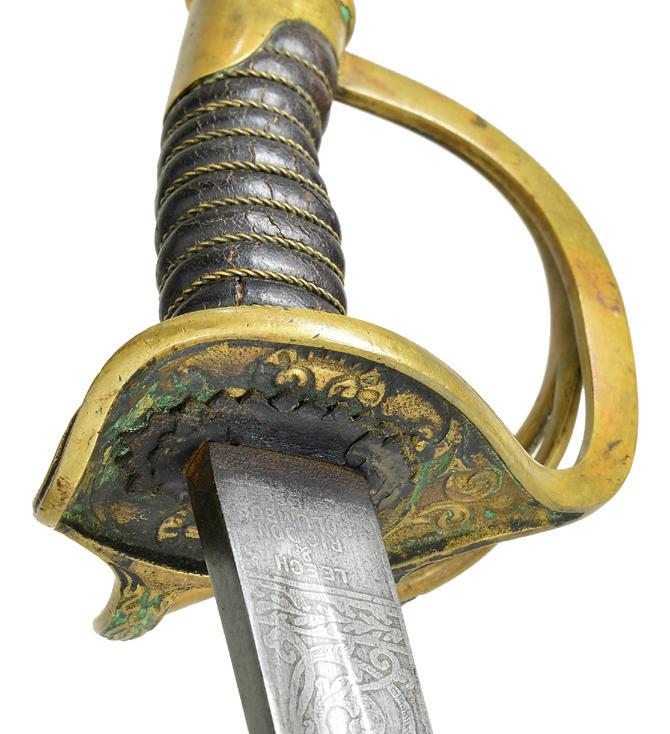




Firearms & Militaria Auctioneers Accepting Consignments For Our Upcoming Premier Firearms & Militaria Auction To view the full Prices Realized from our Fall 2022 Premier Auction, please visit: www.poulinauctions.com poulinauctions.com | 199 Skowhegan Rd, Fairfield, ME 04937 | Stephen Poulin, ME Lic # 1115 • Reputation - Sterling reputation for honest, straight forward business relationship with both buyers and sellers alike. • The Best Rates In The Industry - The Poulin & Julia family provides the most competitive commission rates in the industry. Including 0% or better seller’s commission on expensive items and valuable collections. • Finest Expertise - We utilize over 250 years of combined professional consultant experience and an additional three-generations of marketing expertise of nearly $1 BILLION in combined total sales by the Poulin & Julia Family. • Unique Auction Description Guarantee - We utilize honest, knowledgeable and detailed descriptions with the most comprehensive guarantee, building the highest level of confidence from bidders and generating the greatest return for consignors. • Presentation - Building interest and enthusiasm from potential bidders is crucial for achieving the maximum value for our consignors. Utilizing the finest detailed photography, catalog design and state of the art auction facility generates the highest level of excitement from potential bidders & the best results for your collectibles. • Additional Poulin & Julia Family Benefits - Fully insured, numerous bidding options available, complimentary consignment pick up for expensive items and valuable collections, massive client base of international and domestic clientele & extremely aggressive marketing campaign. Nearly IN COMBINED TOTAL SALES Contact Jim for a free consignment consultation at (207) 742-0007 or email jamesjulia@poulinauctions.com $1 BILLION THE TRADITION CONTINUES... FAMILY REUNION! His expertise and experience in marketing and achieving the best results for high end quality firearms & collectibles will help continue to grow our firm into the leading specialty firearms auctioneer in the world. We are pleased to announce the renewed partnership with the world-famous auctioneer... James D. Julia! 0% Or Better! Seller’s Commission On Expensive Items & Valuable Collections THE POULIN & JULIA FAMILY DIFFERENCE If you are interested in more information about consigning a single item or an entire collection, we would very much like to discuss with you the methods and strategies to generate you, the consignor, the greatest return. Contact James Julia for a free consignment consultation at: or by email: (207) 742-0007 jamesjulia@poulinauctions.com Sold $51,750 Rare & Striking Thomas, Griswold “Fort” Hilt Staff Officer Sword Presented To “ Capt. Jno Saffarrans, 2nd Tennessee (Est. $30,000-50,000) Extremely Rare & Fine Confederate Leech & Rigdon Cavalry Officer’s Saber (Est. $40,000-50,000) Rare & Fine Confederate Cofer Percussion Revolver Made For Chesapeake Light Cavalry (Est. $125,000-250,000) Most Expensive Civil War Martial Small Arm Ever Sold At Auction WORLD RECORD: SOLD $575,000 Please visit our channel: on YouTube.com for more! Poulin Auctions Fine & Rare “Augusta” Marked Confederate Rigdon & Ansley Revolver (Est. $30,000-40,000) Sold $63,250 Important Historic Confederate Silver Mounted Presentation Sword Of General Francis Cockrell (Est. $40,000-50,000) Sold $46,000 Sold $51,750






























































































































 (Jack W. Melton Jr.)
(Jack W. Melton Jr.)































































































































 Reviewed by Salvatore Cilella
Reviewed by Salvatore Cilella

 By Robert C. Conner, Casemate, www.casematepublishers.com, 264 pp.
By Robert C. Conner, Casemate, www.casematepublishers.com, 264 pp.
 2, softcover, $24.95.
2, softcover, $24.95.















































































